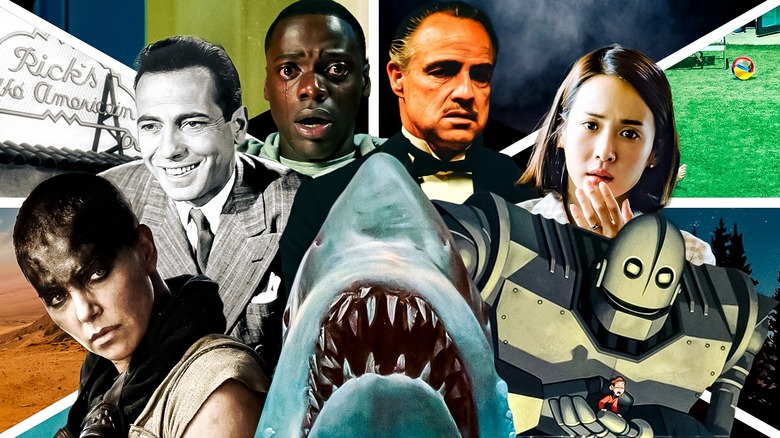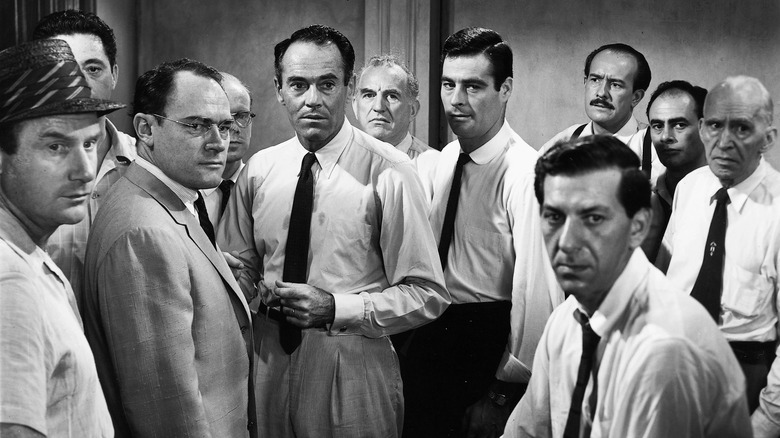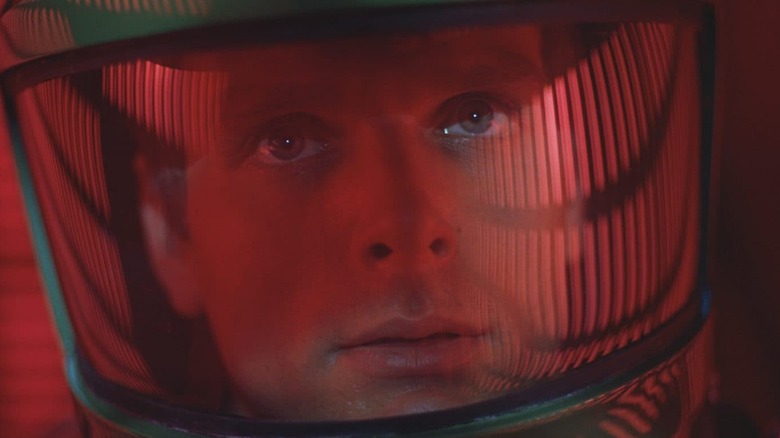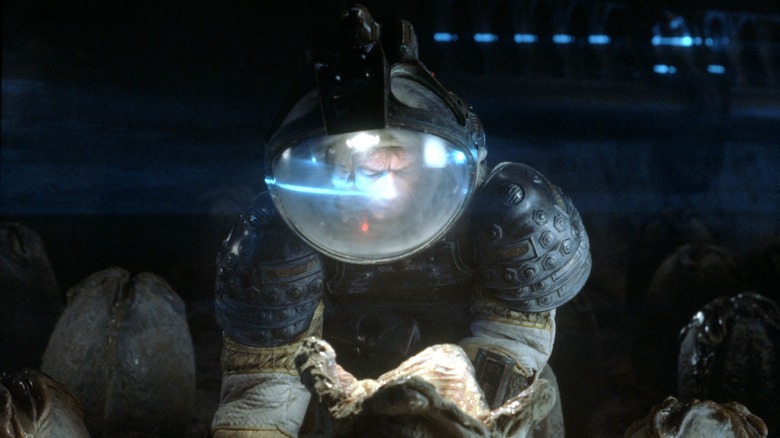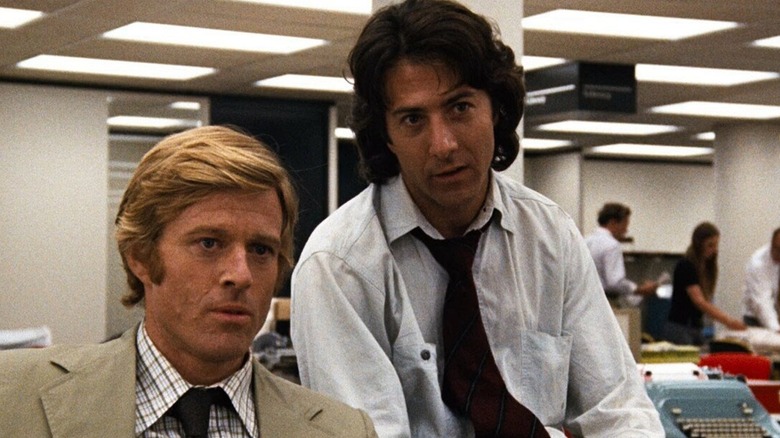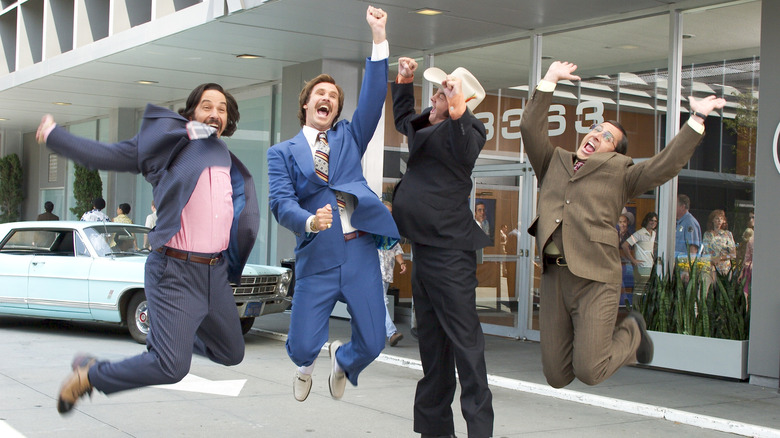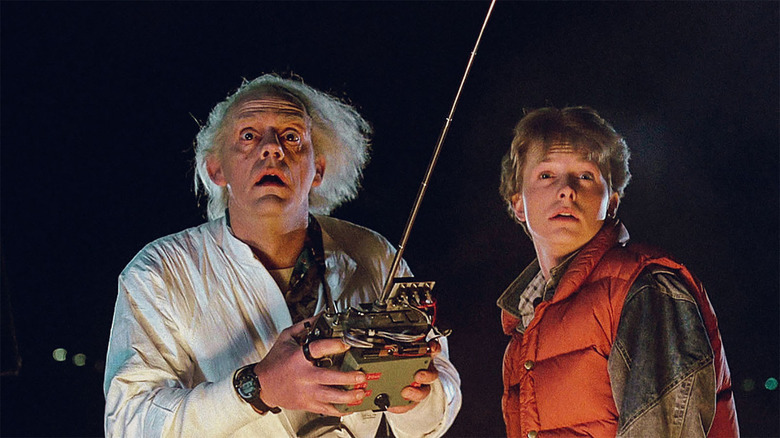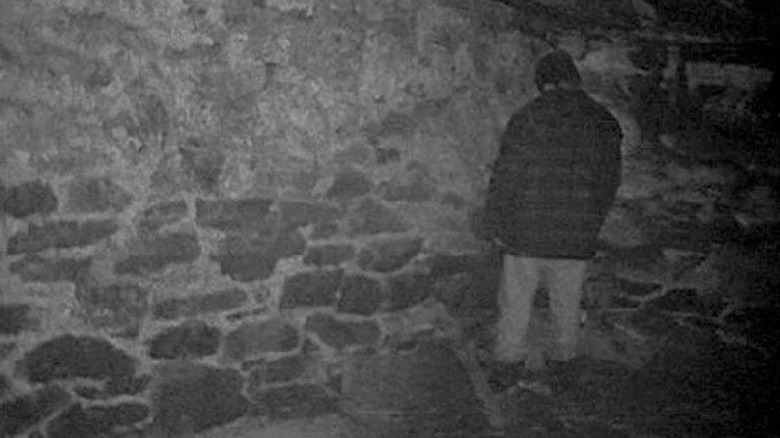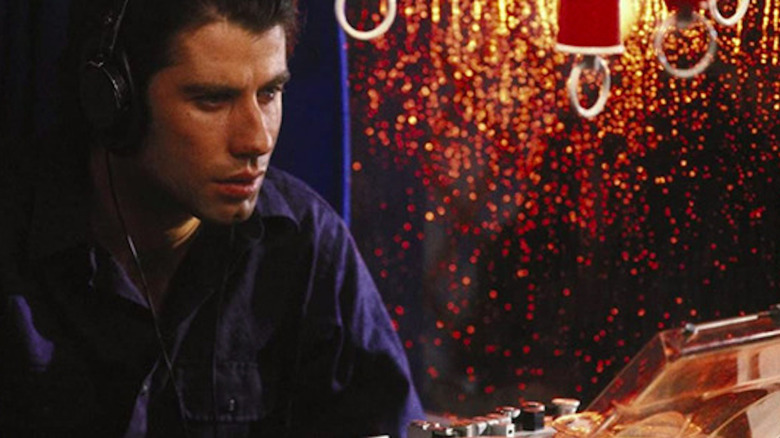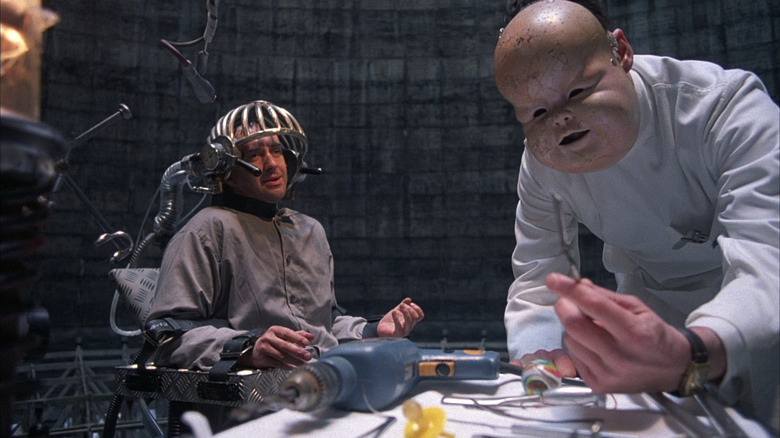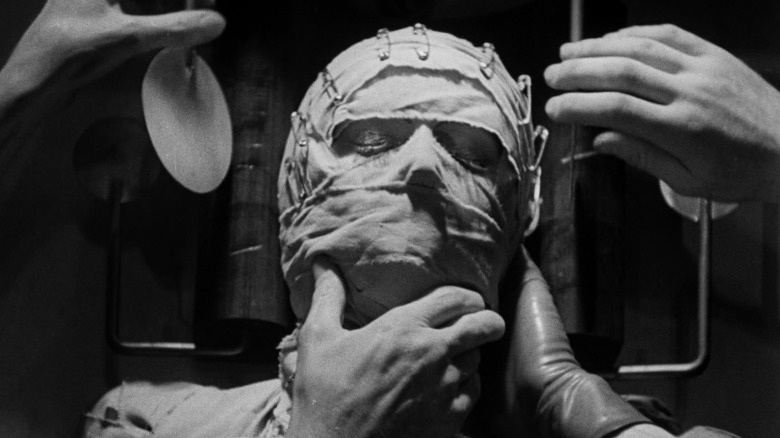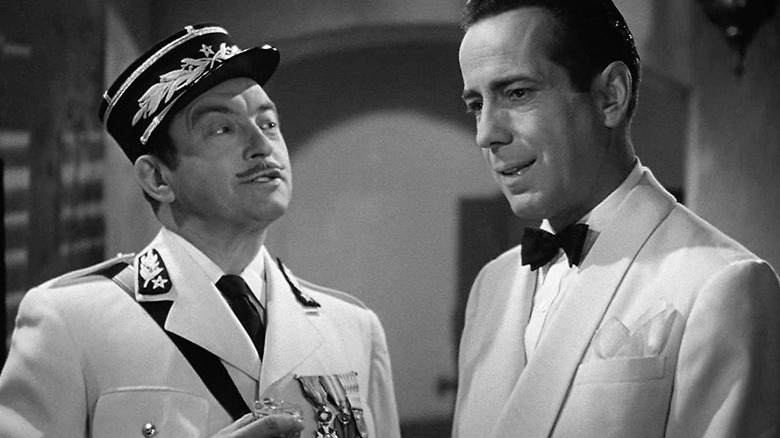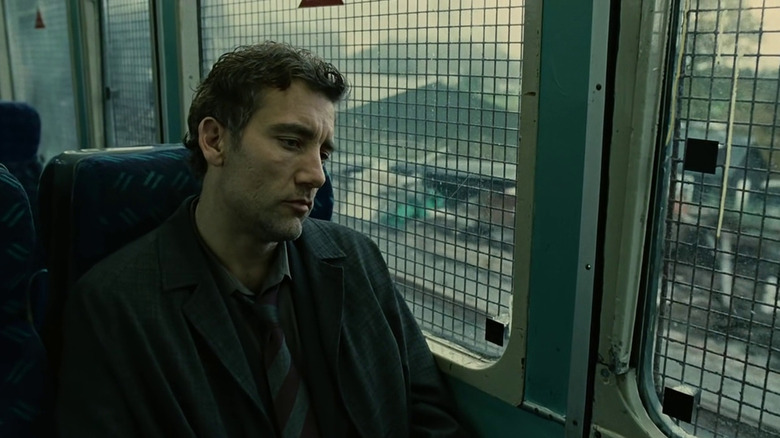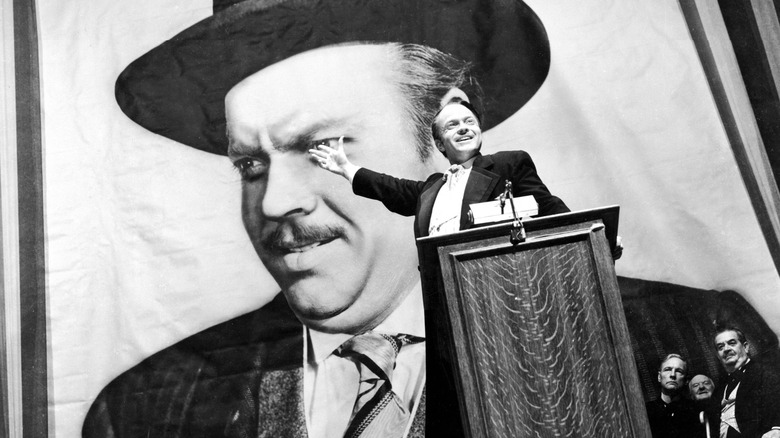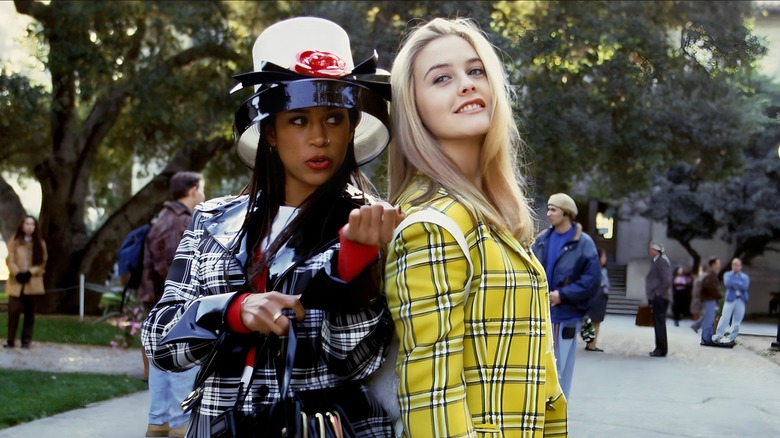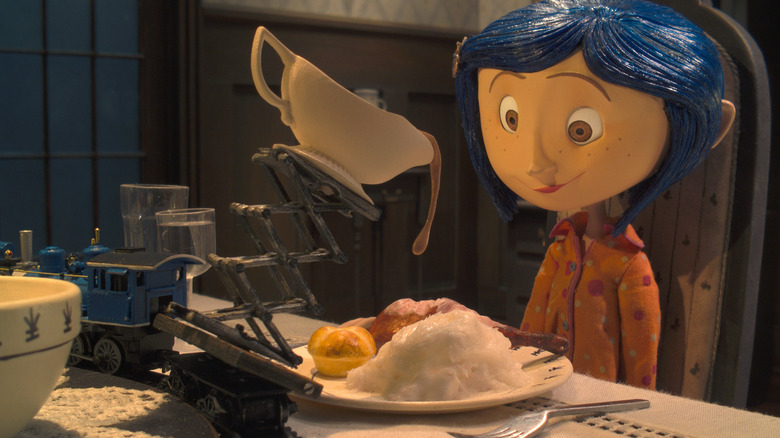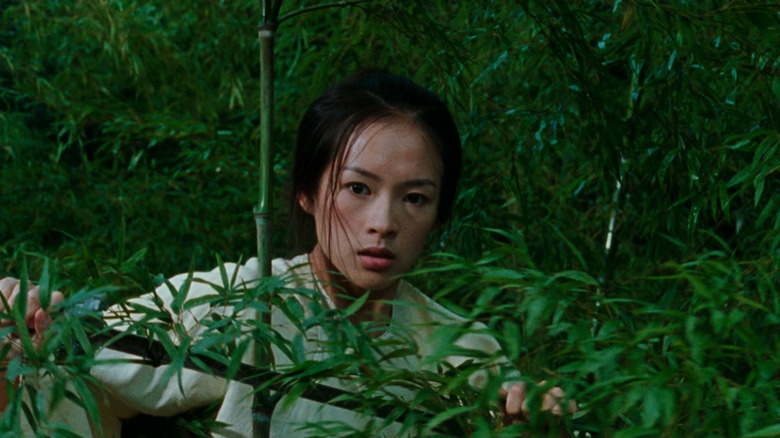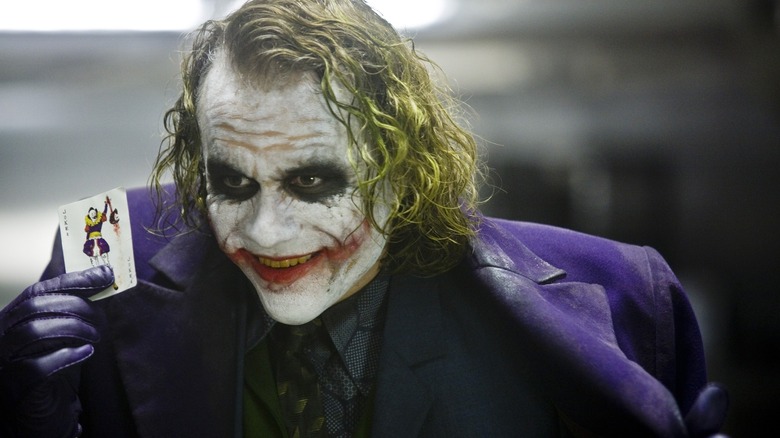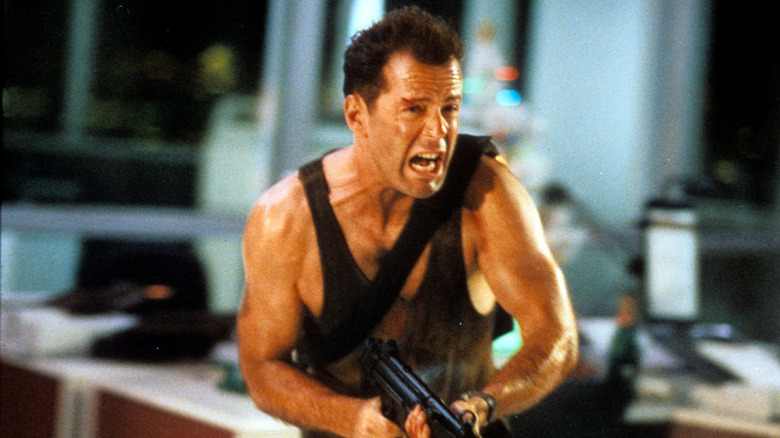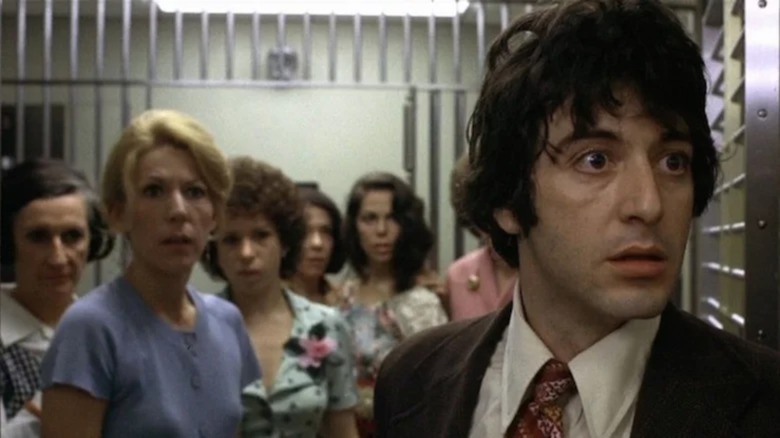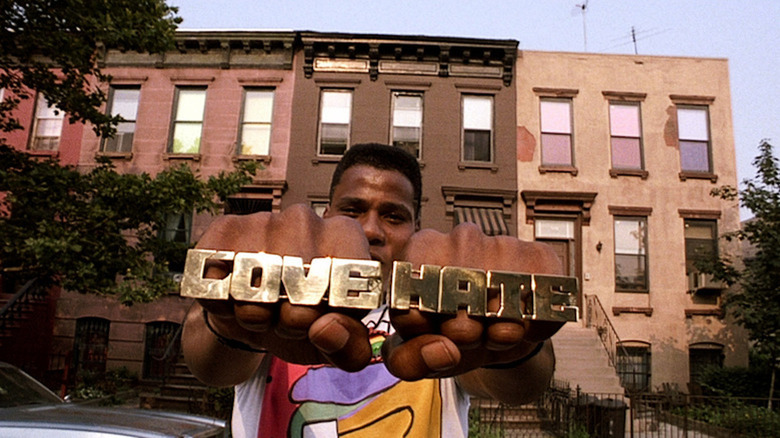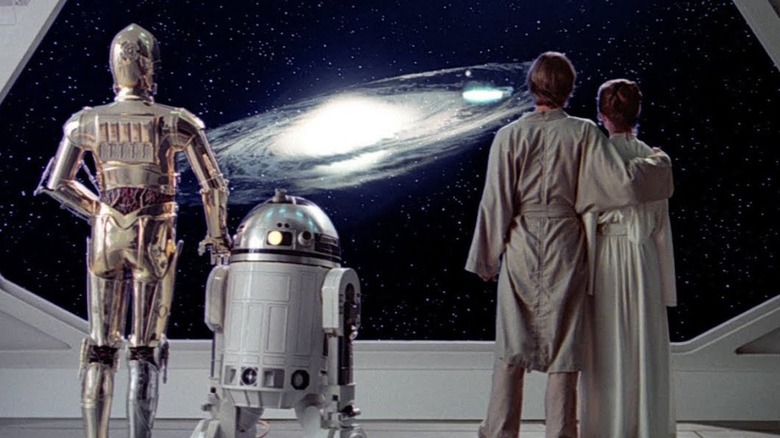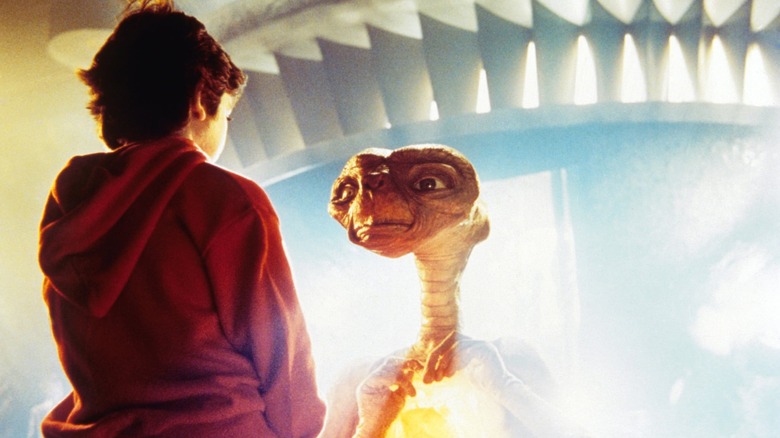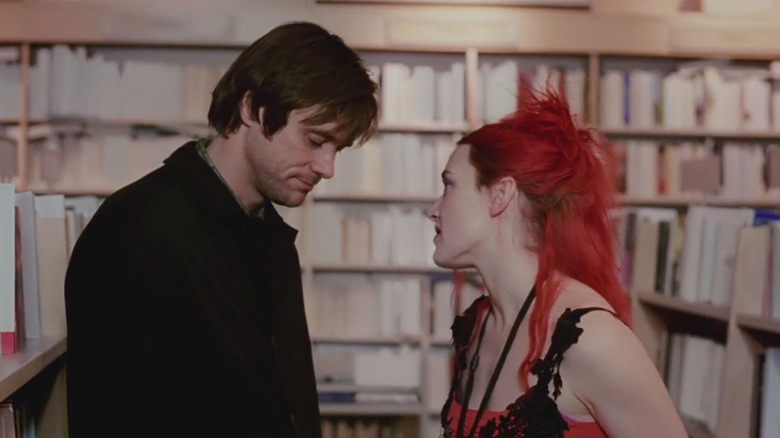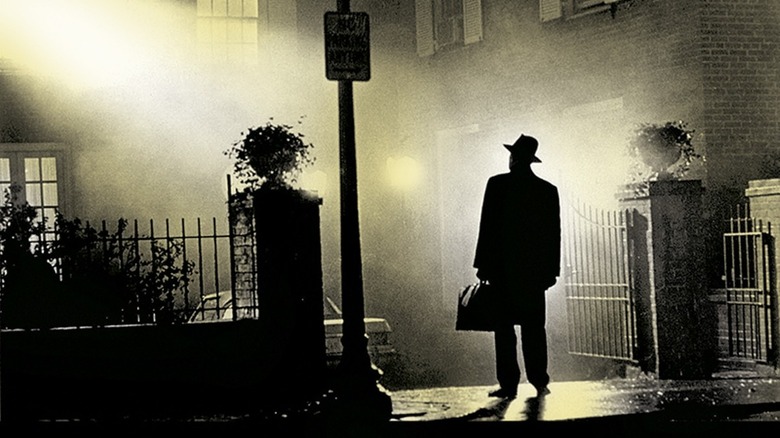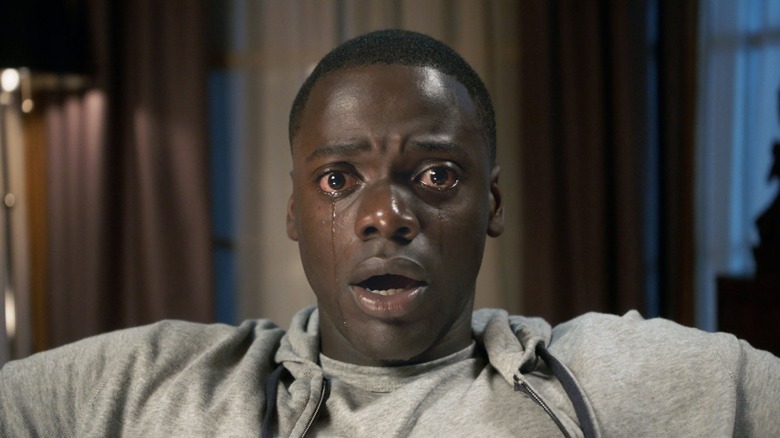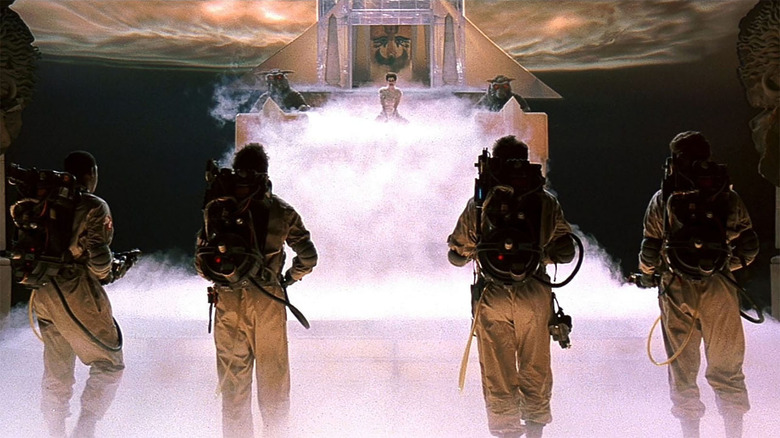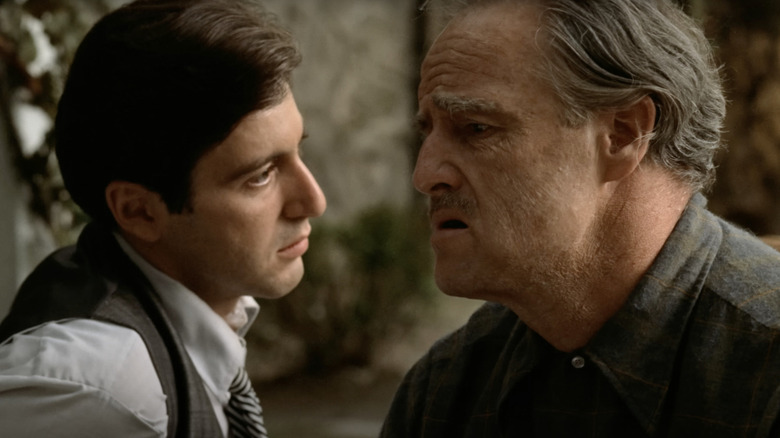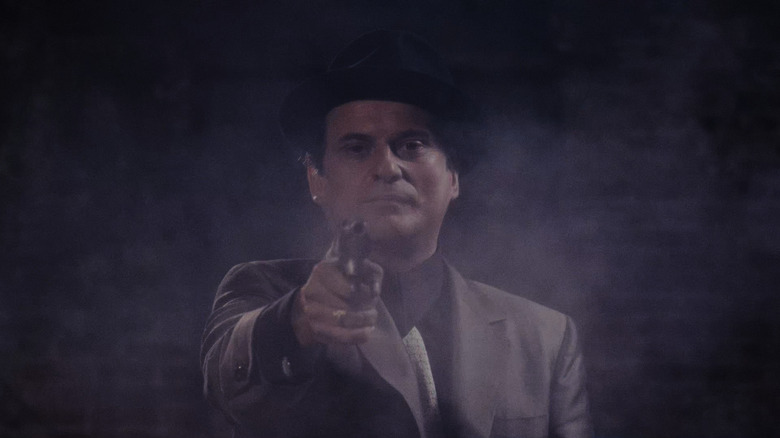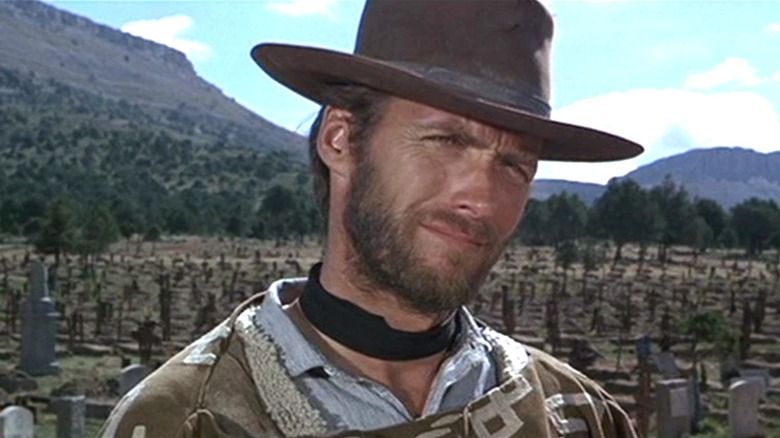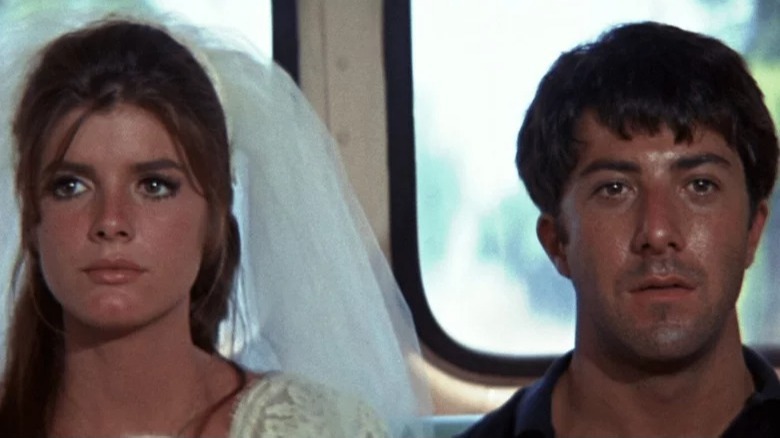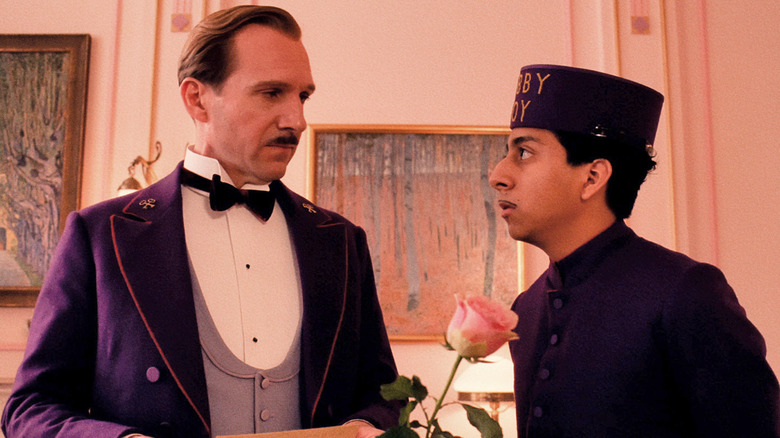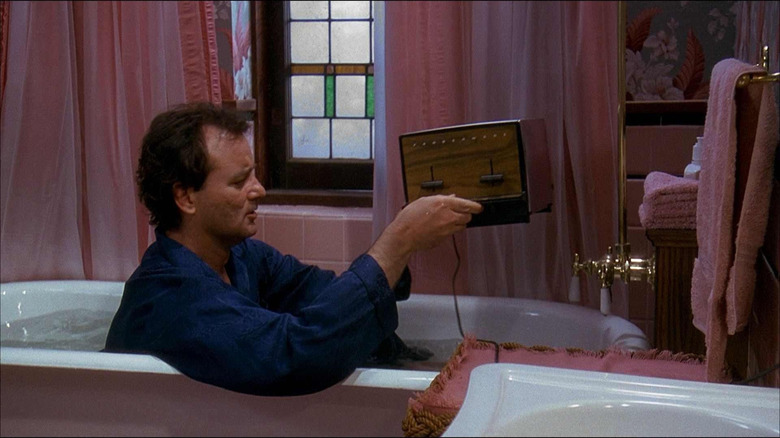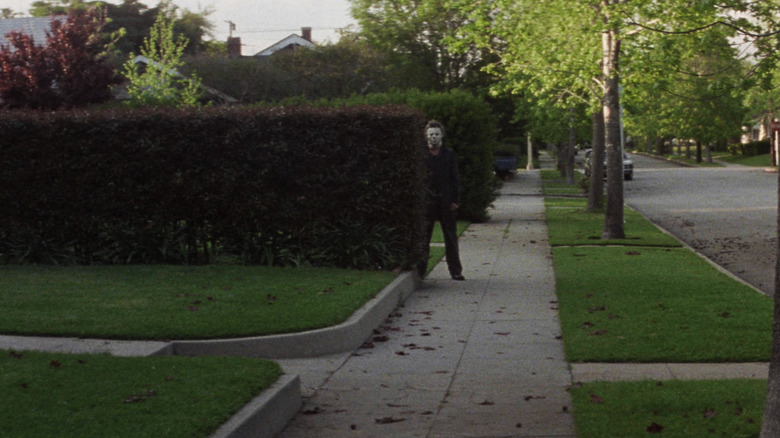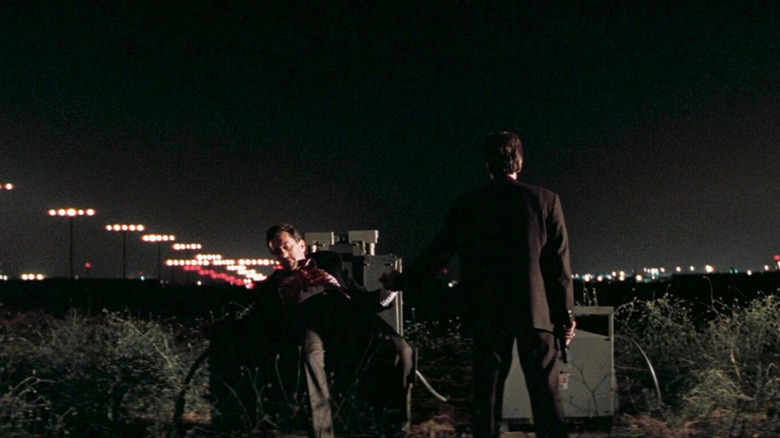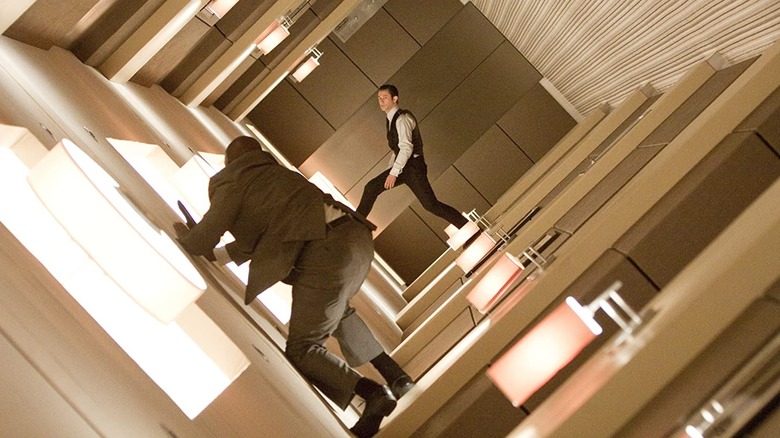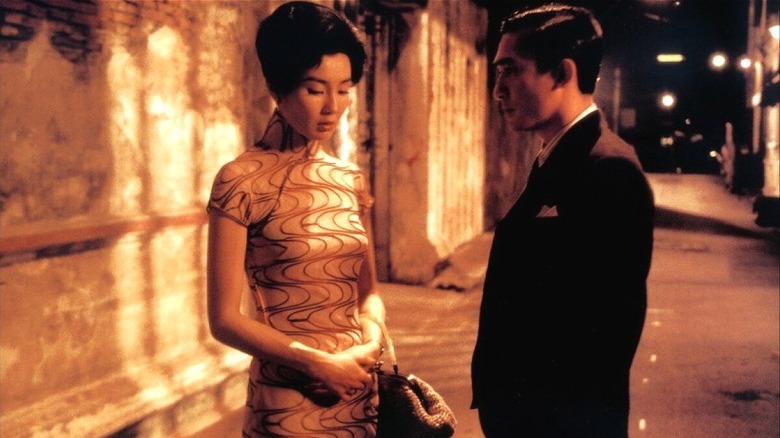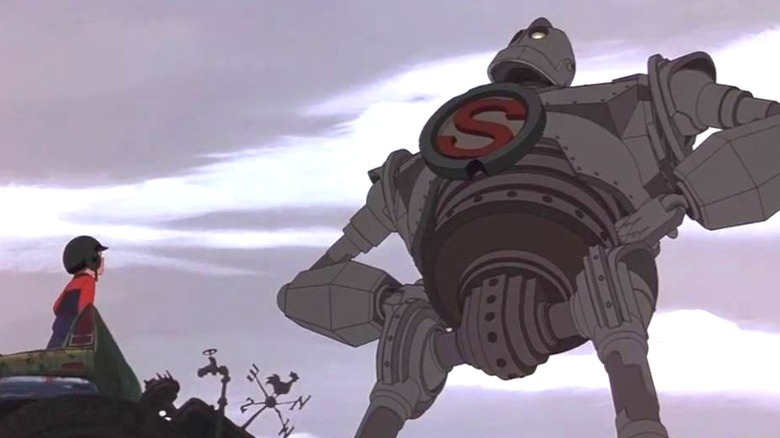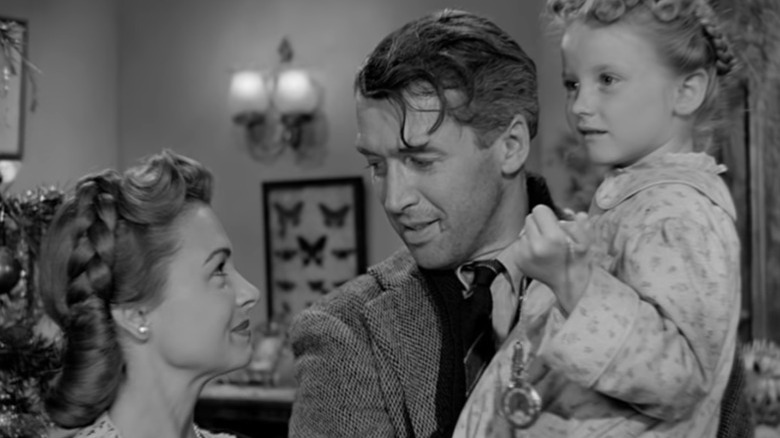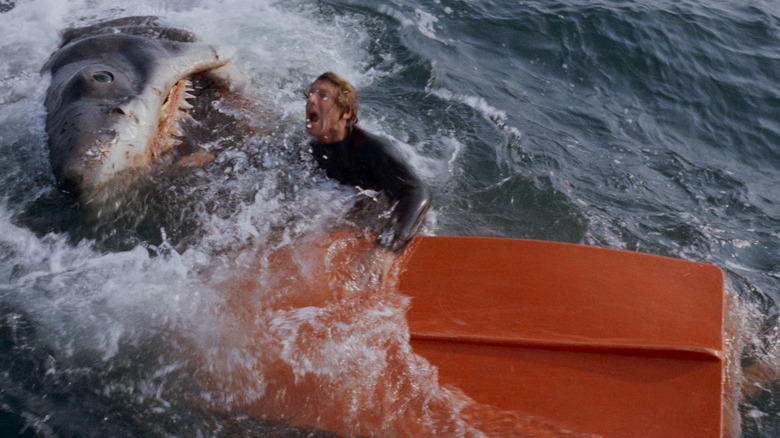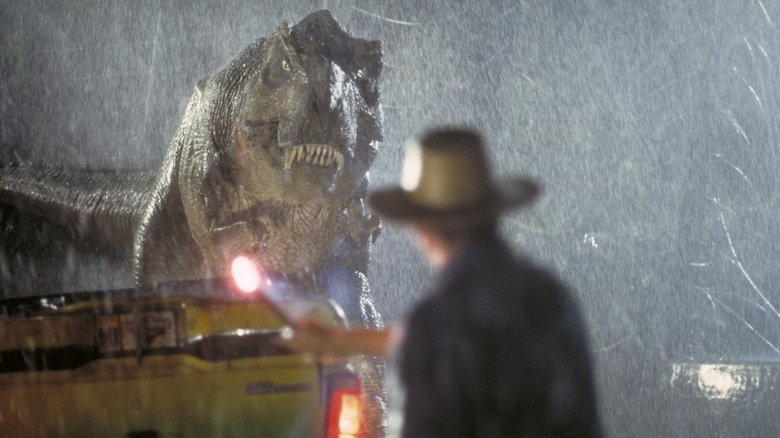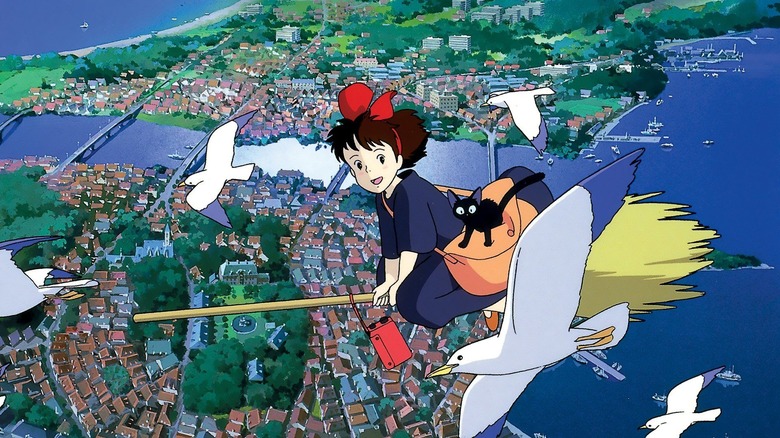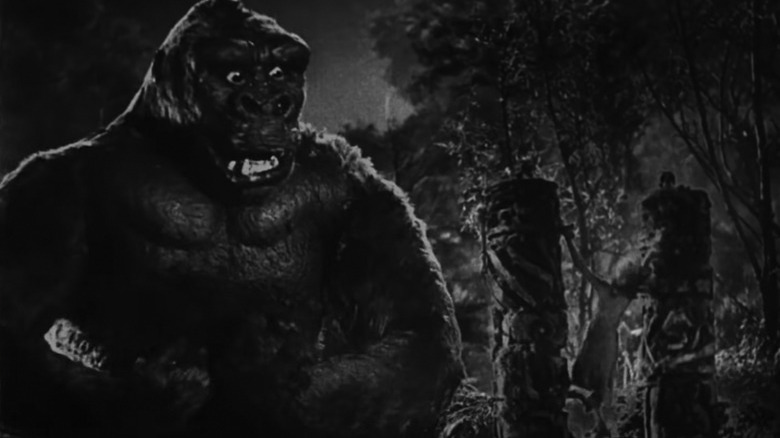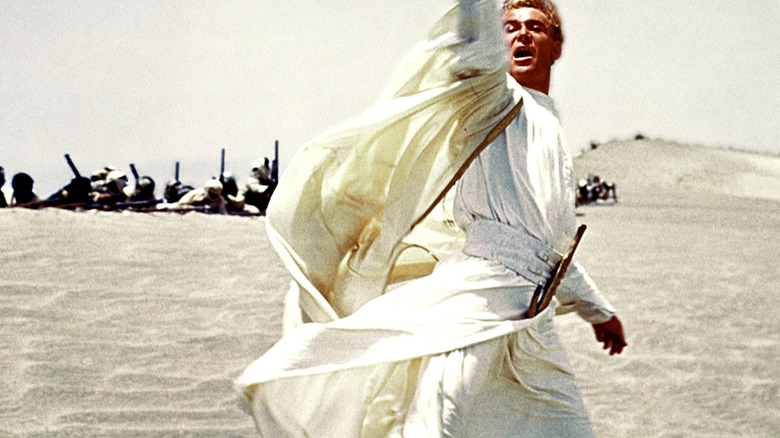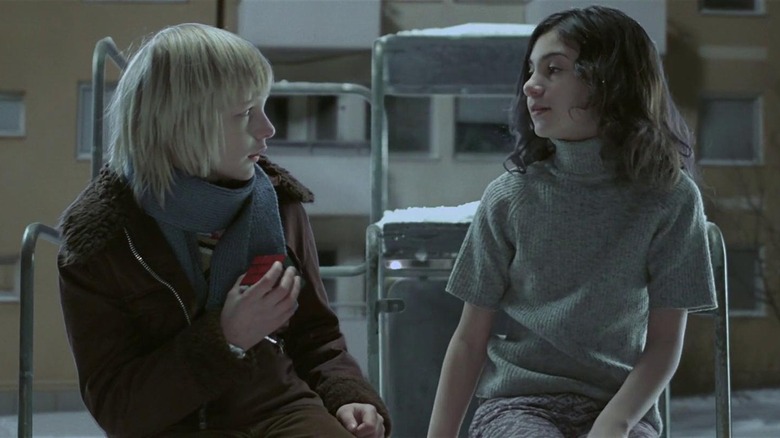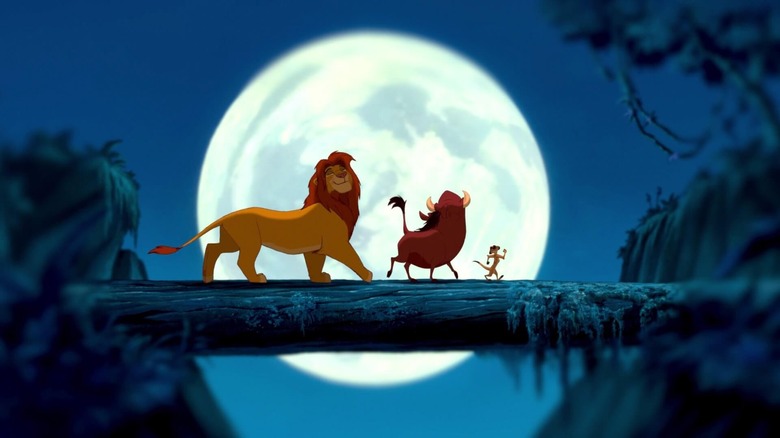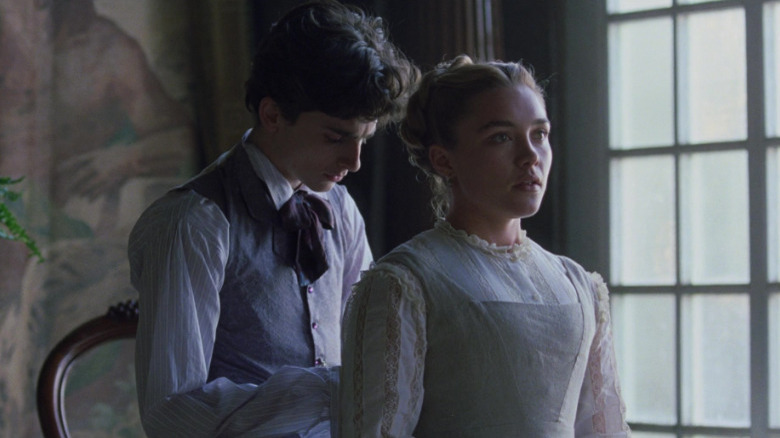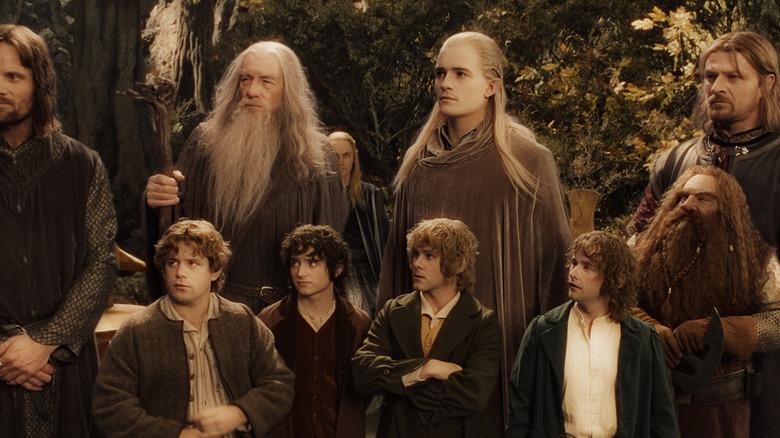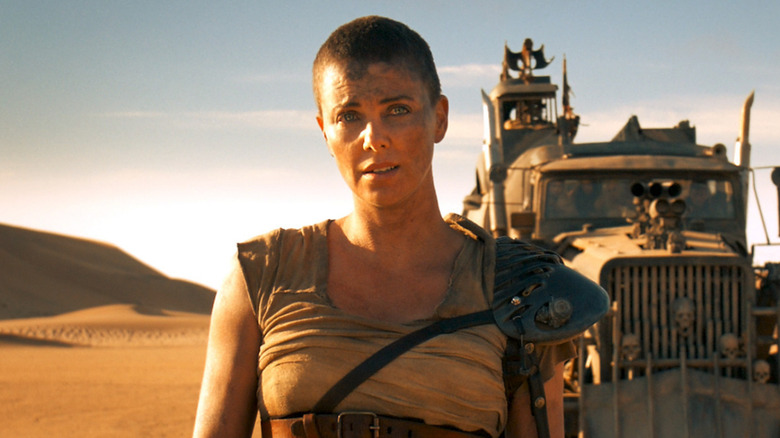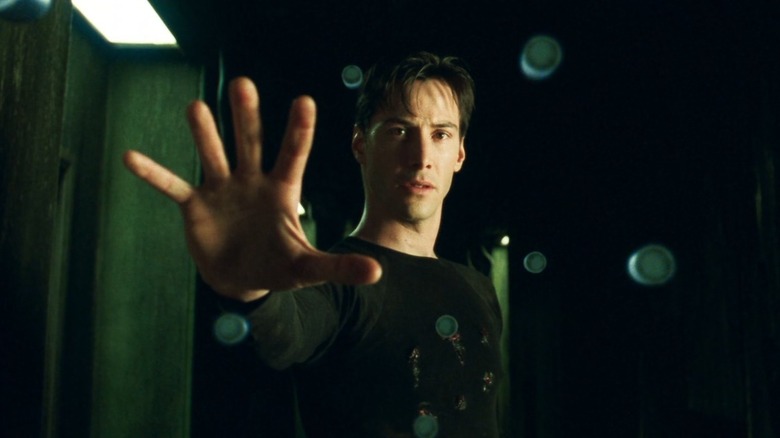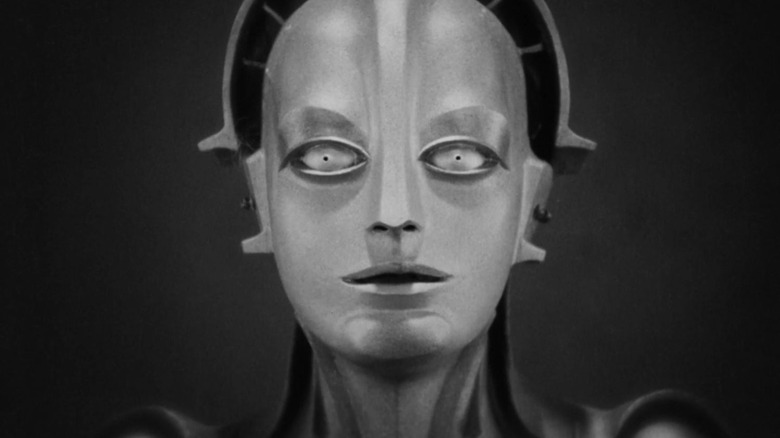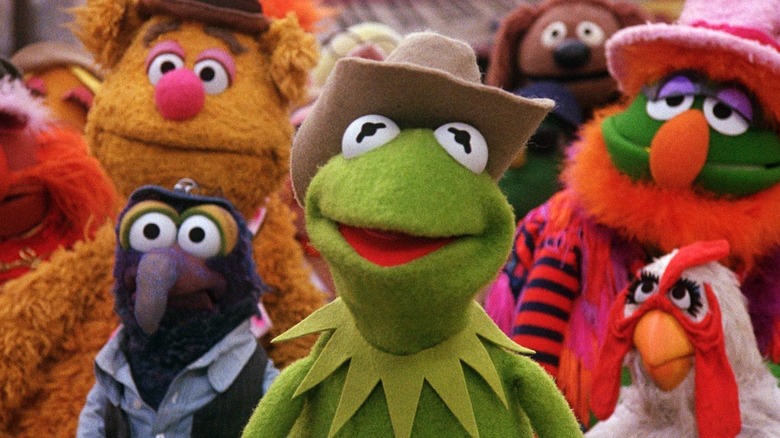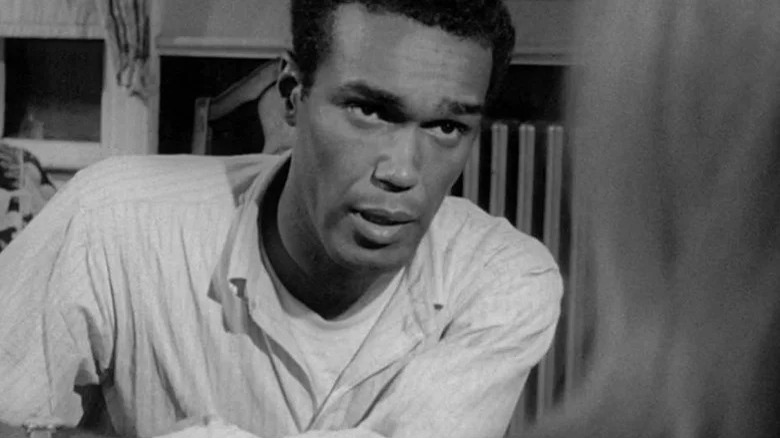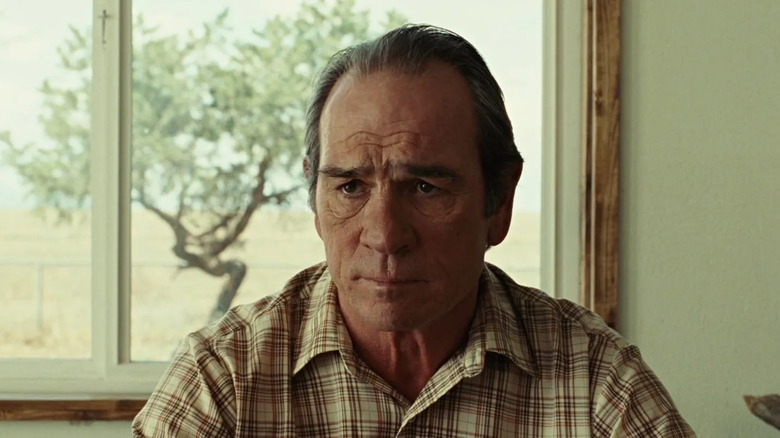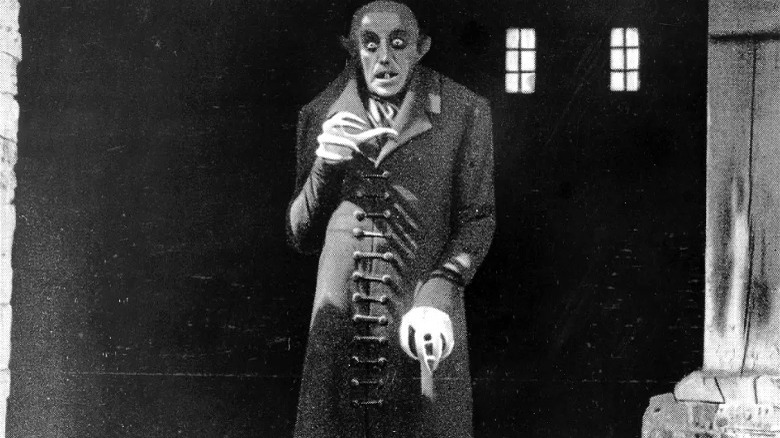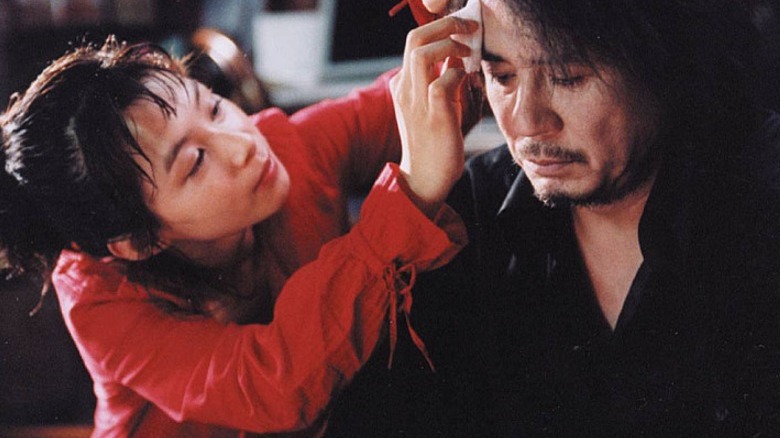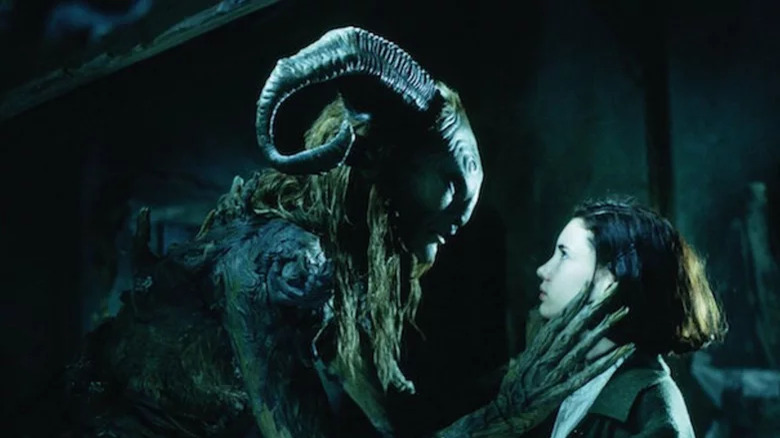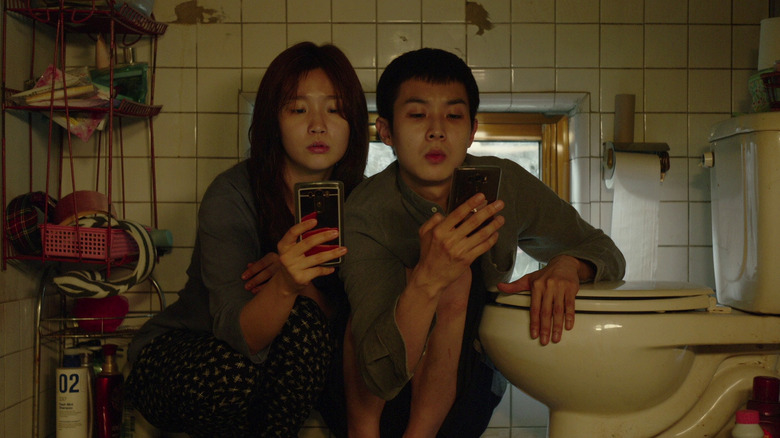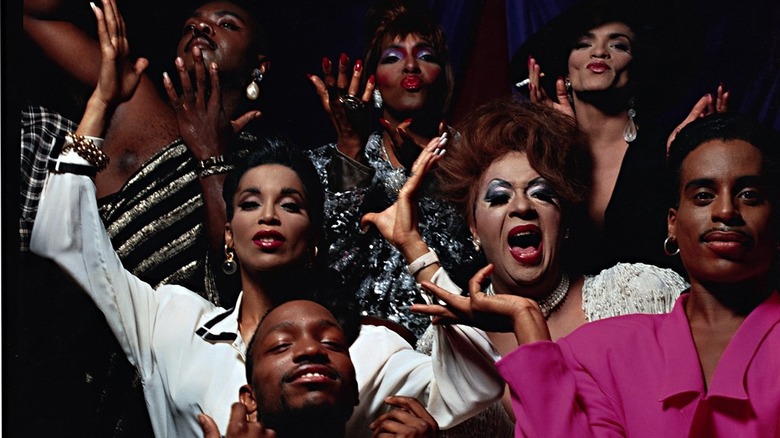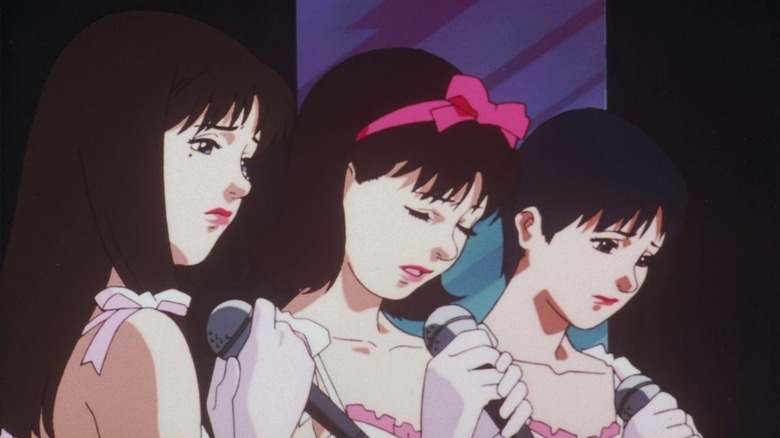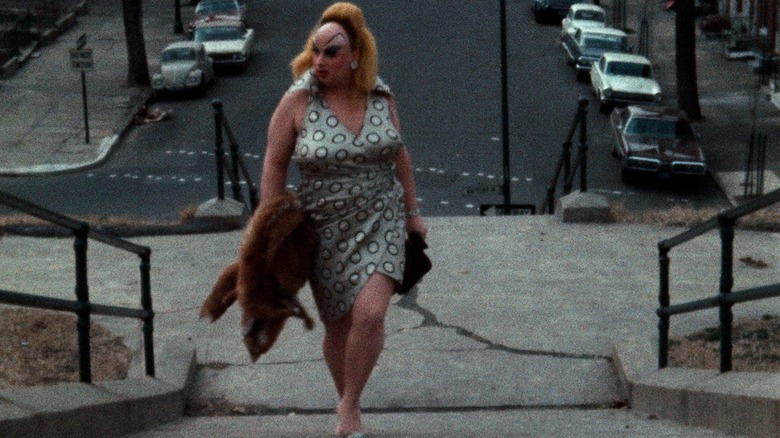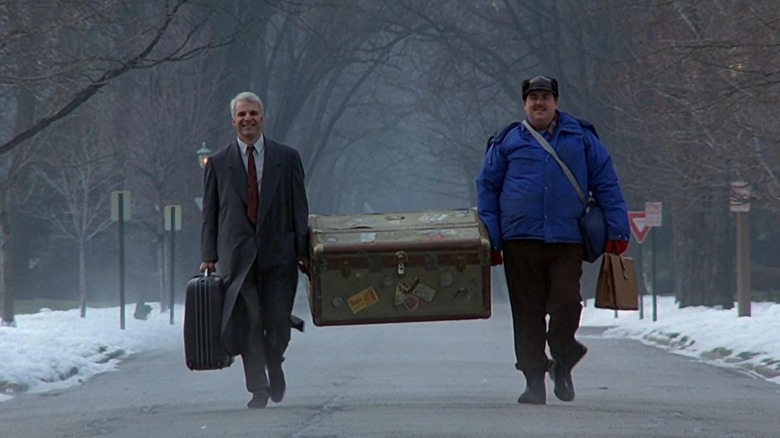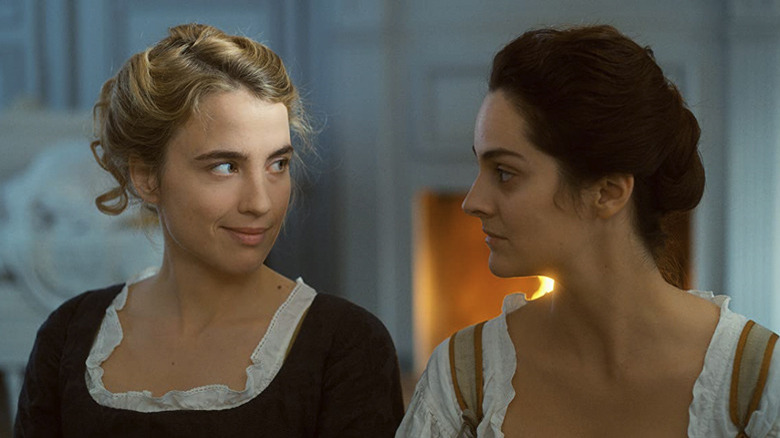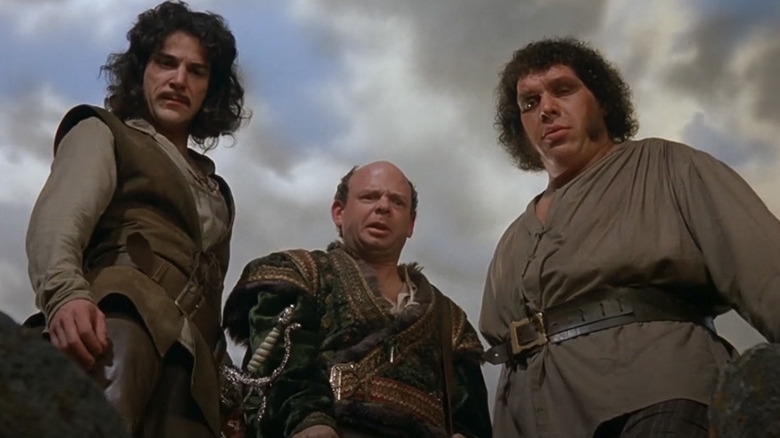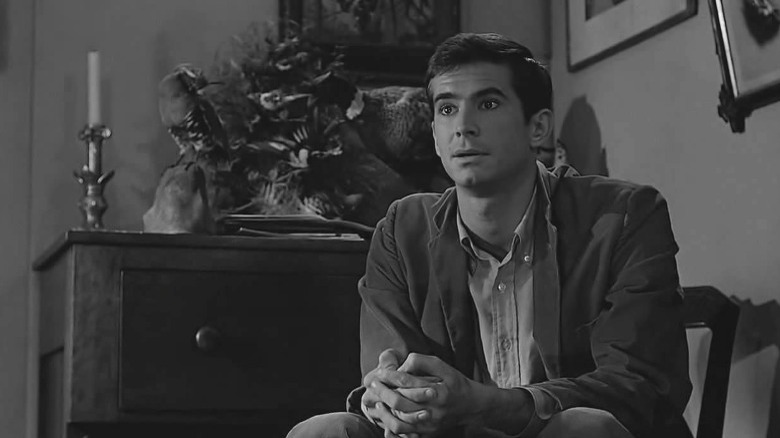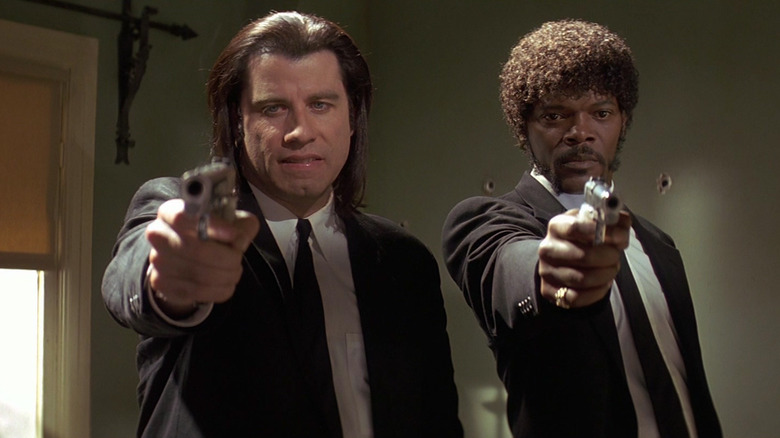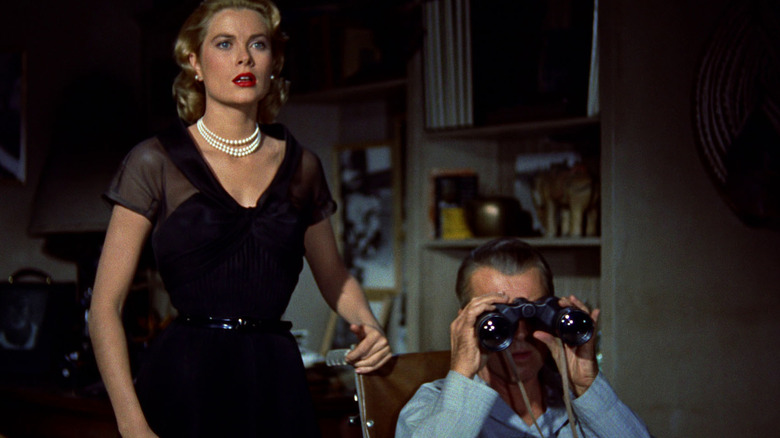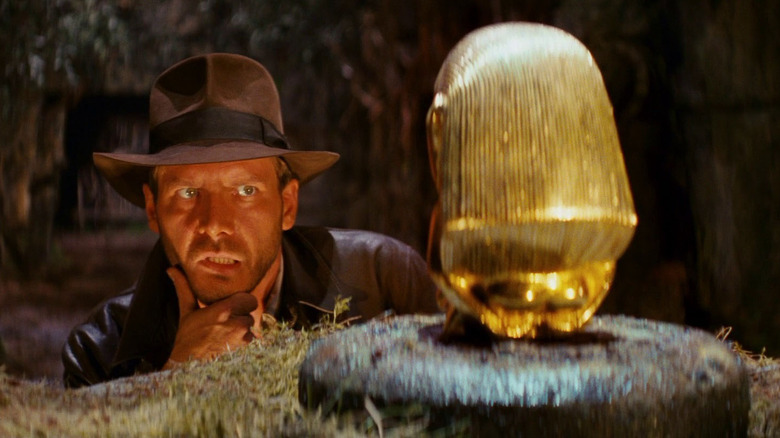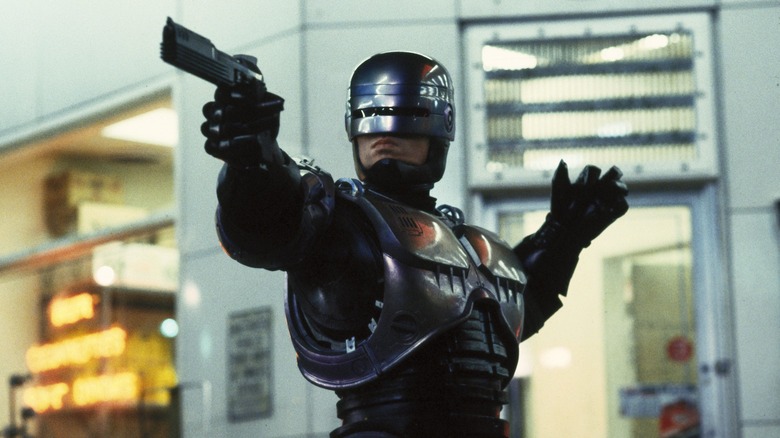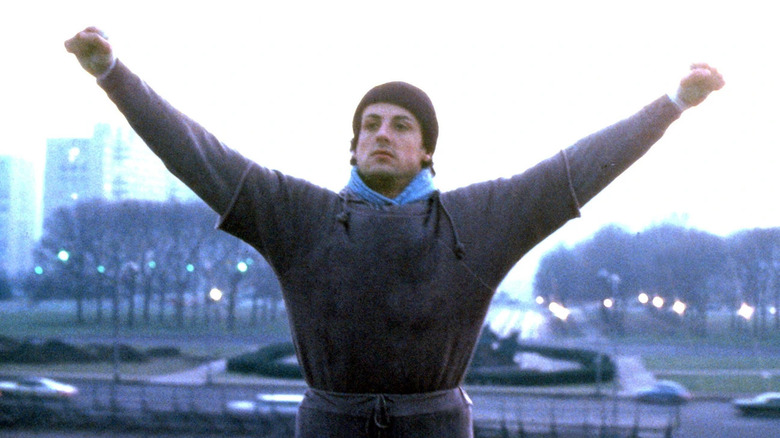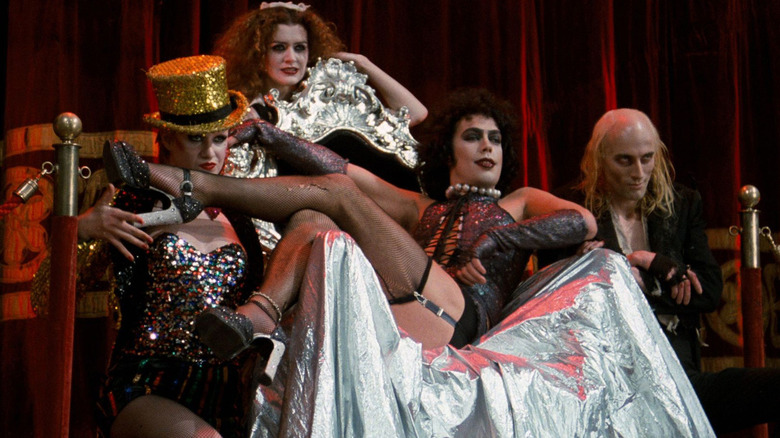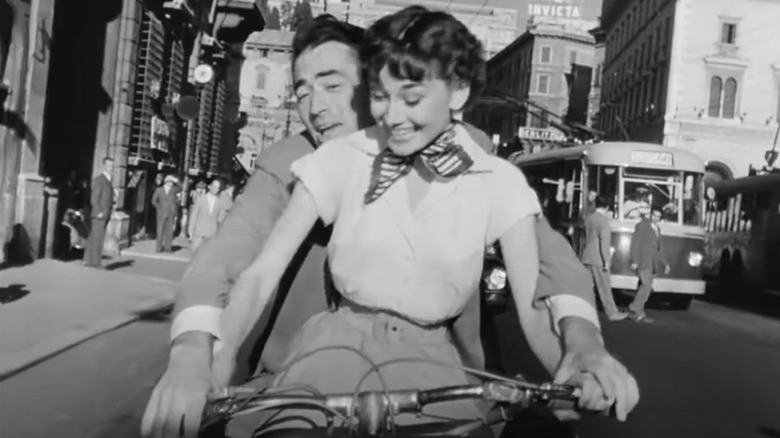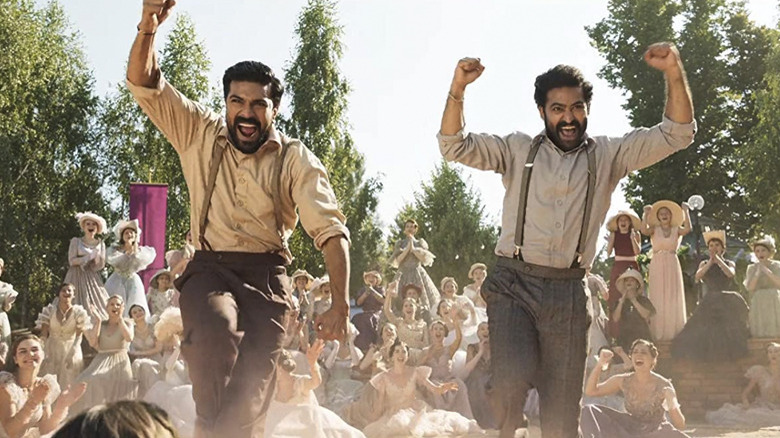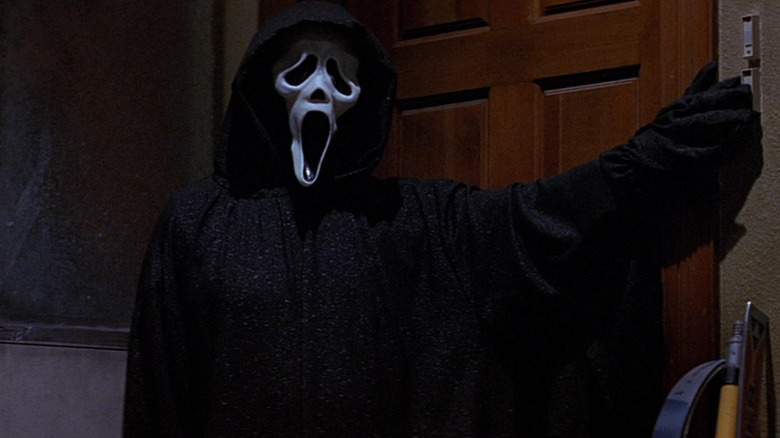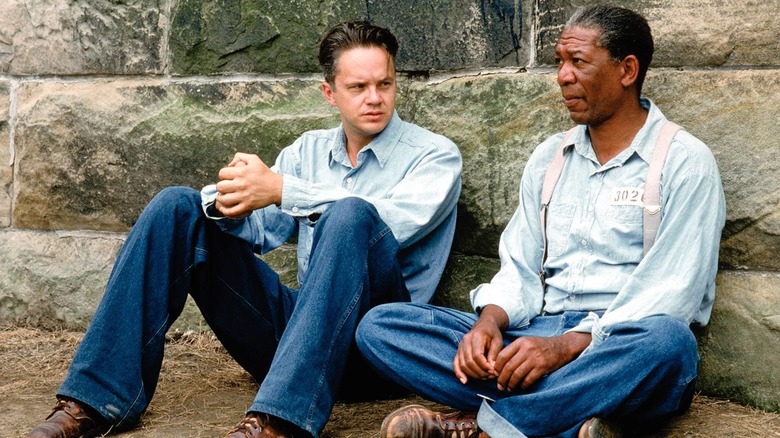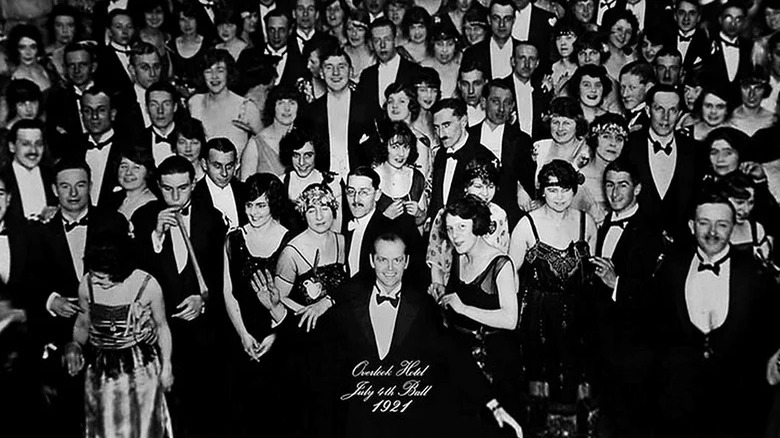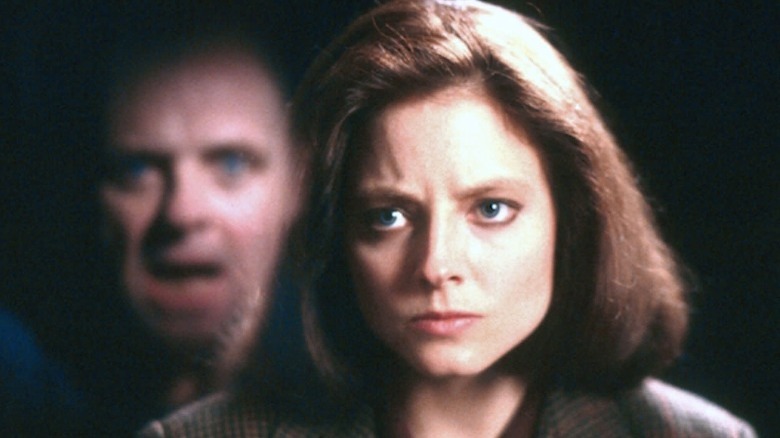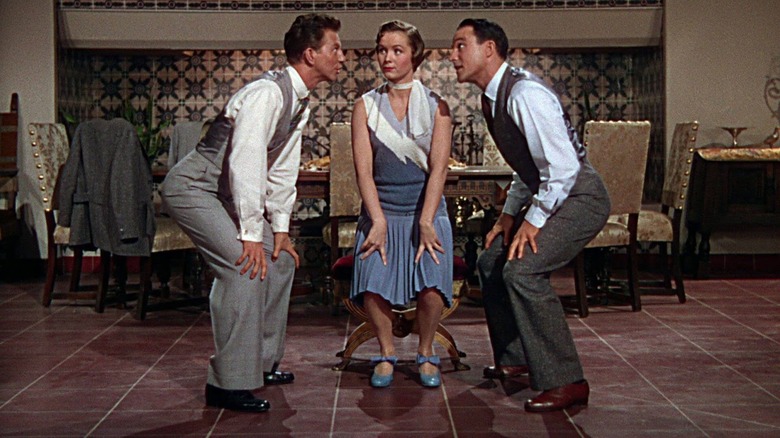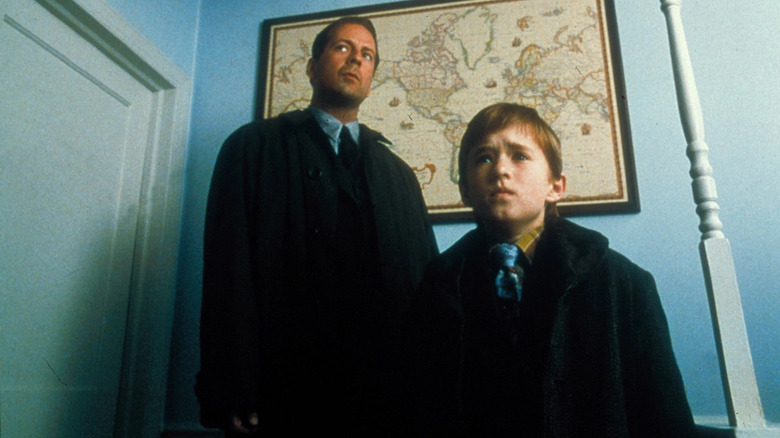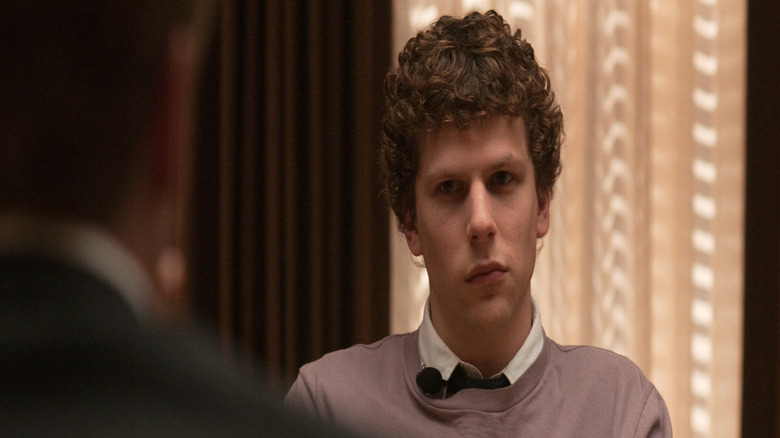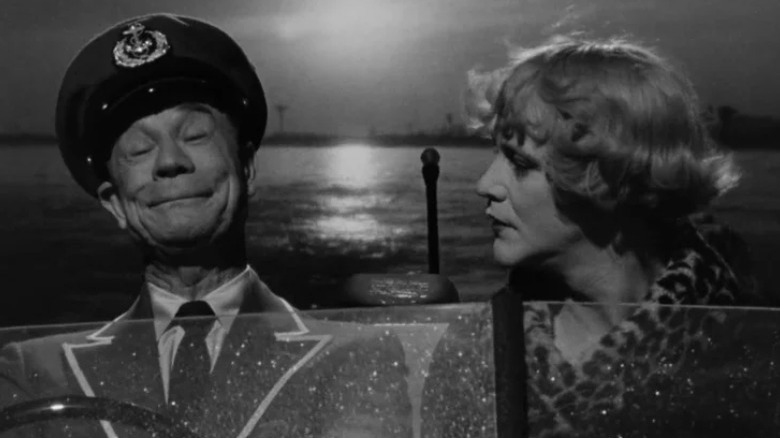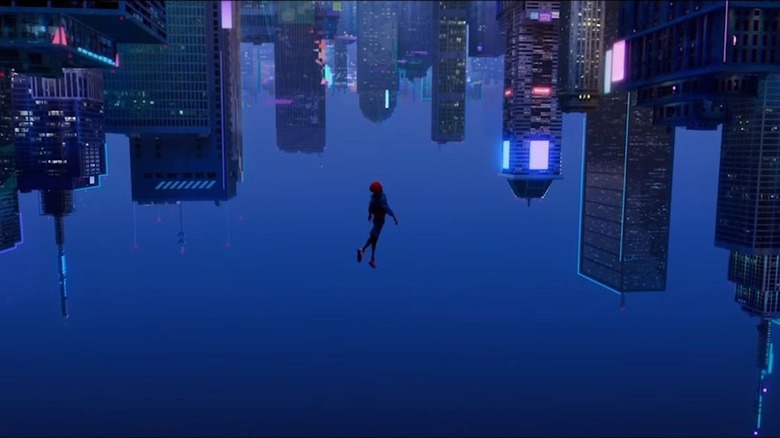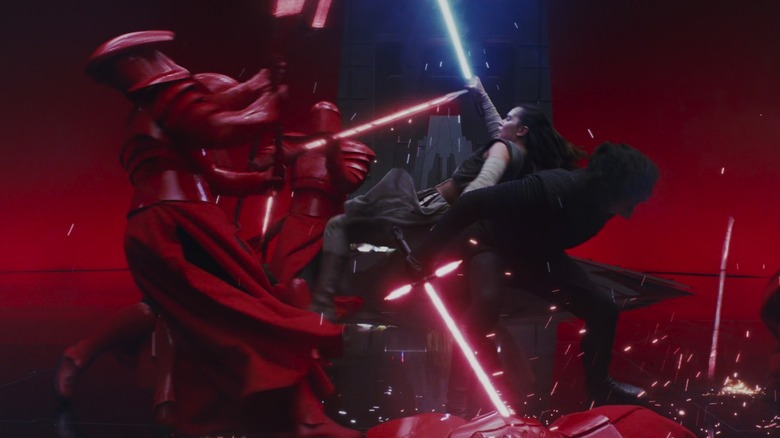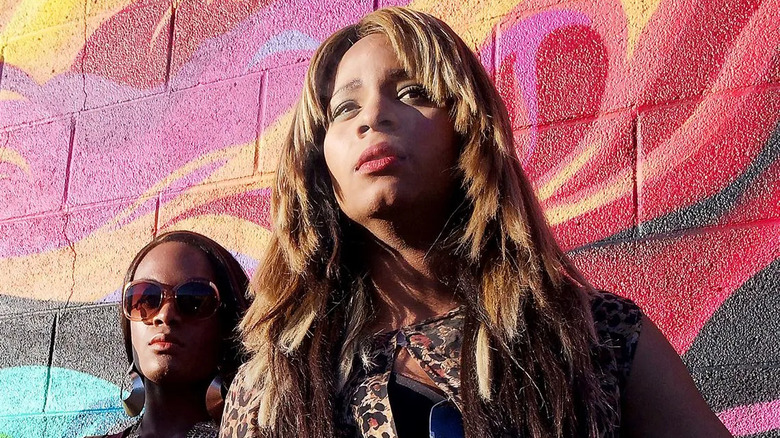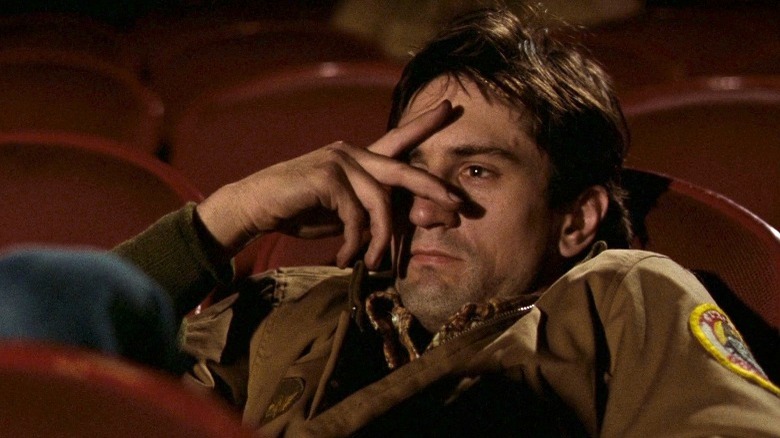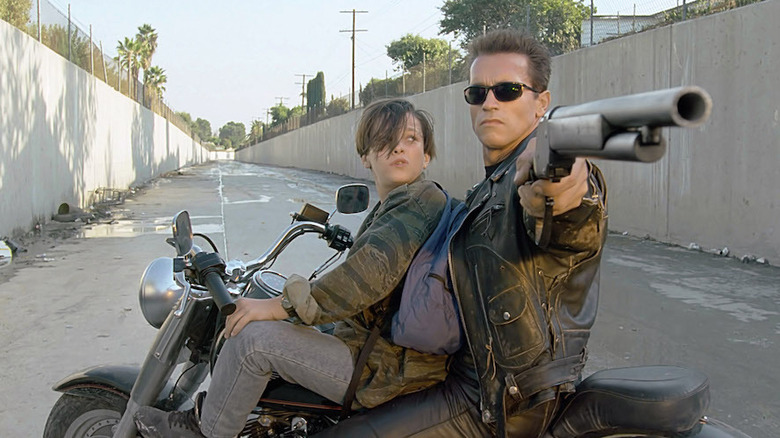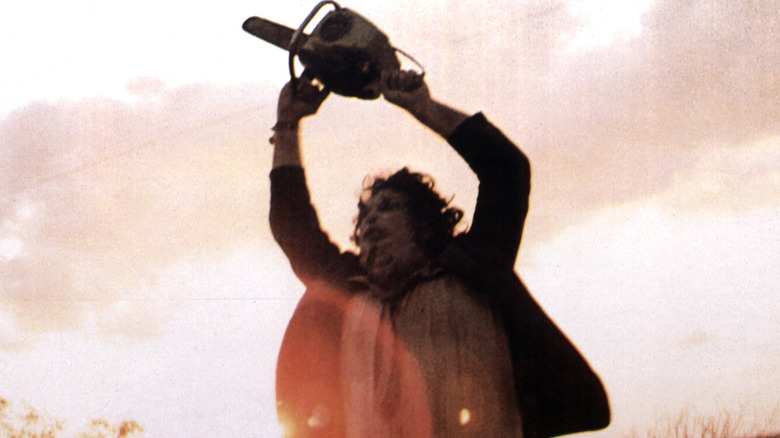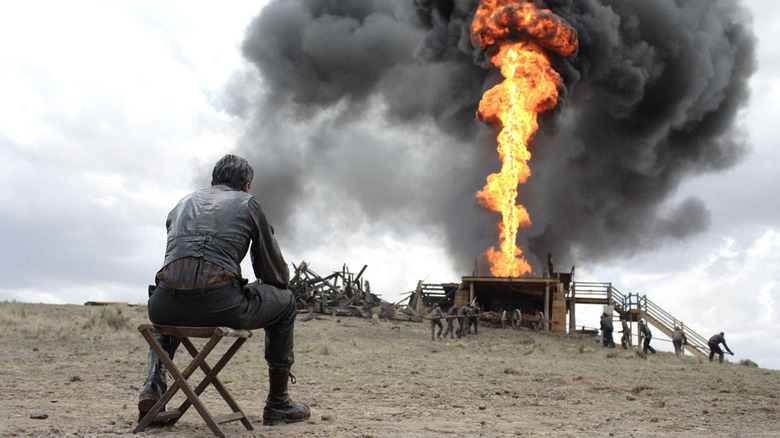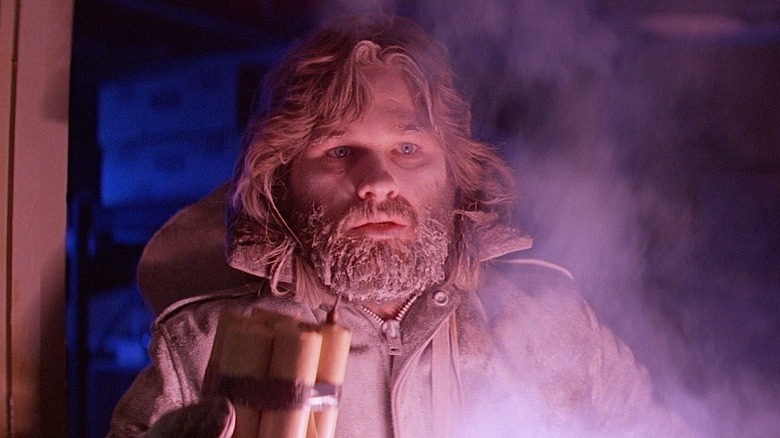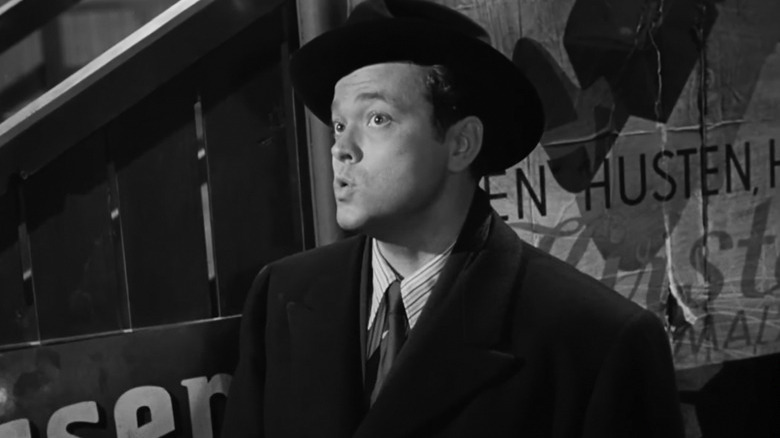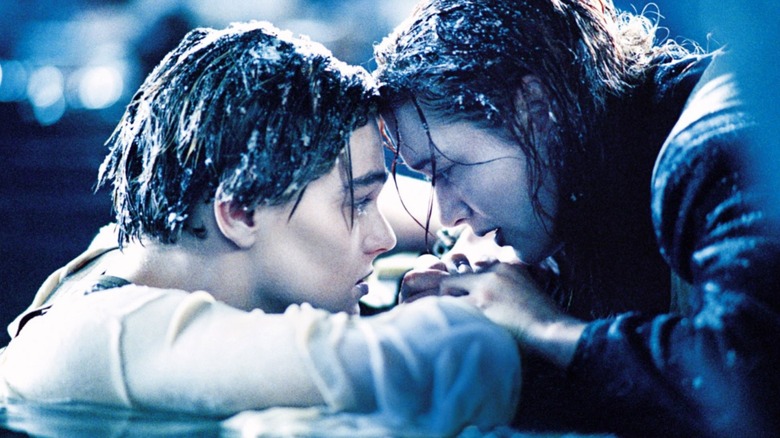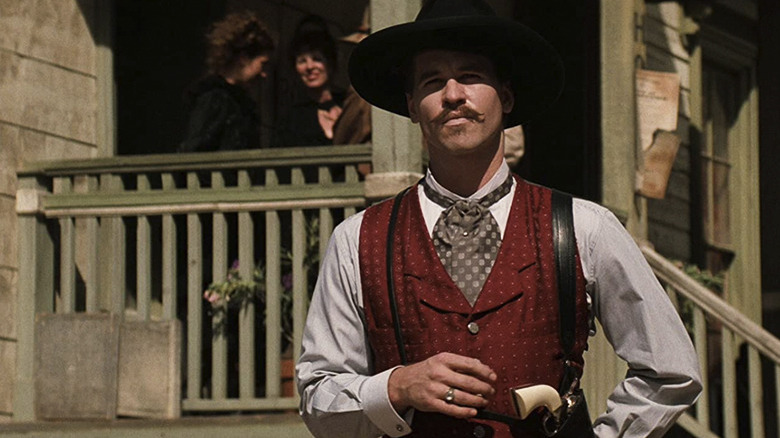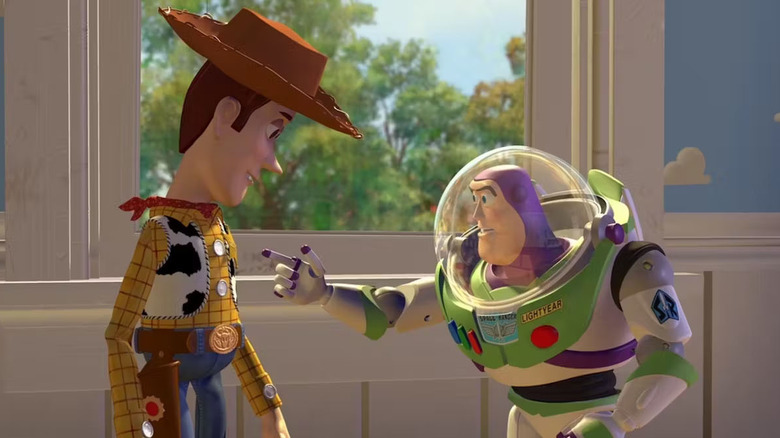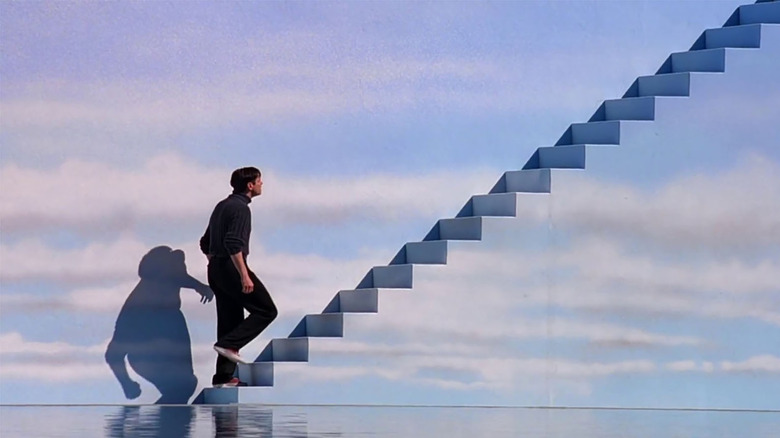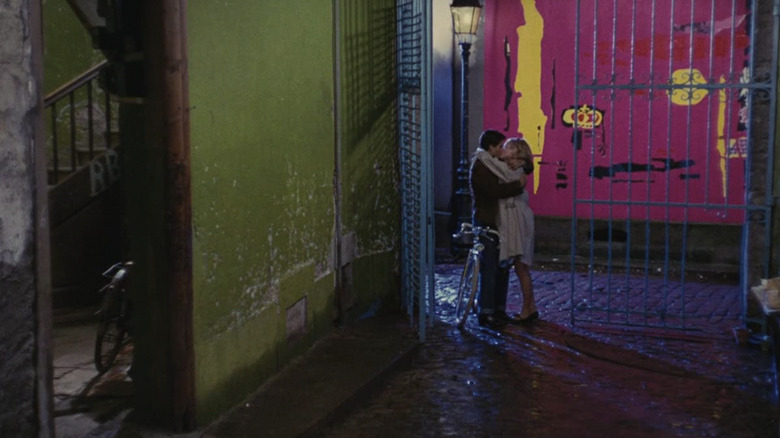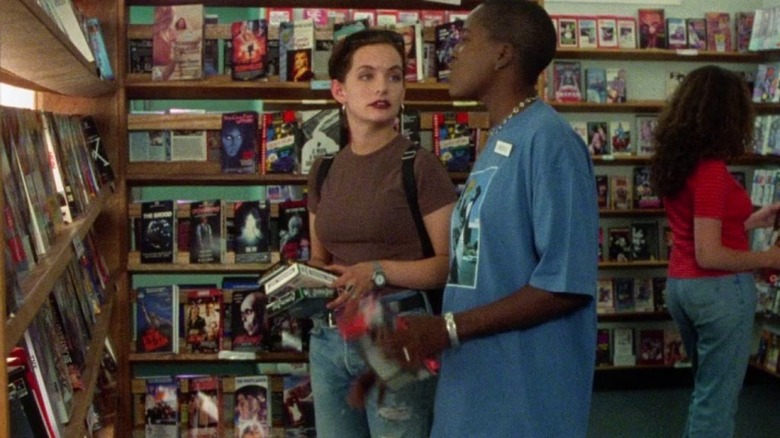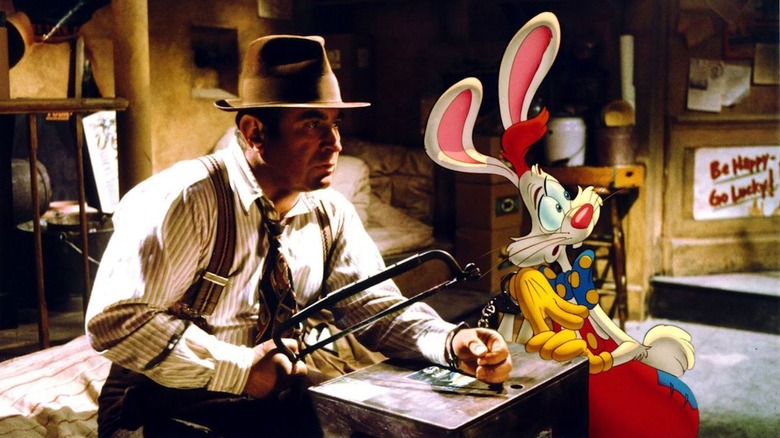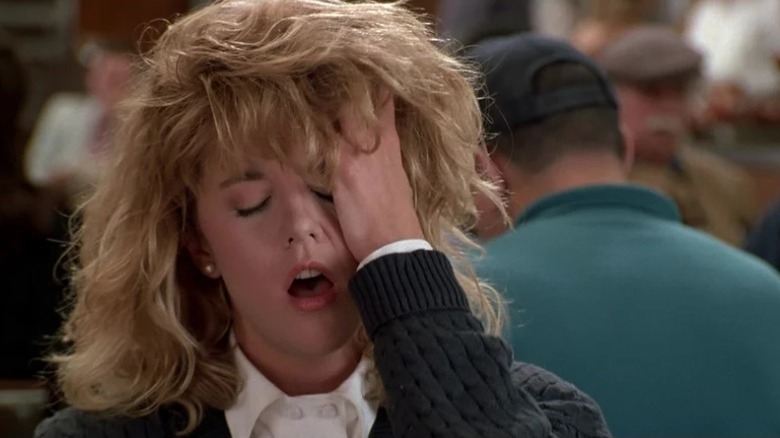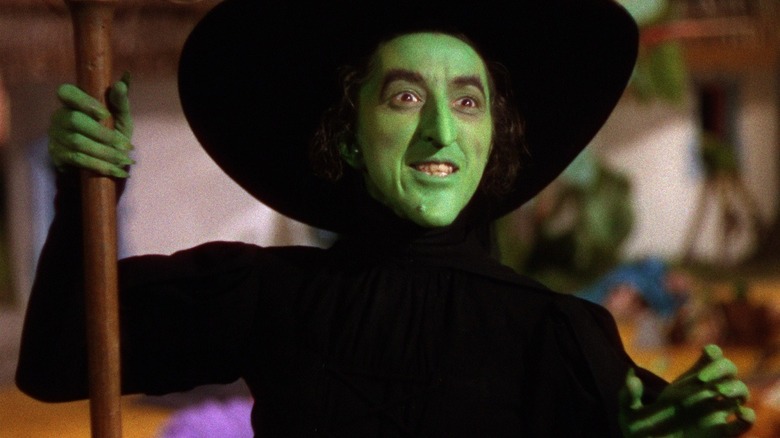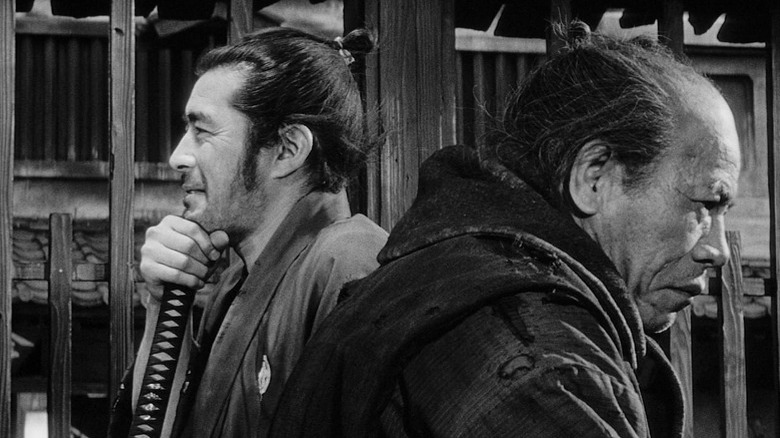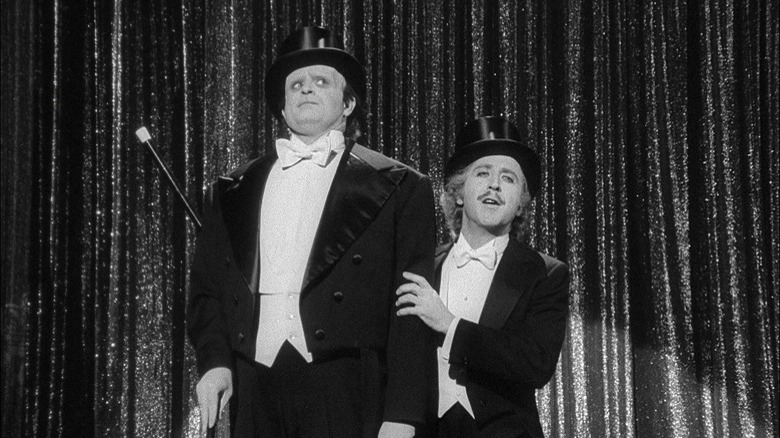/Film's Top 100 Movies Of All Time
Making a list of the 100 greatest movies of all time is the definition of "damned if you do, damned if you don't." You're always going to leave something off. It's never going to feel complete. A particular genre, era, or filmmaker will be neglected. People are going to be mad at you no matter what, so why do such a thing?
Well, why climb Mount Everest? Because it is there. Because we must.
This isn't your list of the 100 best movies ever made. This is /Film's list of the 100 best movies ever made, as voted by a selection of writers and editors, with the final list determined via several hours of impassioned arguments and debates (which we recorded and you can listen to here and here). Those who participated were given simple instructions: Nominated films needed to be movies they truly love. Established canon should be thrown to the wayside, and obliterated if necessary. The movies you expect to be on a list like this shouldn't just waltz right in. Select, you know, your actual favorite movies.
The result is a list that we think is as exciting as it is maddening, a list composed of old and new masterpieces alike. We're proud that it covers areas lists like this often neglect (animation and horror, baby!) and annoyed by what it sidesteps (yes, it does skew a bit too Hollywood, we know). But one thing remains true above all else: This list was made honestly, and every movie on it is one the /Film team considers vital.
And now, in alphabetical order, here are the 100 best movies ever made. According to us. Your favorite movie is number 101. We promise.
12 Angry Men (1957)
Taking place essentially in real time, almost entirely in one room, and with a cast of characters who are almost all unnamed except for their juror numbers, Sidney Lumet's "12 Angry Men" is a masterclass in the push and pull of dialogue. As the jury gathers to convict an accused teenage murderer in what seems like an open-and-shut case, Henry Fonda's lone holdout — Juror #8 — suggests that they simply take an hour to talk things out. Tensions rise, prejudices are revealed, and human nature itself is put on trial. "12 Angry Men" is as gripping as any action film, set in an arena where words are the weapons that make the difference between life and death.
It's also a film that has only grown more relevant with time — particularly now, when opinion seems so deeply divided and factional that good faith debate seems impossible, and people changing their minds even more so. "12 Angry Men" delves deep into how opinions are formed, whether it's simply by following the crowd, or innermost resentments rising to the surface. And though the crime in question can't be solved in a jury room, there's a tinge of murder mystery to it that draws the viewer in, inviting them to become a thirteenth angry man.
The Alternate Take: In 2022, Sarah Polley delivered an answer to "12 Angry Men" with "Women Talking," the story of a group of Mennonite women who have only a day to resolve through the debate about what they should do in response to their colony's serial sexual assaults: do nothing, stay and fight, or leave. (Hannah Shaw-Williams)
2001: A Space Odyssey (1968)
In his wry 1978 sci-fi comedy novel, author Douglas Adams tried to communicate the infinity of the cosmos: "Space is big. You just won't believe how vastly, hugely, mind-bogglingly big it is. I mean, you may think it's a long way down the road to the chemist's, but that's just peanuts to space."
What Stanley Kubrick's 1968 science fiction film "2001: A Space Odyssey" communicates best is the vastness of space and time. This is a film that begins millions of years ago when humans were still primates and ends in a heady space "Beyond the Infinite" where human consciousness and the fabric of spacetime begin to merge into one. "2001" is about the enormity of all things, and how the human race is only, just now, beginning to wrap our heads around it.
It's worth remembering that when Kubrick and his collaborator Arthur C. Clarke were constructing "A Space Odyssey," Earth was preoccupied with looking up. The United States and Russia were embroiled in a space race, and it seemed like the next step of human evolution — our movement into the stars — was immediately nigh. Traveling into space wasn't merely a feat of engineering, but a positive sign of humanity's ultimate fate as denizens of the cosmos. Our tools can kill, of course — whether it be a bone or a hyperintelligent computer named HAL — but they will lead us into the stars to meet beings we cannot understand. Only then will we be ready to be born.
The Alternate Take: If thinking of time as an enormous, interconnected fabric of human consciousness is your jam, then definitely try out Terrence Malick's "The Tree of Life" (2011). (Witney Seibold)
Alien (1979)
Depending on how you choose to look at it, "Alien" is either a ruthless statement on the gears of corporate capitalism chewing up and spitting out blue collar workers without remorse, an incisive commentary on sexual violence inflicted on a primarily male-dominated crew, or a straightforward sci-fi/horror flick that can be thoroughly enjoyed when taken exactly at face value. The true magic of this unparalleled movie isn't the wealth of fascinating concepts and provocative ideas present in Dan O'Bannon's screenplay, or the immediate influx of world-building provided by H.R. Giger's profoundly disturbing designs, or even how far director Ridley Scott elevated the production despite a minor budget. Instead, it's that all-too-rare feeling of a picture somehow exceeding the already-formidable sum of its parts.
As perhaps the peak example of "Less is more," this classic hails from a long-gone era when we were forced to reckon with the unknown hanging just on the edges of the frame. A derelict ship and a dead pilot carrying a mysterious alien cargo with no other explanation; a refreshingly practical crew of protagonists given no backstory or tragic origins to make them any more relatable than they already are; and a singularly terrifying villain that would provide nightmare fuel for entire generations of moviegoers for decades to come. "Alien" stands the test of time as the kind of horror that redefines a genre — a perfect organism.
The Alternate Take: After the stripped-down, functional brutality of "Alien," yet another Ridley Scott movie inspired a sequel exploring the extreme other end of the sci-fi spectrum. Where "Alien" embraced minimalism, "Blade Runner" and especially its follow-up set decades later, "Blade Runner 2049," leaned into their gaudy, noir, neon-lit trappings for all they were worth to delve into even more heady, existentialist themes — the fact that both franchises may or may not share continuity is only the cherry on top. (Jeremy Mathai)
All the President's Men (1976)
"The truth is these are not very bright guys, and things got out of hand." This blunt assessment of the men behind the Watergate break-in, spoken by Hal Holbrook's Deep Throat, will be the epitaph of the United States. We didn't know this when Alan J. Pakula's spellbinding dramatization of Bob Woodward and Carl Bernstein's pivotal role in hastening President Richard M. Nixon's resignation hit theaters in 1976. Pakula transforms recent history into a gripping paranoid thriller, while crafting a paean to the power of dogged journalism. It holds that when would-be despots take the White House, the country's fourth estate will instinctively hold these cretin's accountable.
Pakula wrings maximum suspense from Woodward and Bernstein's relentless digging. These men are so hellbent on piecing together the architecture of an inexplicable own-goal that they don't realize their lives are in jeopardy. Pakula wisely refuses to explicate the multitudinous conspiracy theories swirling around this incident and American politics in general. The story is getting the story, and getting it right. Robert Redford, Dustin Hoffman, Jason Robards, and Jack Warden inhabit their roles like they've been working the D.C. beat their entire lives. The victory is hard won, and the film ends as it began — with the gunshot blast of a typewriter hammer hitting paper. Democracy survives. At least, it did 49 years ago. Alas, the not-very-bright-guys run every institution of consequence today, including our free press. Pakula's film now resonates with the ache of a high-school yearbook. What a time that was.
The Alternate Take: The darkly manipulative power of the press is on full, cynical display in Billy Wilder's arsenic-laced "Ace in the Hole." Kirk Douglas' slimy journo is the anti-Woodward & Bernstein; rather than report the truth, he contorts it for his own professional/financial benefit. (Jeremy Smith)
Anchorman: The Legend of Ron Burgundy (2004)
Mainstream comedy was searching for an identity in the early 2000s in a post-"Scary Movie" world. One could argue that identity was found with 2004's "Anchorman: The Legend of Ron Burgundy," which served as the first mighty feature collaboration between "SNL" star Will Ferrell and director Adam McKay. Their first trip up to bat was a home run, even if critics of the day didn't see it that way. The absolute absurdist humor centered on Ferrel's Ron Burgundy as a newsman in the '70s struggling to get with the times, filled with non-sequitur gags and endlessly quotable lines such as "I'm in a glass case of emotion" or "60% of the time, it works every time."
This film would tee up the ball, not only for other Ferrell/McKay hits such as "Step-Brothers," but also comedies such as "The 40-Year-Old Virgin" that would further help give this era of studio comedy an identity it sorely needed. Well beyond its importance though, "Anchorman" plays like gangbusters as a laugh-a-minute, tight, singular motion picture experience. From all-time great names like Wes Mantooth (Vince Vaughn) to an all-timer of a silly performance from Steve Carell as Brick Tamland, this movie has aged like a big, tall glass of scotchy, scotch, scotch, cementing itself as not only one of the best comedies of all time, but one of the most important as well.
The Alternate Take: "Anchorman" owes a lot to "Caddyshack," a 1980 comedy about a different, very specific form of employment (caddying at a golf course) with a diverse cast of wacky characters featuring the who's who of comedy at the time. It's not a stretch to say that the Adam McKays or Judd Apatows of the world wouldn't exist without director Harold Ramis' seminal classic. (Ryan Scott)
Back to the Future (1985)
"Back to the Future" is perfect. Full stop. Director Robert Zemeckis gave audiences a crowd-pleasing motion picture that has a little bit of everything: a high concept sci-fi premise, some zany comedy, a dose of action and adventure, and even a bit of romance. With a brilliant, high strung, career-defining lead performance from Michael J. Fox as teen Marty McFly, a hilariously eccentric supporting turn from Christopher Lloyd as inventor Doc Brown, the adorable charm of Lea Thompson in an admittedly awkward family situation as Marty's mother, the social ineptitude of Crispin Glover as the clueless George McFly, and the unrivaled meathead douchebaggery of Tom F. Wilson as Biff, "Back to the Future" is filled with unforgettable characters, memorable quotes, and pure entertainment. We haven't even mentioned the fact that the DeLorean time machine is one of the most iconic props in cinema history.
How has "Back to the Future" endured after nearly 40 years? It's a flawless screenplay by Zemeckis and co-writer Bob Gale, one that stands as a sterling example of how to craft a rousing blockbuster. The structure of the story doesn't have a single set-up that doesn't pay off in a significant way. It's the cornerstone against which every other time travel movie is judged. Movies like this aren't often nominated for Academy Awards these days, but "Back to the Future" landed a nod for Best Original Screenplay, and honestly, it should have been nominated for Best Picture.
The Alternate Take: If you're looking for another example of a finely tuned screenplay turning into a masterful movie, look no further than "Tootsie," a comedy starring Dustin Hoffman as a struggling actor who finally finds gainful employment on a soap opera by pretending to be a woman. Funny and irresistibly charming, "Tootsie" is just a delight. (Ethan Anderton)
The Blair Witch Project (1999)
"In October of 1994, three student filmmakers disappeared in the woods near Burkittsville, Maryland while shooting a documentary. A year later their footage was found." So begins "The Blair Witch Project," the 1999 found footage horror film that became a cultural phenomenon. Thanks to some clever marketing that sold this tale of terror as 100% real — complete with "MISSING" posters for its three lead actors — "The Blair Witch Project" was a massive box office success, scaring up $248.6 million against a shoestring budget. Filmmakers Daniel Myrick and Eduardo Sánchez came up with a simple but effective concept: a faux documentary about three film students — Heather Donahue, Michael C. Williams, and Joshua Leonard, all using their real names — who venture into the Maryland woods to make a doc about the legend of a local witch. Sure enough, these three hapless kids get lost in the woods and quickly learn that the so-called Blair Witch is more than a legend.
There was so much hype surrounding the film that a backlash was inevitable, and sure enough, many viewers took issue with the film's shaky camera work and the fact that you never really see anything in the film, although that's not quite true — you see plenty, it's just done in a subtle way that doesn't quite announce itself, which makes things all the more frightening. But it's a testament to how effective this film is that even after its release, many still thought it was completely real and that the three leads were really missing and presumed dead.
Dread hangs over the film from the start, and the grainy footage only adds to the unsettling vibe. This feels real, and when the supernatural stuff starts happening, that feels real, too. By the time the film reaches its terrifying climax, all hope is lost, and only the legend remains.
The Alternate Take: "The Blair Witch Project" ushered in a new era of found-footage horror films, many of which just don't cut it. But one of the best of the best is Joel Anderson's "Lake Mungo," a faux documentary about a family that swears their dead daughter is haunting their house. Thick with ominous dread, "Lake Mungo" ends up being a treatise on death itself, and how it's coming for all of us sooner or later. (Chris Evangelista)
Blow Out (1981)
The paranoid style transmogrified into personal tragedy. Brian De Palma blends the buckshot satire of his early comedies with his precision-crafted suspense films and comes away with a work that's as brutally cynical as it is heartbreaking. John Travolta stars as a bored sound man whose work leads him to witness and record a fatal car crash involving a top presidential candidate. When he pieces his sound together with a Zapruder-like presentation of the accident, he becomes convinced that the blown tire was shot out by a hidden gunman.
De Palma tones down the eroticism of "Dressed to Kill" to vent his frustration with the house-wins rules of political cover-ups, particularly the JFK assassination. Travolta's character, desperate to atone for a lethal mistake from his past, believes he can expose the plot, and he's capable enough to get us believing in him. De Palma hooks us with dense technical details, and gets first-rate performances out of his leads. Karen Allen works an adorable riff on Shirley MacLaine's perky "Some Came Running" wastrel, while John Lithgow horrifies as a hitman turned serial killer. De Palma expertly tightens the screws before walloping us with a corker of an ending. It's his finest hour as a filmmaker.
The Alternate take: Rebecca Romijn sizzles as a diamond thief who double-crosses her accomplices in De Palma's wildly underrated "Femme Fatale." It's an erotic fever dream, and, like "Blow Out," the purest of pure cinema. (Jeremy Smith)
Brazil (1985)
Director Terry Gilliam's "Brazil," a portrait of a sci-fi dystopia dominated by cruel and casual fascism, infuriating bureaucracy, and a population too comfortable to do a damn thing about it, has aged like a wine you wish didn't taste so familiar. The film's grim comedy is matched only by its sweeping eye for romance and beauty in the face of oppression — what can save us from a nightmare if not a beautiful dream?
With a cast of game actors leading the charge (including Michael Palin playing against type as a disturbing family man with a successful career as a government torturer), Gilliam's film borrows the rib-jabbing satire of his Monty Python days but instills it with an anger that resonates, all brought to life with a camera whose mobility reflects the chaos and confusion of the world it depicts. And that world, cluttered and ugly and gray and utilitarian to the point of suffocation, remains one of the great cinematic landscapes, one that fascinates and sickens in equal measure.
Gilliam famously fought the studio to preserve his vision, pessimistic ending and all. But the real miracle of "Brazil" is that the movie itself is better than the story of its making. And that's one of the most interesting stories in Hollywood history, so that's saying something.
The Alternate Take: For a less intentionally idiotic and more beautiful and haunting vision of a science fiction dystopia that hits far too close to home, you can't go wrong with Ridley Scott's immortal "Blade Runner." (Jacob Hall)
The Bride of Frankenstein (1935)
James Whale's brilliant, groundbreaking, haunting "Frankenstein" feels almost quaint compared to his energized and subversive follow-up. "The Bride of Frankenstein" finds the Monster, played from living corpse to childlike naiveté to tortured adulthood by the iconic Boris Karloff, growing beyond his creator's horrified dreams, and longing for a creature just like him to ease his lonely, man-made soul. Meanwhile, the guilt-ridden Doctor Frankenstein (Colin Clive) finds himself goaded into recreating his ill-fated experiment by an old college... friend... named Doctor Pretorius (Ernest Thesiger), who laughs in the face of normativity and toasts "a new world of gods and monsters."
"The Bride of Frankenstein" abounds with innovative visual effects, eerie makeup, stunning cinematography. It takes Mary Wollstonecraft Shelley's literary masterpiece and adapts it into ecstatic cinema, keeping all the horror, but adding new layers of camp, and all the while needling at social convention. Religion, sexuality, and morbidity of the weirdest kind. To watch "The Bride of Frankenstein" today is to wonder at how Whale ever got away with it amidst the constrictive morals of the Hayes Code, and to marvel at just how fresh and bizarre it all still is. The early horror films from Whale — two "Frankensteins," the ingenious "The Invisible Man," and the wonderfully bizarre "The Old Dark House" — make up one of the genre's great oeuvres, and "Bride" is the masterpiece.
The Alternate Take: Did somebody say "religion, sexuality, and morbidity of the weirdest kind?" Ken Russell's endlessly controversial and deliriously fascinating "The Devils" (1971) couldn't be described better. The film's perverse yet pointed exploration of nuns claiming to be possessed by sexually-depraved demons in the 17th century has the power to get under anyone's skin, and it loves to squirm around in there. (William Bibbiani)
Casablanca (1942)
The astonishing thing about Michael Curtiz's "Casablanca" is that, despite being removed from modern sensibilities by 81 years, it still plays like the Devil. Curtiz, a Hungarian-born director who had made hundreds of films all over the world prior to "Casablanca," was known in America for making action pictures like "Captain Blood" and "The Adventures of Robin Hood." His propensity for action and pacing allowed "Casablanca" to emerge as a feisty, energetic romance, full of intrigue and melodrama, without ever feeling artificial or contrived. Humphrey Bogart's embittered WWII bar owner Rick has become something of a Jungian archetype, while Claude Rains' Renault, comfortable with his corruption, remains one of cinema's great scoundrels.
"Casablanca," despite its status as a classic, was constructed as "just another studio film" by Warner Bros. It had some contract stars, and was tapping into popular trends at the time: romance, exotic locations, spy-type intrigue, and concerns about World War II. It seems that sometimes, through strange ineffable alchemy, the studio system can produce an indelible and timeless classic kind of by accident. Just this once, everything fell into place. The drama is beautiful, the romance is moving, the politics are assertive, the characters sublime. Even "As Time Goes By," written for the movie to sound like an old standard has, in itself, become an old standard.
The Alternate Take: If Curtiz's career as a genre filmmaker interests you, one would do well to check his 1932 horror mystery "Doctor X," a film shot in then-new color techniques and featuring a murder mystery wherein all the suspects are mad scientists. It's dynamic, fast-paced, and exciting. It's like a sci-fi noir version of the play-within-a-play segment of "Hamlet." (Witney Seibold)
Children of Men (2006)
"Children of Men" is a harrowing experience that lets its audience know that nothing is safe from its first scene, when former activist Theo (Clive Owen) narrowly escapes a terrorist bombing in a coffee shop. Alfonso Cuarón's brutal-but-hopeful dystopian masterpiece has it all: Christian virgin birth allegory, harsh commentary on nationalism and racism, and some of the most heart-pounding action sequences ever put to film. The film is a carefully orchestrated symphony that uses silence like a weapon, where even moments that might feel like a reprieve in other films are still menacing and tense.
The movie takes place in a world where no babies have been born for 18 years, but a young refugee woman named Kee (Clare-Hope Ashitey) is trying to find asylum in London, and she's miraculously pregnant. The problem is that refugees are treated as less than human, and there's a good chance her baby would be taken away from her (and possibly even killed). Theo, along with his ex-wife Julian (Julianne Moore), and their allies from their activism days, are tasked with getting Kee to the coast and on a boat, where she will be taken to safety. Cuarón and cinematographer Emmanuel Lubezki utilize an always-moving camera, even inventing a masterful rig specifically for an intense one-take sequence during a violent car chase that feels more intimate than even documentary filmmaking. "Children of Men" is incredibly made, and sadly only grows more relevant as time goes on.
The Alternate Take: For another thought-provoking dystopian story with bold cinematography, look no further than Terry Gilliam's 1996 film "12 Monkeys," starring Bruce Willis as a prisoner tasked with time-traveling to prevent an apocalyptic plague unleashed by terrorists. (Danielle Ryan)
Citizen Kane (1941)
The greatness of Orson Welles's directorial debut has been so widely accepted, and for so long, that putting it on a list of the greatest movies ever made might seem like a cliché. But "Citizen Kane" is no stuffy art house venture. Indeed, Welles's youthful enthusiasm, his eagerness to push boundaries, and his desperate desire to entertain keeps this classic timeless. The 25-year-old wunderkind throws everything at his audience to keep our attention rapt, injecting a serious indictment of American capitalism — in which a young impoverished boy gets raised by a corporate tycoon, and tries to fill the void in his soul with a lifetime of empty acquisitions and superficial victories — with humor, music and Shakespearean melodrama.
"Citizen Kane" is such a lively and impassioned affair that its many subtleties aren't visible without multiple viewings, they're too buried under exciting camerawork and crackling dialogue. Even the film's famous ending — there's no sense in spoiling it here — takes on new dimensions, when you realize only in retrospect how close "Rosebud" was to Charles Foster Kane all along, what distracted him from his pursuit of it, and what it ultimately meant to him beyond the obvious, yet no less tragic interpretation offered by the film's stunning final moments.
The Alternate Take: Orson Welles rewrote the cinematic language when he was 25, with a film that's been called the best ever made. How fitting, then, that the most recent film to grab that title — Chantal Akerman's "Jeanne Dielman, 23 quai du Commerce, 1080 Bruxelles" (1975) — was also the work of a 25-year-old genius, challenging cinematic norms as she took the seemingly mundane life of a stay-at-home mom and sex worker and transformed it into the audience's whole universe, to the extent that even subtlest changes in routine become gigantic and powerful. (William Bibbiani)
Clueless (1995)
The pantheon of teen cinema exists in two timelines: Before "Clueless," and after. Amy Heckerling's updated adaptation of Jane Austen's "Emma" impacted fashion, language, pop culture, and cinema forever. This "way existential" piece is a slice-of-life comedy centered on ultra-rich Beverly Hills teenagers, but beneath the seemingly vapid and shallow exterior is a deeply layered story not just about growing up, but embracing a life of self-aware maturity. Alicia Silverstone's Cher Horowitz is an all-time feminist protagonist, banishing the misogynistic idea that being a smart and respectable woman requires disavowing stereotypical feminine behaviors or expressions.
At the same time, "Clueless" is a brilliant satire on white, wealthy elites. Heckerling embraces the smart rom-com beats of Austen's literary work, and uses Cher and her friends as a vehicle to point out the ways folks who already "have it made" still have a lot of growing up to do.
Cher may be the central focus, but "Clueless" is ultimately a story about the power and necessity of female friendships, and how women are at their best and brightest when working together and learning from one another, rather than trying to teach each other down the way society wishes we would. It's only when Cher, Dionne (Stacey Dash), and Tai (Brittany Murphy) stop trying to fall in line with the arbitrary societal requirements of high school and instead do what truly makes them happy that they're able to feel less clueless about what comes next.
The Alternate Take: "Heathers" (1988) completely changed the landscape of teen cinema, a pitch-black comedic satire unafraid to acknowledge the mortifying realities of teenage existence with just as many quotable lines. How very, indeed. (BJ Colangelo)
Coraline (2009)
Leave it to the twisted mind of Henry Selick to do justice to Neil Gaiman's writing on the big screen. Selick's "Coraline" is the rare movie to fully capture the delicate mixture of terror, whimsy, and poignancy that characterizes Gaiman's literature. It also suggests that animation might be the ideal medium for adapting the multihyphenate's work. Gaiman's stories tend to morph from one genre to another in the blink of an eye and "Coraline" is no exception. But Selick's film never struggles to maintain the pace, its ever-moldable and gorgeous stop-motion animation shifting through a spellbinding array of colors and shapes to match every twist and turn in its narrative.
Speaking of, there are few modern animated movies quite as tightly-structured as "Coraline." Nary a scene nor interaction fails to move the story forward or develop its characters in some meaningful way, even when it's simply Coraline herself (Dakota Fanning channeling her inner moody tween to perfection) moping about her family's new apartment. At its core, though, Selick's film is more than just an extra-scary coming-of-age fantasy in the style of "The Wizard of Oz." It's a movie that teaches kids that adulthood is not actually something to be afraid of, while at the same time reminding grown-ups what the world looks like through the eyes of a child. And what better way to impart those lessons than a movie that will mildly traumatize the kiddos of the world?
The Alternate Take: 30 years (and counting) after its release, Selick's "The Nightmare Before Christmas" remains a fiendish holiday delight. But beneath Danny Elfman's cheerfully macabre tunes and the movie's gorgeously warped stop-motion visuals is a timeless reminder: Even the Pumpkin King struggles with ennui and creative burnout every now and then. (Sandy Schaefer)
Crouching Tiger, Hidden Dragon (2000)
"Crouching Tiger, Hidden Dragon" is more than just the best Ang Lee film, it's also the most Ang Lee film. Thematically, Lee's Wuxia epic cuts to the heart of the director's electric filmography, exploring the ways repressed desires and emotional subjugation — most of which is imposed by social practices — wreak havoc on people's lives. It's what makes "Crouching Tiger" so deeply romantic yet at the same time melancholic. So much of the movie's conflict and eventual tragedy might have been avoided, had its characters not been forced into the boxes deemed appropriate for them by society (be it because of their gender, class, or lifestyle).
The other defining quality of Lee's artistry is his knack for pushing the envelope technically — and in that regard, "Crouching Tiger" soars higher than two martial artists clashing swords over the treetops of a bamboo forest. Working in tandem with cinematographer Peter Pau, legendary Hong Kong fight choreographer Yuen Woo-ping, and the rest of his cast and crew, Lee crafts some of the most breathtaking martial arts brawls in cinema history. Decades later, the film's gorgeous real-world locations and awe-inspiring practical effects retain their power, and yet it's the combination of spectacle and its unique perspective on the Wuxia genre's motifs that give the movie its true staying power.
The Alternate Take: Substitute the martial arts sequences in "Crouching Tiger" with delectable foodie porn and the action-adventure story with a plot involving a widower and his daughters, and what do you get? Ang Lee's thoroughly captivating 1994 romantic dramedy "Eat Drink Man Woman," a must-see for anyone who enjoys the filmmaker's work. (Sandy Schaefer)
The Dark Knight (2008)
If any popular filmmaker of the 2000s has a shot at making their way onto the eventual Mount Rushmore of cinema, it is almost certainly Christopher Nolan. Much of that has to do with his originals such as "The Prestige" and "Inception," yes, but it's the man's work with one of the biggest pop culture icons of all-time that cements his status as a legend behind the camera. "The Dark Knight" picked up where "Batman Begins" left off, but that first film only teed up the ball for something far greater — one of the greatest comic book movies ever made. Period.
With a great deal in common with expert crime dramas such as "Heat," Christian Bale's second solo "Batman" film feels so grounded and real (especially compared to the camp of "Batman & Robin," released just over a decade earlier) that it hardly feels like a superhero movie in the traditional sense at all. From the opening frames of the bank robbery to the film's superheroic closing moments where Batman becomes the hero we all understand him to be, this is what all summer blockbusters wish they could be. The entire thing is elevated by the late Heath Ledger as The Joker, which easily ranks as one of the most memorable performances ever committed to film. If there's ever been a case that comic book movies can and should be taken seriously, this is it.
The Alternate Take: 2008, as it turns out, is the most significant year in the history of making superhero movies an ongoing, cinematic concern. Case in point, "Iron Man" was also released that year, which launched the Marvel Cinematic Universe by turning a B-list hero into an A-class comic book movie. Remarkable that these movies were released within mere weeks of one another. (Ryan Scott)
Die Hard (1988)
There is a convincing argument that great cinema does not require perfection. So many of the best movies ever made (many of them on this list) have their flaws. But every so often, a movie does come our way that is downright perfect no matter how one slices it. One of those movies is "Die Hard," the action classic to top all action classics, not to mention one hell of a Christmas movie. This is Bruce Willis at his finest, working under the direction of the brilliant John McTiernan. It's deceptively simple yet brilliantly executed, centered on a bunch of vaguely European criminals who just want a bunch of money with one rogue cop standing in their way. That's cinema, baby.
When the greatest movie villains of all time list is put together — be it on this site or elsewhere — "Die Hard" belongs in the conversation. But part of what makes this movie stand out is the sheer perfection of Alan Rickman as Gruber. From the moment he enters Nakatomi Plaza to the moment he falls from the top of that glorious building, it's everything we popcorn-loving moviegoers yearn for. Endlessly quotable lines, relentless re-watchability, and unabashed entertainment of the highest order, "Die Hard" is what all action movies aspire to be.
The Alternate Take: For those who love this brand of action, McTiernan had arguably the greatest three-movie run in history, following up "Die Hard" with "The Hunt for Red October." But that run started with another all-timer in the form of 1987's "Predator," which helped cement Arnold Schwarzenegger as an action star who had more than one trick up his sleeve. Another beautiful marriage of the right star with a brilliant premise that is just as deserving of immortal status. (Ryan Scott)
Dog Day Afternoon (1975)
Watching Sidney Lumet's beautiful and blistering 1975 film about a bank robbery gone wrong feels a bit like stepping on a live wire for 125 minutes straight. This is a film that jolts audiences from our stupor as well now as it did upon release, thanks to a stunning performance by a young Al Pacino, a funny, dark, and melancholy script from "Cool Hand Luke" scribe Frank Pierson, and a ripped-from-the-headlines true story.
"Dog Day Afternoon" pulls from the real life of John Wojtowicz, a man who, according to the Life magazine piece on which the script was based, held up a bank in 1972 in order to help pay for his transgender girlfriend's gender-affirming surgery. The film's subjects would eventually sue the project for its inaccuracies, but there's certainly an emotional truth to "Dog Day Afternoon" that transcends its true story moniker. Pacino's volatile yet charming performance as Sonny Wortzik is countered perfectly by a rare appearance from John Cazale, whose robbery accomplice Salvatore Naturile may be the most tragic character in a film that's full of them. With sympathetic criminals and overtly queer characters at its core, "Dog Day Afternoon" is a transgressive and unforgettable anti-authority shout of a film.
The Alternate Take: 1976's "Network" is the other half of Lumet's mid-'70s cinematic one-two punch, and it's just as classic as "Dog Day Afternoon." "Network" features another American man on the brink, only this time around, it's Peter Finch's fed-up TV news anchor Howard Beale. (Valerie Ettenhofer)
Do the Right Thing (1989)
It's well established that Spike Lee's sizzling-day-in-the-life of a block in Brooklyn's Bedford-Stuyvesant neighborhood is the definitive cinematic depiction of race relations in this busted country, but people often overlook how entertaining and downright joyous it is for most of its runtime. For some urban dwellers, this was a rare opportunity to see themselves on screen in all their festive, loving, good-naturedly quarreling glory. Every community has a Da Mayor (Ossie Davis) or a Mother Sister (Ruby Dee), and there's always some middle-aged men hanging out, sucking down suds and talking trash on a hot summer day. Lee's Bed-Stuy isn't a paradise, but it's a place where people who've grown up knowing each other tend to take care of each other when s*** goes down.
At the center of the drama is Sal's Famous Pizzeria, and the conflict that explodes out of this establishment is depicted without a clear slant. Lee wisely leaves his audience to draw their own conclusions about the dispute between Sal (Danny Aiello), Buggin' Out (Giancarlo Esposito) and Radio Raheem (Bill Nunn), but he makes it plain that the most intrusive, destabilizing force in the neighborhood is the police. The conclusion is tragic and infuriatingly unnecessary, and a reminder that cops who patrol an area where they do not live take an antagonistic approach to the people they are supposed to protect. This element of Lee's film feels more searingly palpable in 2023, and makes his masterpiece more essential than ever.
The Alternative Take: Lee's "Malcolm X" is, like "Do the Right Thing," as entertaining as it is provocative. He gets an all-time great performance out of Denzel Washington as the slain religious leader, and humanizes a man who, for too long, was viewed as a fire-breathing demagogue. (Jeremy Smith)
The Empire Strikes Back (1980)
"Star Wars" changed American movies forever, but "The Empire Strikes Back" is the reason the franchise is still thriving today. Lawrence Kasdan's crackerjack screenplay supplies Han Solo (Harrison Ford) and Princess Leia (Carrie Fisher) with lively banter that would be right at home in a screwball comedy. It also, miraculously, downshifts to imbue the Luke Skywalker (Mark Hamill) and Yoda relationship with a Buddhist spirituality. The stakes are gently raised as we invest in Han and Leia's blossoming romance and the deeper meaning of The Force. Who knew that a giggly, green, 2'2" puppet would get a generation of young moviegoers considering their life's purpose?
Of course, when it comes to action, "The Empire Strikes Back" has it where it counts. The Hoth battle, with T-47 airspeeders buzzing AT-AT walkers is thrilling stuff, as is the Millennium Falcon's frantic flight through a dense asteroid belt. It all builds to a masterfully orchestrated feat of parallel action on Cloud City, where Leia and company scramble to escape the clutches of the Empire, while Luke takes his first crack at Darth Vader (and learns something awfully disquieting about his heritage in the process). Audiences freaked out over the cliffhanger finale, but that didn't stop them from lining up time and again to compile intel on where the concluding installment might be headed. This is the apex of the franchise, and it still hasn't been topped (though Rian Johnson got awfully close).
The Alternate take: George Lucas handed Irvin Kershner the reins on "The Empire Strikes Back" based on the director's spooky thriller "Eyes of Laura Mars." Written by John Carpenter, it's a nifty, high-style American giallo wherein fashion photographer Faye Dunaway envisions a killer's acts as they happen. (Jeremy Smith)
E.T. The Extra-Terrestrial (1982)
Over a long career spent assembling deeply personal stories in crowd-pleasing packages, "E.T. the Extra-Terrestrial" is still Steven Spielberg's most emotionally naked work. It's a film that taps deeply (even painfully) into the universal experience of being a lonely child who's hurt and confused to learn that life doesn't always go the way we would like. It might be an other-worldly visitor with a magic touch who teaches Elliott the power of empathy and compassion for others, yet it's the film's fantastical elements that free up Spielberg and writer Melissa Mathison to deal with harder emotional truths as authentically as they do.
Framing is also key to the power of the movie's story. Spielberg meticulously films "E.T." from the perspective of a child, presenting most of the adult characters as blurry figures or, during a particularly harrowing moment, as faceless beings invading Elliott's home. This emboldens "E.T." to run the gamut in terms of its tone, shifting effortlessly from scenes of terror and heartbreak to whimsical comedy and the ebullient wonder of the iconic flying bicycle rides (fueled by John Williams' stirring and wondrous score). It's the type of pure, unrestrained cinematic magic that the very term "Spielbergian" has come to encompass.
The Alternate Take: Who could've predicted Spielberg would see so much of his own life in the true(-ish) tale of a runaway teen con artist? "Catch Me If You Can" is brisk and amusingly risqué for a Spielberg film, but it's the affecting story of a kid yearning to repair their broken family that makes this one of the director's essential offerings. (Sandy Schaefer)
Eternal Sunshine of the Spotless Mind (2004)
Director Michel Gondry brings his makeshift moviemaking mind to this lo-fi sci-fi romance starring Jim Carrey and Kate Winslet as two star-crossed lovers. Well, maybe. It depends on how you look at it this magnificent motion picture. Either the melancholy Joel (Carrey) and the impulsive Clementine (Winslet) are doomed to repeat a failed romance for the rest of their lives, even after they have any memory of each other erased from their minds, or they're destined to be together, no matter how many times they screw it up. That's part of the undeniable beauty of "Eternal Sunshine of the Spotless Mind." Either it's a tragic reminder of the relationships that fall apart or an encouraging reminder that true love will endure.
What makes "Eternal Sunshine" even more special is the practical camera tricks and visual effects used to bring the story to life. Our story cuts back and forth between present day and memories of the past in reverse chronological order as two technicians erase the memory of Clementine from Joel's memory. As each memory is erased, Joel realizes he doesn't want to forget about Clem, and we watch him desperately try to hold onto as much as he can, even as the memories crumble around him. The way Gondry brings such a grand concept to life in a deceptively simple way is just good old fashioned creative filmmaking, and everything comes together to make this movie a masterpiece.
The Alternate Take: Much of the same grounded, surreal filmmaking style and quirky storytelling that makes "Eternal Sunshine" so great can also be seen in "Being John Malkovich," which makes sense since both were written by acclaimed writer Charlie Kaufman. It's more of a dark comedy than "Eternal Sunshine," but it's a stellar, original piece of cinema. (Ethan Anderton)
The Exorcist (1973)
Just five years after the Hays Code and its strict rules of self-censorship lost its grip on film industry, Regan MacNeil was bloodily using a crucifix in a deeply inappropriate manner as the demon possessing her screamed uniquely blasphemies and her mother watched in horror. You could say it was quite a transformative time for Hollywood.
That sheer, unrestrained depravity and malevolence are a big part of what makes "The Exorcist" such a terrifying film: once it smashes through those boundaries, the audience has no idea where the guardrails are — or if they even exist at all. Fear is often dismissed as a cheap emotion that's easy to wring from audiences, but it takes a lot of skill to make a film as relentlessly terrifying as this one. The initial slow build of dread lulls you into expecting a slow burn suspense, until "The Exorcist" starts to hit you with stings of chaos, monstrosity, and blasphemy extreme enough to shock even the staunchest atheist.
There is a lot of depth to "The Exorcist," underpinning the green projectile vomit and those sneak-attack glimpses of Captain Howdy. Ultimately, though, its place in the top 100 is earned simply because few films have ever scared so many pants off so many people.
The Alternate Take: If another movie were to make it into this list by sheer virtue of leaving audiences too frightened to move, it would have to be "Ju-On: The Grudge." There really isn't much of a plot — it's a movie where a series of people go to the same house and see a horrible thing — and yet with the simplest of set-ups director Takashi Shimizu delivers a masterclass in crafting horror. (Hannah Shaw-Williams)
Get Out (2017)
With some movies, it can take years of reevaluation and evolving mindsets to finally recognize what a certain filmmaker — typically considered to be "ahead of their time" — was trying to accomplish. With others, you just know an instant classic the minute you see it. Jordan Peele's feature debut "Get Out" belongs to a highly specific class of movie that stands out because of how precisely and unapologetically it remains of its time. Releasing in theaters barely a month after Donald Trump's inauguration, the circumstances of the movie's timing clearly enhanced the power of its themes — although even that would mean little if it weren't for the technical precision Peele demonstrates behind the camera, too.
Every choice in "Get Out" is made in service of putting audiences in the perspective of a Black man living in America, under systemic racism both insidiously subtle and obviously violent. For much of the story, the film's main antagonist is embodied by Bradley Whitford's Dean Armitage, a well-meaning white liberal father lacking in self-awareness. After the big reveal, Daniel Kaluuya's Chris Washington must reckon with the lingering effects of the oldest and most deep-rooted example of racial bigotry in American history. "Get Out" starts with a Black man lost and kidnapped in a wealthy white neighborhood. It ends by successfully convincing even its white viewers to share the same dread that its Black main character feels when flashing police lights arrive at the most inopportune moment. That's movie magic, baby.
The Alternate Take: From one modern horror movie acting as a feature-length metaphor for complex social realities to another, Leigh Whannell's "The Invisible Man" bears the distinction of somehow managing to remix a familiar property into something shockingly relevant, turning a classic Universal monster story into a parable about abusive relationships and gaslighting. Like "Get Out," its potent themes are matched by the razor-sharp script and filmmaking acumen that combine to make each scare land, squeeze every ounce of tension out of the story, and leave viewers thrilled and horrified by the carnage left in its wake. (Jeremy Mathai)
Ghostbusters (1984)
Who ya gonna call? Immediately knowing the answer to that question may be enough to solidify "Ghostbusters" as one of the greatest movies of all time. Powered by one of the most famous movie theme songs of all time, "Ghosbusters" is more than your average comedy. Director Ivan Reitman delivered a gamechanger by combining the sarcastic wit of comedy legends Bill Murray, Dan Aykroyd, and Harold Ramis with a blockbuster premise, making for a new kind of cinematic experience back in 1984.
Rarely had this level of laugh out loud humor been paired with earnest genre filmmaking on this large of a scale. While the buddy cop subgenre had achieved a similar feat in the blending of gunfire and car chases with big laughs, the VFX-driven paranormal spooks, specters, and ghosts at the center of "Ghostbusters" turn it into something else entirely, giving us a wry, blue collar approach to an apocalyptic threat in the heart of New York City. The film goes from sliming Bill Murray and calling an EPA agent d***less to fending off a destructive god and a massive marshmallow man. It doesn't get much better than this. In fact, many movies have tried to capture the undeniable magic of "Ghostbusters," but even the franchise itself couldn't capture lightning in a ghost trap again with "Ghostbusters II."
The Alternate Take: If there's one movie that manages to capture the same comedic spirit of "Ghostbusters" while also maintaining the blockbuster scale, it's "Men in Black," featuring the unlikely fantastic teaming of Will Smith and Tommy Lee Jones and the unparalleled movie magic of special effects master Rick Baker. (Ethan Anderton)
The Godfather (1972)
"That's my family, Kay. It's not me." Michael Corleone (Al Pacino) means this at the outset of Francis Ford Coppola's mafia epic, but their blood is the thickest of thick. Marlon Brando's disappearing act as Don Vito Corleone was the hook that had moviegoers circling blocks on opening weekend, but the central tragedy of "The Godfather" is Michael's transformation from war hero to cold-hearted kingpin. He surrenders his future to avenge an attempt on his father's life, and, after a grave personal tragedy, returns from Sicily a man of unrepentantly corrupt industry. He is the apotheosis of a corporate operator in that the family business condones murder as a means to a perpetuating end. This is how Vito gained a foothold in America, and Michael, having killed for his country, is shockingly comfortable with the bloodletting aspect of his chosen profession.
This was a make-or-break movie for Coppola, and he did himself no favors by hiring Gordon Willis to shoot the film in shadowy earth tones. But this dimly lit gambit, abetted by Nino Rota's mournful main theme, imbued Mario Puzo's pulpy narrative with a dark soul. The casting is top-to-bottom perfection, and Coppola's mise-en-scène is a literal master class (his staging is taught in film schools all over the world). "The Godfather" is every bit as captivating as it was 51 years ago. It is as timeless as "The Wizard of Oz" and "Casablanca." You're throwing it on right now, aren't you?
The Alternate Take: "The Godfather" and "The Godfather Part II" are masterpieces in their own right, but the ideal version of Coppola's first two installments might be found in "The Godfather Saga." The chronological telling of the Corleones' story threads both movies together, and sticks that Lake Tahoe ending like a knife through the heart. (Jeremy Smith)
Goodfellas (1990)
Martin Scorsese's masterpiece, "Goodfellas" is an endlessly rewatchable look at three decades of life in the mafia as viewed through the eyes of Henry Hill (Ray Liotta). Based on a true story, we follow Hill as he grows up around and eventually becomes a gangster, guided by local hoodlum Jimmy Conway (Robert De Niro, who has never been cooler than he is in this movie) and pal Tommy DeVito (Joe Pesci in an Oscar-winning role).
Scorsese weaves a rich tapestry here, focusing on tiny details that burn themselves into our minds — the pinky rings, the silk suits, the bad jokes, the dimly lit nightclubs, the bursts of violence, and of course, the food. So much food. (Don't forget to stir the sauce!)
Slick, stylish, and hilarious, Scorsese's film looks like it's glorifying a life of crime — until it all comes crashing down in a coke-fueled, murder-filled haze. Henry is not a big name in the mafia, he's a low-level crook who just happens to be our Dante, guiding us through several circles of hell. Using a showstopping one-take, brutal violence, a darkly comedic script, a soundtrack full of wall-to-wall pop music, and an energy that absolutely no one has ever been able to recreate (except for Scorsese), "Goodfellas" is brilliant, nasty, and one of a kind. The fact that it lost Best Picture at the Oscars to Kevin Costner's hum-drum "Dances With Wolves" should be considered a crime against cinema.
The Alternate Take: "Goodfellas" is a young man's look at a life of crime. Decades later, Scorsese created a much different gangster movie with "The Irishman," bringing back "Goodfellas" stars De Niro and Pesci and adding Al Pacino to tell a winter's tale — a story of violent men who slowly watch the world pass them by until they're irrelevant bones in a box. A massive, staggering work, this is one of Scorsese's best pictures, and the fact that he made it so late in his career is a testament to his power. (Chris Evangelista)
The Good, the Bad, and the Ugly (1966)
It's almost funny that Sergio Leone considered "The Good, the Bad, and the Ugly" a satire of Hollywood westerns because, in hindsight, the film is more of a reconstruction than a deconstruction. Just a year before the similarly transgressive "Bonnie and Clyde" kicked off the New Hollywood era in earnest, the sheer power of Leone's filmmaking reconfigured the cinematic west into a landscape that's, to use Leone's own words, just as "violent and uncomplicated" as the people who live there. When people heard the word "gunslinger," they used to picture John Wayne. Now, they think of Clint Eastwood.
"The Good, the Bad, and the Ugly" didn't do this alone, of course. Not by a long shot. Sam Peckinpah had something to do with it, as did a number of other great spaghetti westerns, including many from Leone's filmography. But "The Good, the Bad, and the Ugly" is the best of the bunch, and its influence transcends genre boundaries. You'll see its imprint in "Star Wars," "Logan," Stephen King's "The Dark Tower," and every film Quentin Tarantino has ever made.
That's the level of craft we're talking about. Eastwood, Wallach, and Van Cleef's trio of treasure-hunting outlaws are the perfect guides to the horrors of the Civil War, and while the film's long and languidly paced, it never drags. And then there's Ennio Morricone's score, which might as well be the film's fourth main character. Close your eyes and listen; even without the visuals, the music tells you everything you need to know.
The Alternate Take: "Unforgiven" is a sequel to "The Good, the Bad, and the Ugly" in all but name, and while William Munny isn't technically an older version of the Man with No Name, the whole enterprise gives Eastwood an opportunity to dissect the films of his early career in the same way that Leone tackled the westerns of Hollywood's golden age. (Christopher Gates)
The Graduate (1967)
Mike Nichols' bright, incisive, endlessly stylish film about post-college malaise is the coming-of-age genre at its best and most emotionally complex. When Benjamin Braddock (Dustin Hoffman) meets seductive family friend Mrs. Robinson (Anne Bancroft), the recent California grad who's prone to spending his days floating in the pool finds his life exploding in vivid color. The pair's memorable tryst is the focal point for many a retrospective on the film (how many times have you heard "Mrs. Robinson, you're trying to seduce me, aren't you?"), but "The Graduate" has a whole lot more on its mind than the illicit affair at its center.
When Benjamin ends up separately involved in a relationship with Mrs. Robinson's daughter Elaine (Katharine Ross), the film evolves into a surprising and potent exploration of the trappings of the status quo — the moment in a man's life when "sow your wild oats" turns into "when are you going to get serious?" The film's most famous shot is its last, a stunning oner on the back of a bus that conveys more in silence than the film ever did in words. Still, though, every moment of "The Graduate" feels gorgeously expressive, from those pool shots to a sequence that frames Bancroft as a small, wounded creature in a hallway — not to mention each moment that brims with the energy of the film's Simon & Garfunkel soundtrack.
The Alternate Take: Hal Ashby's 1971 black comedy "Harold and Maude" takes a softer — yet ultimately more melancholy — approach to the May-December romance. In this beautiful and bittersweet classic, death-obsessed teen Harold (Bud Cort) strikes up an unorthodox friendship (and more) with life-loving septuagenarian Maude (Ruth Gordon), and the result is offbeat and indelible. (Valerie Ettenhofer)
The Grand Budapest Hotel (2014)
Wes Anderson has only further refined and fine-tuned his so-called dollhouse aesthetic with each new movie, yet it's 2014's "The Grand Budapest Hotel" that continues to reign triumphant in his filmography. The storyteller's magnum opus of pleasing colors and symmetrical compositions is, of course, a feast for the eyes full of candy-colored scenery and the type of droll visual comedy that's rarely found in modern cinema.
There's also a whole lot going on below the decadent surface here. Anderson and his co-writer Hugo Guinness are telling a story that's been passed down by a nostalgic old man and then repackaged by an author within the movie, freeing it up to deal with some heavy subject matter (the spread of fascism in early 20th-century Europe) while retaining a touch as delicate and light as one of Herr Mendl's baked treats. In other words, "The Grand Budapest Hotel" is knowingly romanticizing the past by focusing primarily on its fanciful plot and doing its best to keep the sadder moments in the margins — an act that only serves to make them all the more moving and haunting.
As a whole, "The Grand Budapest Hotel" is much like Monsieur Gustave H. (a never-better Ralph Fiennes): enchantingly ridiculous, comically posh, and more than a little bit naughty, but above all else a truly remarkable one-of-a-kind specimen.
The Alternate Take: Anderson's ode to childhood and young love (in all its ungainly glory), "Moonrise Kingdom" is idiosyncratic, pensive, mischievous, and bittersweet, often at the same time. That is to say, it's a Wes Anderson joint through and through, effortlessly marrying classic film homages with Anderson's quirky original ideas to the point where you can't tell where one ends and the other begins. (Sandy Schaefer)
Groundhog Day (1993)
Every single time loop movie that has been made since "Groundhog Day" has been trying to replicate the greatness of this 1993 wonder. The mere existence of this movie is a bit of a miracle when you consider how it tore apart the friendship of director/writer Harold Ramis and his "Ghostbusters" cohort Bill Murray, but the fact that it's actually a perfect and genuinely funny romantic comedy that manages to fit in tinges of darkness and existential crisis makes it even more special.
Bill Murray has never been better as he slowly loses his mind while living the same Groundhog Day over an over again. Though he may have earned an Oscar nomination for his turn in "Lost in Translation," this is truly the best performance of his career, tapping into everything that makes him a joy to watch. Time loop movies can be especially difficult to crack because they require repeating the same beats over and over again, which means a decent chunk of your movie has to be downright amazing in order for audiences to even tolerate watching scenes over and over again. Witnessing Murray slowly descend into madness, hit rock bottom by killing himself in a variety of creative ways, and then rising up out of the ashes to find meaning in his life never gets tired. "Groundhog Day" finds comedy in the mundane with a little bit of mayhem sprinkled throughout, and it's not just one of the best comedies of all time, it's one of the best films ever made.
The Alternate Take: "Edge of Tomorrow" (or "Live. Die. Repeat.") is perhaps the only time loop movie that has come close to being as good as "Groundhog Day," and it's all thanks to the meshing of some surprising comedy chops from Tom Cruise and the absolute badass Emily Blunt alongside him in some stunning sci-fi action sequences. (Ethan Anderton)
Halloween (1978)
John Carpenter invented the slasher film as we know it with "Halloween," a so-simple-it's-brilliant story of unspeakable, unstoppable evil. It's Halloween and murderer Michael Myers has escaped from an insane asylum to head back home to Haddonfield, Illinois. There, pursued by his psychiatrist, Dr. Samuel Loomis (Donald Pleasence, creating an iconic character by wearing a trench coat and uttering uber-dramatic lines about evil), he begins targeting a group of babysitters who have the misfortune of crossing his path. One of the babysitters, virginal Laurie Strode (Jamie Lee Curtis), is soon the last girl standing.
Over the years, "Halloween" sequels would expand on the mythology, adding weird new footnotes and caveats. And while those films are entertaining, none of them can match the raw, primal power of the original. What could've easily been a forgotten B-movie became a phenomenon; a film audiences couldn't get enough of, even as they screamed in terror. As the great Roger Ebert wrote in his four-star review of the film, "We see movies for a lot of reasons. Sometimes we want to be amused. Sometimes we want to escape. Sometimes we want to laugh, or cry, or see sunsets. And sometimes we want to be scared."
The Alternate Take: While "Halloween" is perhaps one of the most famous holiday-themed horror titles, it wasn't the first. A few years before Carpenter took us to Haddonfield, Bob Clark gave folks the chills with his creepy slow-burn "Black Christmas," focusing on a group of sorority sisters targeted by a killer. Stylish and scary, it's actually one of two big Christmas movies Clark made. The other? "A Christmas Story." (Chris Evangelista)
Heat (1995)
"Heat" was advertised as the first time legendary actors Al Pacino and Robert De Niro would share the screen (they previously both appeared in "The Godfather Part II," but never occupied the same scene), but the big Pacino/De Niro meet-up is just one scene in a vast, sprawling crime epic. Career criminal De Niro and his crew are planning one big score when they catch the eye of cop Pacino, and director Michael Mann weaves in and out of the lives of these characters and those around them to weave a brilliant tapestry. It's one of the best crime movies ever made because it's about so much more than crime. It's about the lives these characters live and the traps they build for themselves along the way. At any moment, one of these men can walk away and save themselves and the lives of others around them. But they can't. They're both obsessed with their work because their work is all they know, and if that creates collateral damage along the way, so be it.
All of this culminates in one of the greatest shoot-outs ever captured on screen — a loud, brutal blast of bullets on the streets of Los Angeles as De Niro and his crew do battle with Pacino and his guys. Pacino and De Niro's characters respect each other, but they also won't hesitate to put each other down if need be. Such are the lives of violent, driven men. Mann is obsessed with the locations these characters inhabit, from the parking lots, to the restaurants, to the airports, to the balconies overlooking landscapes of twinkling city lights. "The view right here of the underpass is one of the most beautiful underpasses in the world of beautiful freeway underpasses," Mann says at one point during the director's commentary on the Blu-ray. That's poetry, baby.
The Alternate Take: What's better than this, guys being dudes? Michael Mann's "Miami Vice" was not a box office smash or a critical darling, and yet it's one of his best films, a no-nonsense story of two cops (Jamie Foxx and Colin Farrell) willing to push things to the limit and beyond in order to get their work done. Nestled in the middle of this, like so many other Mann movies, is a doomed love story that will make a mark even if it doesn't survive. (Chris Evangelista)
Inception (2010)
Christopher Nolan built an entire career on stories about men avoiding their emotions, and it's fitting that his greatest work takes that concept and literalizes it within an inch of its life. "Inception" tells the story of Cobb, a thief played by Leonardo DiCaprio, who steals not from your wallet but from your very subconscious, using technology that allows him and his expert associates to venture inside your dreams. Cobb has been tasked with a nearly impossible mission — to give someone an idea instead of taking it — but his personal baggage is so overwhelming that it follows him into other people's heads, and threatens to destroy him, everyone around him, and everything he's built.
"Inception" takes what could have been merely an exciting sci-fi thrill ride and packs it full of overwhelming portent, a tidal wave of uncontrollable psychic damage that threatens to wash away an already exhilarating heist picture. Nolan borrows heavily from Satoshi Kon's anime masterpiece "Paprika," there's no question, but "Inception" feels like a personal expression anyway. It's a disarmingly populist rendition of the filmmaker's own notorious perfectionism, undone or perhaps only made artistically valid by the subconscious chaos he can't prevent from creeping into the periphery. Blockbuster filmmaking rarely gets more inventive, more thrilling, or more personal.
The Alternate Take: Nolan's cold and calculating attempts to control the subconscious make "Inception" a perfect double feature with David Lynch's "Mulholland Dr.," another film about a traumatic relationship and human frailty endangering a perfectly good fantasy. Lynch's film about a naive ingenue who falls in love with a mysterious amnesiac in a phantasmagorical Los Angeles never pretends to be fully logical, and perhaps that's why it feels so perfect; our dreams are a mess, because so are we. (William Bibbiani)
In The Mood For Love (2000)
Never has a love story set in Hong Kong been so beautiful and devastating as Wong Kar-Wai's "In The Mood For Love," which paints a bittersweet picture of loneliness in the midst of a bustling city. While unrequited love evokes pain, reciprocated, yet unfulfilled love alters the very soul of the ones involved, as they exchange longing glances near rain-drenched street corners or share a hotel room and pine for the other in restrained silence.
Adultery sets the plot of "In The Mood For Love" forward, but the focus is on the victims of such an act — Chow (Tony Leung) and Su (Maggie Cheug) share a love that can never be freely uttered or consummated, but only whispered in subtle gestures of affection, the air between them charged with intense sensuality. Wong uses bold, vibrant shades of red to convey these unspoken emotions while weaving character portraits that are deeply flawed, humane, and unforgettable.
The precious moments spent with the one you desire, but cannot have, feels transient and timeless at the same time, and "In The Mood For Love" captures this unique sentiment in heartbreaking ways, etching a tale about a love that endures, a dramatically distinct stance from "Chungking Express" or "Fallen Angels." Moreover, Wong's highly stylized, charged visuals are always a treat to witness, and there is something special about how he frames the simple act of eating streetside noodles alone after work, capturing a range of un-uttered emotions in a single frame.
The Alternate Take: Wong's "2046" anchors love across space and time, where lovers haplessly look for companionship in the wrong places. The sleek, futuristic aesthetic of "2046" is truly one of a kind, as Wong leans into a masterful, experimental examination of the very fabric of human longing and suffering. (Debopriyaa Dutta)
The Iron Giant (1999)
"The Iron Giant" is the best Superman movie ever made, period. A being with unlimited power crash lands on Earth, learns empathy and kindness from its residents, and decides to use his abilities to save humanity, not destroy it? That's the Superman myth in a nutshell. The Iron Giant's choice of Kal-El as his role model shows why Siegel and Shuster's creation has endured for over eight decades, and if that were all "The Iron Giant" had to offer, it would be enough.
But, of course, there's more. So much more. "The Iron Giant" remains one of the best fusions of hand-drawn art and CGI; while the human characters and the backdrops were animated traditionally, the Giant is a digital creation, and his precise, mechanical movements go a long way towards selling his otherness. The story of a living gun who rejects violence felt remarkably potent in summer 1999, when America was still reeling from the Columbine massacre, and hits even harder in today's firearms-plagued world.
And then there's Hogarth Hughes, one of the rare children in an animated feature who acts like a real kid. While the Giant gets all the attention, Hogarth is the one who provides all the heart. He's an over-active, imaginative, and unwaveringly optimistic little guy searching for the Hobbes to his Calvin, and the bond that results once he finds it is unforgettable. "The Iron Giant" is still the only film that makes me cry every single time I watch it.
The Alternate Take: "Superman: The Movie" doesn't have the pathos or tragic sacrifice of "The Iron Giant," but, in addition to providing the framework for the past 15 years of Hollywood blockbusters, it shares the perspective that everyone — human or otherwise — has the innate capacity for good. These days, that couldn't be more refreshing. (Christopher Gates)
It's A Wonderful Life (1946)
Few American traditions are as pure in spirit as the annual "It's A Wonderful Life" rewatch. Nearly 80 years after its release, it still feels like a miracle that Frank Capra's life-affirming portrait of a man on the brink of suicide has become a holiday season staple. That a two-plus-hour black-and-white emotional epic can become among the most popularly revisited classics is music to movie-lovers ears; that "It's A Wonderful Life" is actually a film deserving of this endless love is even more incredible.
James Stewart gives an earnest, effective performance as George Bailey, the man whose life takes a Charles Dickens-inspired turn when he's pushed to the brink by his circumstances. Here, though, the guardian angel who guides him through the past and present is less moralizing and more realistic, as "It's A Wonderful Life" reckons with surprisingly modern-feeling problems involving money, family, and reputation. Even among the best movies ever made, very few feel like they possess the power to change a life, but "It's A Wonderful Life" has a sort of transformative spirit that can bring a tear to the eye of even the most cynical among us. With each rewatch, George's fresh start feels like it can be ours, too, and we're left, above all else, with a weightless feeling of possibility. "It's A Wonderful Life" is movie magic at its finest.
The Alternate Take: Another Capra classic, "It Happened One Night," is a pre-code gem about love and money that features scintillating turns by Clark Gable and Claudette Colbert. A formative rom-com before the term existed, it's clever, bold, and surprisingly sexy. (Valerie Ettenhofer)
Jaws (1975)
The movie that gave birth to the summer blockbuster! What, exactly, can one even say about "Jaws" at this point that hasn't been said a thousand times over? It's the tale of a page-turner morphing into a movie shot by a still relatively green filmmaker (you know who he is), running over budget and overschedule, complete with a robot shark that kept malfunctioning. And yet from that mess rose one of the biggest movies of all time — and one of the best.
Steven Spielberg's "Jaws" is a lean-mean machine of a movie; a man-vs-nature tale where nature just happens to have huge freakin' teeth. Roy Scheider is Martin Brody, the police chief of Amity Island, and he's one of the first people to sound the alarm when a great white shark starts munching on swimmers. But capitalism reigns supreme, and the mayor and other greedy townsfolk want to keep the beaches open for the summer. Big mistake, guys.
When things get too deadly, Brody, marine biologist Hooper (Richard Dreyfuss), and local salt Quint (Robert Shaw, who chomps more scenery than the shark) head to sea to stop the beast once and for all. Spielberg stages big, show-stopping set pieces, but he also focuses on little moments — like one of Brody's kids mimicking his father's actions at the dinner table, or the three men bonding over their various scars while they wait to kill the damn shark. It all works, and works perfectly, aided by John Williams' brilliant score full of primal notes that immediately trigger dread every time we start to hear them.
The Alternate Take: If "Jaws" was Spielberg's ascension into blockbuster filmmaker stardom, "Schindler's List" is the film where he finally proved once and for all that he wasn't just a popcorn entertainment guy — he was an artist. Spielberg had been trying his hand at "serious" movies before "Schindler's List," but none of them quite clicked. Then he got his hands on the true story of Oskar Schindler, who used his munitions factory during the war as a cover to save the lives of 1000 Jews. Spielberg uses every populist filmmaker trick he had learned up until that point to tell a harrowing, crushing, ultimately hopeful story that never flinches away from the horrors of the Holocaust. And the end result finally won the filmmaker the Best Director Oscar he so craved. (Chris Evangelista)
Jurassic Park (1993)
Steven Spielberg may well go down as the best to ever do it when all is said and done. That's why you see his name on this list more than once. And when Spielberg is firing on all cylinders, true movie magic happens. Such was the case in 1993 when he made "Jurassic Park," one of the most beloved and enduring blockbusters in the history of blockbusters. We may take it for granted now, but the film makes dinosaurs feel real for the first time ever. To this day, the T-rex breakout sequence is a shockingly convincing bit of filmmaking that allows even the most skeptical of viewer to suspend disbelief for the sake of sheer wonderment.
Perhaps more than the arguably perfect movie experience that the film itself represents, Spielberg also carved a path forward for the next three decades of filmmaking, introducing groundbreaking CGI that allowed for these creations to come alive, while also using equally groundbreaking animatronics to complete the picture. The marriage of the two in this adaptation of Michael Crichton's novel of the same name remains a touchstone for anyone trying to do the same. When we talk about groundbreaking films, this is right near the top of the list. More importantly, when we talk about great blockbuster entertainment that also functions as a pure expression of the art form, "Jurassic Park" is also right near the top of that list. Put simply? It's the definition of greatness.
The Alternate Take: Before Spielberg was making gigantic box office hits, he made what has been called the greatest made for TV movie in history in 1971 with "Duel." With limited resources and a tiny budget, what the director was able to accomplish is nothing shy of a minor miracle and demonstrates that, even then, he was a master of his craft, particularly in making a true edge-of-your-seat thrill ride. (Ryan Scott)
Kiki's Delivery Service (1989)
For its first half, Hayao Miyazaki's "Kiki's Delivery Service" is exactly what you'd expect from the legendary Japanese animation company Studio Ghibli. Its stunning blend of fantasy and naturalism — brought to life with hand-drawn animation so perfect and composed that you could happily frame every moment — immediately draws you into the world of Kiki, a young witch who sets off on her own and starts a delivery service, racing around her new community on broomstick. It's charming. It's funny. It's a world you want to live in and luxuriate in, populated by a sprawling cast of characters who win your heart within moments.
But it's the back half of the film that takes a sledgehammer to your heart, as Kiki learns that turning what you love into a career can have dire emotional consequences. Her magic falters and her ability to fly vanishes — everything she once loved now feels hopeless, joyless. It's a turn that's brutal but earned, the best-ever depiction of burnout, embedded into a tale of young witches and talking cats. Miyazaki's ultimately a big softie (he gives us the happy ending we want), but this is the greatest example of what the master animator and his team of geniuses at Studio Ghibli could pull off: A brilliantly realized fantasy universe given all the relatable emotional stakes of our own world.
The Alternate Take: You can't go wrong with literally any other Miyazaki movie, but "Spirited Away" is considered by many to be his masterpiece, and for good reason. But really, you can pick any of them. (Jacob Hall)
King Kong (1933)
Only a few years after sound became a mainstay in motion pictures, directors Merian C. Cooper and Ernest B. Schoedsack assembled one of the greatest and most influential adventure movies ever made. An incalculable number of creature features came out in its wake, but the original "King Kong" still holds up where many of its imitators do not. A primary reason for its staying power is because Kong's emotions don't ever get lost in the wildly impressive technical wizardry of Willis O'Brien's stop-motion effects. He's more than just a lumbering brute or a gimmicky visual trick — he's an actual character with thoughts and feelings that you can track through facial expressions and body language, adding a layer of sophistication that separates this from its contemporaries. There's no getting around the rampant racism and misogyny on display here, which are indicative of the era in which it was released, but Fay Wray's movie star performance transcends the scream queen sobriquet and gives her the opportunity to convey real, human, relatable reactions to the chaos unfolding around her. More than 40 years before Steven Spielberg would essentially create the blockbuster with "Jaws," "King Kong" was the summer blockbuster to end all summer blockbusters.
The Alternate Take: For the most famous international riff on a giant monster movie, seek out the original 1954 version of "Godzilla," the best film ever made about the existential horror of nuclear war. (Ben Pearson)
Lawrence of Arabia (1962)
There are "big" movies, and then there's "Lawrence of Arabia," arguably the very personification of epic filmmaking. This is not only the longest movie to win Best Picture at the Oscars, but it remains one of the purest examples of what you can only do with the format of cinema, of telling a story that only works when using the biggest possible screen.
David Lean takes the legendary tale of T.E. Lawrence and his role in the Arab Revolt and interrogates the myth that had been built around the man and the idea of white saviors and messiahs, of the British Empire and its history of colonialism. Even 60 years later, most of the many, many movies influenced by "Lawrence of Arabia" miss this part. And Peter O'Toole is integral to this. Impossibly handsome and enigmatic, O'Toole gives nuance to the character that grounds the grandiose elements of the story. He does not play to the legend, but keeps enough cards close to the chest that the audience doesn't never fully gets to know him. It's a legendary figure imbued with mystery and humanity.
Of course, "Lawrence of Arabia" is best remembered for having the absolute greatest portrayal of the desert, which no movie has come close to replicating. Lean manages to present a world that is alien yet familiar, blistering hot, vast, and empty, and somehow, beautiful in its own way. There are no movies quite like this one.
The Alternate Take: What "Lawrence of Arabia" does in the desert, Peter Weir's "Master and Commander: The Far Side of the World" does at sea, presenting a thrilling but also intimate historical epic with one of the best opening texts in cinema. (Rafael Motamayor)
Let the Right One In (2008)
Most vampire films lean into gothic excess and bloody sexuality, but the Swedish horror film "Let the Right One In," based on the novel of the same name by John Ajvide Lindqvist, tackles a different kind of vampiric relationship. Directed by Tomas Alfredson, the film stars Kåre Hedebrant as Oskar, a very lonely 12-year-old boy living in the dreary Stockholm suburb of Blackeburg who strikes up a friendship with another, unusual child tenant, Eli (Lina Leandersson). It turns out that Eli isn't a 12-year-old girl but is actually a centuries-old vampire boy. The two's friendship becomes a bit more intense and romantic, leading to Eli hunting the boys who bully Oskar in an attempt to bring him happiness.
"Let the Right One In" is a vampire movie like no other, with nuanced child performances and beautiful and haunting imagery that stands out despite the muted color palette. Simply watching it can make the viewer feel the cold isolation that Oskar and Eli both experience without each other, and it becomes a beautiful (if disturbing) love story for the ages. It also features one of the scariest underwater scenes in all of cinema, with a single still camera shot and muted audio that forces the audience to experience Oskar's terror with him. "Let the Right One In" is beautiful, bold, and absolutely brutal.
The Alternate Take: "Byzantium" is Neil Jordan's 2012 vampire romance starring Gemma Arterton and Saoirse Ronan as mother and daughter vampires who have existed on the fringes in a male-dominated vampire society and a human world that doesn't know they exist. It's beautiful and bloody, like "Let the Right One In," and offers another unusual human-vampire romance between Ronan's character and a sickly young man (Caleb Landry Jones). (Danielle Ryan)
The Lion King (1994)
The average runtime of movies has increased significantly since the early 1990s, and now it seems that 2.5 hours is the bare minimum for any movie with even a trace of the epic in its DNA. With that in mind (and particularly after the two-hour "live-action" remake released in 2019), it's even more impressive to look back at what Roger Allers and Rob Minkoff's "The Lion King" achieved in the space of 88 minutes.
The film takes the story of "Hamlet" — not one of Shakespeare's lighter works — and retells it in a way that's accessible for young children while also being engaging for their parents. The tone steers deftly from the Busby Berkeley bounciness of "I Just Can't Wait To Be King" to the emotional devastation of Simba witnessing Mustafa's death beneath the hooves of a stampeding herd, and then skips right back across the emotional spectrum to the bug-eating and fart jokes of "Hakuna Matata." That the various ingredients — catchy songs for kids, a comic relief duo, and a grand operatic story about the harmony of life and death in nature — hold together without ever feeling incongruent is something of a cinematic miracle. "The Lion King" is the shining jewel in the crown of the Disney Renaissance.
The Alternate Take: But before the Disney Renaissance, there was the Disney slump of the 1970s and '80s. It was during this time that Don Bluth made his feature directorial debut with the gripping, timeless animated adventure "The Secret of NIMH." In many places it's more like a horror-tinged mystery thriller than a typical animated children's film, but like "The Lion King," its boldness is its greatest strength. (Hannah Shaw-Williams)
Little Women (2019)
Louisa May Alcott's classic semi-autobiographical novel,about four sisters growing up in the mid-19th century, with very different personalities and very different dreams, has been made into several classic motion pictures, starring screen icons like Katharine Hepburn, Elizabeth Taylor and Winona Ryder. All those versions of "Little Women" are beautiful in their own ways but Greta Gerwig's "Little Women" is more than just an adaptation. It's a profound exploration of everything we can take away from Alcott's classic story, on the page and beyond it.
Gerwig's version faithfully adapts the core of Alcott's story while also liberally fixing it, adding scenes that deepen and justify relationships that most of the other adaptations take for granted, acknowledging historical realities it would be irresponsible to ignore today, and eventually splitting the storyline in two. This "Little Women" lovingly dramatizes the novel's shameless romanticism while acknowledging that, in reality, what happened to Alcott has more power than the simple, albeit cathartic, melodrama of her fictional counterpart. And as performed by one of the most incredible ensemble casts in recent memory — Saoirse Ronan, Florence Pugh, Emma Watson, Eliza Scanlen, Laura Dern, Meryl Streep, Timotheé Chalamet, the list goes on, all working at the height of their powers — these beloved characters take on rich new life that should carry them far into the future, where it seems they will always be relevant.
The Alternate Take: Alcott's early feminism will always be fascinating, but Lizzie Borden's "Born in Flames" (1983) looks to the future, and a unique dystopian landscape where feminist groups, often at odds with each other, vie to change the world through pirate radio, political activism, and roving the streets as badass bicycle gangs. Renegade filmmaking at its finest, challenging ideas that still feel bold today, and concluding with an image that's uncomfortably familiar. (William Bibbiani)
The Lord of the Rings: The Fellowship of the Ring (2001)
In December of 2001, the world was still reeling from the most pivotal historical event of the 21st Century only weeks before. People needed assurances that things could somehow get back to normal. Moviegoers needed a distraction and a slice of escapism to help transport us away to another, more morally simple world. Eerily similar to when author J.R.R. Tolkien first published his novel in the years following World War II, Peter Jackson's "The Lord of the Rings: The Fellowship of the Ring" came about right when we needed it most. And, to its credit, time has only been kinder and kinder to the adaptation of one of the most "unfilmable" works of fiction ever put to paper.
Between the tricky rights situation, the financing complications, the technical challenges needed to bring the scale of the story to life, and the sheer enormity of committing wholesale to a trilogy of movies that could've easily flopped upon arrival, it's an actual miracle that this trilogy exists at all — let alone at the level of quality that they do. While the sequels and "The Hobbit" prequels all strayed further and further towards indulgence and excess, "The Fellowship of the Ring" stands tall as a lean, mean, and practically perfect adaptation and film in its own right. Tasked with catering to longtime fans while introducing casuals to Middle-earth, Jackson did the impossible. Like a certain 1954 Tolkien novel, "Fellowship" changed everything.
The Alternate Take: For those who like their fantasy a little more impressionistic, cautionary, and full of deliciously ambiguous storytelling, writer/director David Lowery took a downright novel approach to adapting the 14th-century Arthurian poem telling the tale of Sir Gawain (which, for the record, Tolkien himself once famously translated, as well) with "The Green Knight." From the shrewd casting of Dev Patel in the lead role to the haunting use of color to the impeccable photography working in perfect tandem with Lowery's script, the brilliant retelling of Gawain's tests of heroism and chivalry is destined to become a new classic. (Jeremy Mathai)
Mad Max: Fury Road (2015)
How do you even begin to quantify what has to be considered the greatest action blockbuster of modern times? In terms of innovation, "Mad Max: Fury Road" initially came into being as a series of storyboards based on a broadly-sketched concept in George Miller's head — not unlike George Lucas and "Star Wars" before it. Few others outside of the visionary director's inner circle could possibly wrap their minds around exactly what Miller had in mind, but the final result proved beyond a shadow of a doubt that our greatest storytellers (paired with their most trusted editors, of course) could spin absolute magic out of anything. When it comes to staging such elaborate action sequences, the collective work by the stunt people on location, various VFX artists, and actors alike is nothing short of awe-inspiring. And for a movie that entered production without a traditional script, the fact that every major character goes through their own respective arcs only makes this accomplishment even more impressive.
Despite a middling box office performance at the time, 10 Oscar nominations (with six wins), a rabid fanbase constantly preaching the gospel to anyone who'll listen, and a pop culture legacy that will reverberate for decades to come all help ensure one simple truth. In short, "Fury Road" is destined to be celebrated in the annals of film history for as long as moving pictures remain an artform. In other words, may this instant classic die historic on the Fury Road.
The Alternate Take: To stick with the dystopian theme, Neill Blomkamp's "District 9" also stands tall as another potent work of post-apocalyptic fiction that succeeded wildly on the strength of its socio-political metaphors. Although it takes a much more measured approach to shooting action sequences and building its story compared to "Fury Road," the end result is remarkably similar: a powerful sci-fi tale that reflects all of humanity's worst tendencies right back at us. (Jeremy Mathai)
The Matrix (1999)
A game-changer in every sense of the word, Lily and Lana Wachowski's "The Matrix" shines as an eternal example of what happens when studios entrust the most creative of talent with a super-sized budget and allow them to wild out with their most fantastical ideas. Rather than worrying about reshaping a complicated subject into something commercial, this movie simply dared audiences to keep up and go along for the ride. Influenced by a whole range of sources, from manga to Hong Kong cinema to video games, "The Matrix" defied all conventional thought about what kind of action movie was even possible at the time and went on to change the entire genre landscape forever. Wrapped up in a traditional hero's journey embodied by Keanu Reeves' Neo, the script used this familiar framework to sneak in all sorts of nuanced and incredibly timely ideas about technology, mythology, and the human condition.
Although I would argue that the original movie is only further deepened by its sequels (yes, all three of them), "The Matrix" easily stands alone as a self-contained and utterly engrossing chapter by itself. The film singlehandedly ushered in an era of action movie copycats, spoke directly to the tech-minded concerns of the day, and even managed to serve as an incredibly unapologetic metaphor for the trans experience. After this movie, nothing would ever be the same again.
The Alternate Take: Just in case Hollywood assumed that the Wachowskis could only fit in one predetermined box after the breakout success of "The Matrix," the sisters spent much of the rest of their career taking huge swings with equally ambitious (yet wildly different) projects that nobody else would dare try, with "Cloud Atlas" chief among them. The sweeping, timeline-hopping epic balances a wide variety of tones, genres, and characters in order to tell one of the messiest, yet most poignant stories in the Wachowskis' oeuvre. (Jeremy Mathai)
Metropolis (1927)
The frustrating thing about Fritz Lang's 1927 sci-fi epic is that it always remains so relevant. Set in a dystopian future city, "Metropolis" is about how the wealthy, well-educated, and well-to-do enjoy their lives in giant glittering towers, while thousands of short-lived laborers sweat in boiler rooms underground, operating the buildings and feeding themselves into vast, demonic machines that seem to be fueled by their despair. When Maria (Brigitte Helm), a revolutionary for the working classes appears underground to unite the workers and form a union, a mad scientist (Fritz Rasp), in the employ of the well-to-do characters, replaces her with a perfect robot replica, inciting the working classes to violence instead of unionization.
"Metropolis" is one of the great works of dystopian fiction, worthy to take a place next to H.G. Wells' "The Time Machine," Yevgeny Zamyatin's "We," and George Orwell's "1984." Like all great science fiction, it uses fantastical settings and ineffable technologies to explore the politics of the modern day. Lang was very keen to delve into the fineries of class warfare but, more importantly, into the way the working classes are manipulated by "savior" figures into voting against their own interests. One only needs to watch modern right-wing media for a few moments before seeing a reflection of "Metropolis."
The Alternate Take: Another film set in the future, and one that was constructed as a grave warning, is Mike Judge's 2005 comedy "Idiocracy." While that film contains no sinister conspiracies wrought by the wealthy class, it's very much about the dangers of trusting advertising and media as a sole means of communication. Memorizing corporate slogans, the film argues, will rot the brain and leave society full of dummies. (Witney Seibold)
The Muppet Movie (1979)
Has any film wedded irreverent anarchy with emotional highs and lows quite like "The Muppet Movie"? Director James Frawley's musical road trip comedy is the embodiment of what people love about Jim Henson's Muppets. It's a flippant sendup of Hollywood and show business that doubles as a wholehearted celebration of those who dream of dedicating their lives to bringing joy to the masses. Only Kermit the Frog and his pals could manage such a precarious balancing act and make it looks easy, delivering heartfelt songs about soaring in the air in the same breath as meta-gags involving characters reading the movie's script.
If you haven't caught "The Muppet Movie" in a while, you might be surprised by just how many throwaway gags Frawley, Henson, and the many other talented puppeteers that worked on the film actually packed into this thing. (Seriously, at one point there's even a blink-and-you-'ll-miss-it nod to François Truffaut's "Shoot the Piano Player.") Decades later, it's equally incredible to watch scenes of Kermit riding a bicycle or playing his banjo in a swamp and marvel at how such moments were accomplished in the pre-CGI world. Therein lies the film's true wizardry: getting you deeply invested in the fates of a wise-cracking, singing, and dancing pack of googly-eyed glorified sock puppets.
The Alternate Take: Out of all the Muppet films, only Frank Oz's "The Muppets Take Manhattan" truly complements "The Muppet Movie," providing a more seasoned perspective on the entertainment industry and how it treats wide-eyed outsiders. But it's still a Muppet movie, confidently serving plenty of wry humor, tender drama, and toe-tapping musical numbers to accompany its deeper musings. (Sandy Schaefer)
Night Of The Living Dead (1968)
George A. Romero's "Night of the Living Dead" is a taut survival thriller that's famously groundbreaking in ways that caught on — and ones that unfortunately didn't. While the movie's gory zombie takeover inspired countless imitators and popularized a particular horror well that has never gone dry since, its greatest contribution to history came in the casting of Duane Jones, a Black stage actor who played the film's lead opposite white actress Judith O'Dea at a time when the specter of segregation still loomed. The movie hit theaters in October 1968, months after Martin Luther King, Jr's assassination and the passing of the Civil Rights Act.
While the horror genre took Romero's lead, following "Night Of The Living Dead" with a whole host of more explicitly violent movies, the movie's casting unfortunately didn't lead to the broader inclusion of Black actors in lead roles in horror. A half-century later, mainstream horror is still reckoning with persistent racial blind spots, but "Night Of The Living Dead" left its mark regardless. Romero's work pioneered the look and feel of horror as we now know it, and he would go on to expand the genre even more with a sequel that's as celebrated as the original. But I still think no other zombie film packs a punch quite like this brisk and brutal movie.
The Alternate Take: If Romero all but invented the mainstream zombie movie with "Night of The Living Dead," Yeon Sang-ho all but perfected the 21st-century zombie with 2016's "Train To Busan." The pulse-pounding, train-set zombie film features stellar action and creative filmmaking, and it packs a major emotional wallop to boot. (Valerie Ettenhofer)
No Country For Old Men (2007)
Sticking close to Cormac McCarthy's novel, the Coen Brothers' "No Country for Old Men" is a thriller that's both exciting and contemplative. It is a quiet movie (there's no soundtrack) that just also happens to have sudden instances of brutal violence. There's humor to be found here, but there's also a bleak, existential dread coupled with the statement that in the end, darkness triumphs the bad guys will get away if they're clever enough.
Josh Brolin is a Vietnam vet who stumbles upon a ton of money from a drug deal gone bad. As many of us would probably do, Brolin's character decides to keep the money for himself. This puts him directly in the path of Anton Chigurh (a brilliantly sinister Javier Bardem), an unstoppable killing machine fond of murdering people with bolt guns and flipping coins to decide the fate of others. Meanwhile, Tommy Lee Jones is a local sheriff trying to get to the bottom of everything, but is unable to quite get in on the action in time.
The Coens inject their trademark dark humor into the proceedings, but "No Country for Old Men" also keeps things bleak, ending on a haunting down note that left some viewers cold, while others (like me) see it for the brilliant coda that it ultimately is.
The Alternate Take: The Coen Brothers burst onto the scene with "Blood Simple," a twist, stylish noir that signaled them as filmmakers to pay close attention to. Everyone here is sweaty and horny and violent, and it all culminates in a killer story of murder-for-hire gone very wrong. Before Anton Chigurh there was M. Emmet Walsh's Loren Visser, a sleaze-bag private eye turned hitman who won't quit until he kills who he has to kill. (Chris Evangelista)
Nosferatu (1922)
J.W. Murnau's unauthorized, silent film adaptation of Bram Stoker's "Dracula" is truly a symphony of horror, where the concept of the "undead" is rendered in stunning, expressionist vignettes. Here, explanations surrounding vampirism take both a scientific and mysterious tint, and Murnau approaches Stoker's classic by infusing it with chilling lore surrounding the mythical creature, hence creating Max Schreck's indelible Count Orlok.
While "Nosferatu" borrows heavily from Stoker's novel, its eccentric additions and clever, deliberate deviations from the source material shape it into a film that altered the course of vampire fiction forever. A vampire bursting into flames under the sun might be a standard genre trope now, but it was "Nosferatu" that set the foundations for this particular piece of vampire lore, now popularized to the point that it is a staple in the vampire fiction rulebook.
What makes "Nosferatu" rise above standard horror genre fare is its reliance on unsettling, atmospheric scares as opposed to hackneyed horror tropes — the mere sight of Orlok's pure, visceral need to feed on humans, without any of the performative suaveness that Dracula often puts on, is genuinely chilling to witness. Orlock lives for the sole purpose of coveting lives, forever holding his bloodlust in the highest regard, with no glimmers of remorse to bookend his reign of terror. Murnau also deftly uses light and shadow to evoke thematic contrasts and intensify feelings of anxiety: a testimony to the film's timeless artistry and ability to impress.
The Alternate Take: Ana Lily Amirpour's "A Girl Walks Home Alone At Night" takes its central vampire premise and morphs it into a riveting, disorienting experience about love, justice, and identity in an Iranian setting. This film plays out like a moody, drug-fueled fever dream and pays homage to genre predecessors like "Nosferatu" while thoroughly subverting expectations with its layered, thoughtful treatment of what it means to be a vampire. (Debopriyaa Dutta)
Oldboy (2003)
Vengeance is brutal and uncompromising in Park Chan-wook's "Oldboy," where Oh Dae-su's (Choi Min-sik) journey into the depths of hell is both repulsive and intoxicating to behold. Park's approach to relentless ultra-violence has always been rooted in examining the intense, ugly emotions that his characters are driven by, and "Oldboy" epitomizes this sentiment with Oh Dae-su, who is ever-willing to push himself to the extremes, hammer at the ready. The very nature of reality and individual perception is questioned in a film that is as emotionally complex as it is adept at weaving fluid, highly stylized fight scenes that still leave audiences stunned and breathless.
The Oedipal leanings in "Oldboy" are often uncomfortable to parse, but the fabric of the story is so rich and well-crafted that it plays out like a Greek tragedy in a fast-paced, postmodern urban setting. It is a cult classic through and through, both ragged-edged and operatic in its tone and narrative scope, where Min-sik belts out the performance of a lifetime as he rips out people's teeth and aggressively chomps on a live octopus just for the heck of it.
As unfettered as the chaos in "Oldboy" seems, there is a method in the madness — Park Chan-wook creates a heartbreaking odyssey of pain and barbarity while also carving out a space for hard-earned catharses, like a modern-day version of "The Oresteia."
The Alternate Take: Featuring two lead performances that are downright unforgettable, Kim Jee-woon's "I Saw The Devil" is definitely not for the squeamish, as its graphic imagery vehemently underlines the crazed, visceral nature of the film's central rivalry. Visually stunning despite its extremities, "I Saw The Devil" is a sick, stellar revenge film that deserves to be recognized for its audacious craftsmanship. (Debopriyaa Dutta)
Pan's Labyrinth (2006)
Guillermo del Toro may not have won his Oscar for "Pan's Labyrinth," but this movie is his magnum opus. A poignant, visually stunning dark fantasy about the loss of innocence set during the Spanish Civil War that plays with fairy tale tropes and imagery while also providing a gripping (and very violent) drama, this is the essence of the filmmaker distilled down to a single film.
In a way, del Toro gifts us the closest thing possible to his take on "My Neighbor Totoro," as it follows a young girl who escapes her grim and death-filled reality by entering a world of magical creatures and wood fairies. del Toro doesn't sugarcoat or hide anything, paying as much attention to crafting a stunning magical world with stunning creature designs as he does to portraying the grim and violent reality of fascist Spain. Tying the fantasy to real-life horrors is the core of what makes this such a brilliant film, as it grounds both storylines, making reality feel fantastical, and fantasy feel real.
This is in no small part thanks to the gorgeous visuals that realize del Toro's vision to life, particularly the titular faun and the repulsive Pale Man, creating two memorable characters that will forever haunt your dreams — while the haunting score helps realize a world that is as beautiful as it is eerie.
The Alternate Take: For another dark tale of the horrors of the Spanish Civil War, del Toro's "The Devil's Backbone" is haunting, poignant, and scary. (Rafael Motamayor)
Parasite (2019)
Bong Joon-Ho's "Parasite" is a masterpiece in every sense of the word, and it made history by being the first non-English language film to win the Academy Award for Best Picture in 2019. The film follows the Kim family, who live in a "banjiha," a cramped basement apartment, as they try to scrape their way out of poverty. They end up creating a scheme to con a wealthy family, the Parks, in which each family member will take the role of a different servant in the Park household after their son gets hired as a tutor for the Park's daughter. The Kims' plan ends up going sideways when they discover that the previous servants were running their own scheme, and everything ends in a moment of violence that will change all three families forever. "Parasite" forces its audience to ask a lot of questions about wealth, survival, and their own humanity, but it doesn't give any easy answers.
Everything about "Parasite" is excellent, from the performances (a standout is the Kim sister, played by Park So-dam) to the cinematography to the screenplay, co-written by Bong and Han Jin-won. It's biggest impact, however, was in the real world, as Seoul moved to outlaw banjihas after the movie and a flood similar to the one in the film raised awareness of the horrible inequity. The story of "Parasite" might be uniquely South Korean, but its themes are universal.
The Alternate Take: "Snowpiercer," also directed by Bong, is a post-apocalyptic film starring Chris Evans and it takes place in a world where Earth's only survivors are on a train circling the equator, as the planet has gone into an ice age. It is also a brilliant class commentary with some moments of dark humor, a lot of adventure, and a great villain performance from Tilda Swinton. (Danielle Ryan)
Paris is Burning (1990)
If you've ever tongue-popped, "yaas kween'd," or felt compelled to vogue to the music, you have Jennie Livingston's documentary on the New York City ball culture, "Paris is Burning," to thank. Inarguably one of the most vital pieces of both documentary and queer cinema, "Paris is Burning" explores the ritual and celebration found in a subculture forged through style, sexuality, and survival.
By prioritizing the Black and Latino queer, trans, and gender-nonconforming community, "Paris is Burning" also serves as a testament to the resilience and humanity of some of America's most marginalized, with the camera serving as an objective viewer, allowing the subjects to control the narrative often denied by the journalistic mainstream.
In the wake of assimilation campaigns forged in the quest for marriage equality and the current culture birthed out of regression and hatred, "Paris is Burning" has only become even more important. The film is a battle cry for the LGBTQIA+ community and a staunch refusal to go quietly into the night. As the American government continually tries to legislate out the existence of queer people and queer history, "Paris is Burning" is simultaneously a thought-provoking work of nonfiction filmmaking, but a vital historical and cultural artifact that demands preservation.
The Alternate Take: "The Queen" (1968) trades the ballroom stage for the pageant stage, documenting the 1967 Miss All-American Camp Beauty Pageant. Between rehearsals and behind-the-scenes interviews, director Frank Simon paints an intimate portrait of the drag queen and transgender subculture in New York City, featuring competitors from across the country in this pivotal time capsule of queer history. (BJ Colangelo)
Perfect Blue (1997)
When Satoshi Kon made his feature directorial debut with "Perfect Blue," he unleashed the first of his masterpieces and started a (tragically short) career of making some of the most visually stunning, exquisitely written anime movies in history. Even decades later, "Perfect Blue" continues to stand out as an unsettling look at idol culture in Japan, a prescient and also timeless movie about internet culture, and a rare thing in anime — a genuinely terrifying horror movie.
"Perfect Blue" follows a young woman who leaves her life as a J-Pop idol to pursue a career in acting, but the appearance of a stalker disrupts her life. Kon and the team at Studio Madhouse deliver a visually striking movie, an early digitally-made anime that still holds up, with sharp visuals and a distinct color palette. Kon had a fantastic eye for visual storytelling, with a stunning choice of shots and a sense of framing not commonly seen in anime.
Still, it is the film's portrayal of the duality of humans, and the psychological horror of the protagonist's descent into paranoid madness as her sense of self blends with how others perceive her that truly make this a masterpiece. Horror is notoriously hard to pull off in animation, but Kon manages to nail it not by providing gore or jump scares, but by simply exploring human horrors and disorienting visuals that put the audience in the head of its protagonist.
The Alternate Take: For more existential psychological horror, stunning visuals, and a filmmaker completely unhinged and with zero f**s to give, check out Hideaki Anno's masterpiece "The End of Evangelion." (Rafael Motamayor)
Pink Flamingos (1972)
John Waters' seminal midnight movie, even after 51 years, still possesses the raw power to disgust and repel viewers. Adopting a Herschell Gordon Lewis-esque attitude of "revolting is more," Waters stuffed his movie with every amusingly gross thing he could think of, including vomiting, cannibalism, assault, certain pulsating parts of the human anatomy, actual animal death, and unsimulated coprophagy. If it grosses you out, that means it's working.
But, despite how repellant it is, "Pink Flamingos" is clearly made by someone who has a deep and abiding affection for weirdos, outsiders, and freaks. Waters is not a normie trying to play a gross prank, but a genuine weirdo, eager to share what he and his friends like to do in their spare time. Not only is there a strange purity to the filth of "Pink Flamingos," but there is, nested within it, a thesis about the power of outsiders, and the strength one feels by raising a defiant, excrement-coated middle finger to the status quo. The real world is something to riff on, dismiss, and set on fire. And doing those things is a goddamn party.
By all means, see it. But it's not for the weak.
The Alternate Take: It's rare that filmmakers will attempt to be as gross as Waters. While something like "The Human Centipede" is revolting, it also possesses a mean spirit. Something more genuinely weird from a genuinely weird filmmaker might be Jim Hosking's 2016 "The Greasy Strangler," an oily, oily film about gross people who scream their weird impulses at one another. (Witney Seibold)
Planes, Trains & Automobiles (1987)
Comedy generally doesn't get the respect it deserves, especially when it comes time for awards season or, frankly, when looking at "best of" lists such as these. But if there is an argument to be made for comedy as outstanding cinema, "Planes, Trains & Automobiles" is perhaps the most compelling argument. A two-handed road trip film featuring Steve Martin and John Candy at their very best, as perfectly cast polar opposites, this is legendary director John Hughes at his finest.
It is wildly underrated just how hard it is to make people laugh — and for those laughs to stand the test of time. Watch any old "SNL" episode and see how many sketches actually work just to see how true that really is. This movie is wildly funny, from the rental agreement scene to "those aren't pillows." It all works. Though funny for the sake of funny only goes so far. The real brilliance of this film (and Hughes in general) is the tangible, human emotion at the center of the whole thing. We feel for Candy's Del Griffith in spite of the fact that anyone could easily understand the frustrations that Martin's Neal has with him. If the scene where we find out Del doesn't actually have a home to go to, coupled with Neal's compassion for him in that moment, doesn't bring a tear to your eye, you may not be human.
The Alternate Take: There have been many riffs on the road trip comedy both before and after "Planes, Trains & Automobiles," but none of them have quite matched up. However, director Ridley Scott delivered the other greatest of all time road trip film of a different kind in the form of "Thelma & Louise," which also centers on a mismatched pair who go on a whirlwind adventure, albeit under radically different circumstances. In both cases, masterpieces were birthed. (Ryan Scott)
Portrait of a Lady on Fire (2019)
Céline Sciamma's lush, sensual period drama is all about the act of looking and the transformative power of being seen. In the transactional, high society world in which Héloïse (Adèle Haenel) feels trapped, being seen means being captured in a portrait before being shipped off to her husband-to-be and a prescribed life as a wife and mother. As an act of rebellion, Héloïse refuses to be painted. But when Marianne (Noémie Merlant) is hired to paint Héloïse in secret under the guise of accompanying her on walks, Marianne does something no suitor has ever done: She really, truly, sees her. The intimacy of that act leads to a full-fledged, swooning love affair, and Sciamma captures the romantic whirlwind in the most tactile, beautiful manner imaginable. Sadly, there's a ticking clock aspect to this story. Both women know they can't simply run away together, and the burden of societal expectations is ultimately too strong to overcome. It was a doomed romance from the start, but the film finds hope in the despair: Its all-timer ending is one of the most cathartic, emotional conclusions to any love story in cinema history. You'll never listen to Vivaldi's "Four Seasons" the same way again.
The Alternate Take: For another devastating love story, check out David Lean's "Brief Encounter," about a married woman and a married man who begin a hopeless romance, with it inevitably crumbling in a heartbreaking manner. (Ben Pearson)
The Princess Bride (1987)
William Goldman's screenplay for "The Princess Bride," adapted from his 1973 novel, is a thing of beauty. It's a masterclass in meta storytelling; the framing device of a grandfather (Peter Falk) reading to his sick grandson (Fred Savage) adds a layer of artifice which, in the wrong hands, could be disastrous and zap the story of any immediacy. But the sprawling fairy tale about the star-crossed love between a farm boy and the most beautiful maiden in the land is so dynamic and engaging that it feels as if it's hundreds of years old, like a secret garden just waiting to be discovered. Goldman, director Rob Reiner, and actors like Cary Elwes, Robin Wright, Mandy Patinkin, Chris Sarandon, Wallace Shawn, and André the Giant breathe life into delightful archetypes, imbuing this roster of memorable characters with pathos, greed, tragedy, yearning, ambition, and affability, all deployed at exactly the right moments for maximum effectiveness. This film truly has something for everyone: There are laugh-out-loud moments, extended chase sequences, clever one-liners, political intrigue, pirates with secret identities, swooning acts of love and redemption, a battle of wits, rodents of unusual size, and one of the best sword fights ever committed to celluloid. Anybody got a peanut?
The Alternate Take: Martin Campbell's rip-roarin', swashbucklin', action-packed 1998 blockbuster "The Mask of Zorro" isn't a straight-up fairy tale like "The Princess Bride," but if you're looking for another movie featuring a drop-dead sexy man wearing a black mask and holding a sword, you could do much worse. (Ben Pearson)
Psycho (1960)
Yeah, "Psycho" will always be best remembered for the shower scene. With roughly 50 cuts spread over 45 seconds, all set to Bernard Hermmann's screeching strings, it's an absolute assault: against Janet Leigh's Marion Crane, against the audience's senses, and against everything we know about cinematic storytelling (only Alfred Hitchcock would have the gall to knock off his lead halfway through the story).
And yet, killing the main character — and, at the time, its biggest star — 45 minutes into the film isn't the punchline. It's the set-up. Shower scene aside, "Psycho" isn't actually a horror film. It's actually a sordid, intimate little crime thriller, one that serves as a perfect showcase for Alfred Hitchcock's twisted sense of humor. In its nastiest gag, "Psycho" makes you root for a criminal, giving you access to her most intimate moments until you feel complicit in her misdeeds, and then yanks the rug out from under you. And then Hitchcock pulls the same trick again.
"Psycho" wouldn't work without Anthony Perkins' unbelievable performance, a volatile mixture of boyish charm, endearing awkwardness, and barely-concealed trauma. He might be an accomplice to his "mother's" crimes, but you root for Norman Bates regardless — until you learn that Hitchcock's been stringing you along the whole time. The film's final shot isn't chilling just because of the look on Perkins' face; it also signifies how thoroughly the Master of Suspense has tricked you. Fool me once, shame on you; fool me twice ... well, you know how it goes.
The Alternate Take: Fritz Lang's "M," another seminal black-and-white thriller about a serial killer, predates "Psycho" by three decades, but Hitchcock was clearly a fan. The strength of Peter Lorre's performance as murderer Hans Beckert landed him his first English-speaking part: the villain, Abbot, in Hitchcock's "The Man Who Knew Too Much." (Christopher Gates)
Pulp Fiction (1994)
Sometimes, a rare movie comes along that has such a massive cultural impact that it creates a whole subgenre of imitators, some of which are excellent in their own right. Quentin Tarantino's "Pulp Fiction" left its imprint on the films of the 1990s and early 2000s in a major way, inspiring everything from "Amores Perros" to "Go." The movie's unique structure of interconnected stories told out of order, along with its 1970s-influenced brand of cool, blew people's minds back in 1994. "Pulp Fiction" is a violent and gritty crime film with memorable performances and Tarantino's trademark dialogue that evokes classic crime films, just with a whole lot more vulgarity. Most of the movie is quotable, though Samuel L. Jackson as Jules, a professional killer whose partner Vincent Vega (John Travolta) is a bit of a mess, gets the best lines. He even gets to quote a modified version of Ezekiel 25:17 from the bible, taken from a 1973 Japanese martial arts film called "The Bodyguard." How cool is that?
Everything about "Pulp Fiction" is excellent, from the script by Tarantino and Roger Avary to Andrzej Sekula's cinematography to the vast and varied performances from an incredibly talented cast. There's also the soundtrack, full of 1960's and '70s hits and a handful of deep cuts, which helps give the movie its vintage vibe. "Pulp Fiction" is an ultraviolent and vulgar adventure through the criminal underground in Southern California, and after it released, cinema would never be the same.
The Alternate Take: It didn't have the same cinematic impact, but Robert Rodriguez's 2005 comic book adaptation "Sin City" also features interconnected stories told out of order, some truly brilliant one-liners, a retro style, gorgeous cinematography, and a massive, wildly talented cast. One segment was even directed by Tarantino (who is friends with Rodriguez), so the connection is truly tangible. (Danielle Ryan)
Rear Window (1954)
Movies are an inherently voyeuristic experience. Countless viewers are quite literally given a window into the inner lives of any given character, living vicariously through their most private and intimate moments in order to empathize, criticize, and draw all sorts of other judgments about them. Alfred Hitchcock understood this innately, if "Rear Window" is anything to go by. Set in largely one location within an apartment courtyard in Manhattan, the story follows James Stewart's photographer Jeff, who passes the time recuperating from a broken leg by obsessively people-watching the other neighbors around the complex.
Many a young film fan has come to this movie with a skeptical eye, wrongly assuming that such an intentionally stagey premise couldn't possibly lead to one of cinema's greatest mystery/thrillers. But by the time Jeff begins to suspect that one neighbor has murdered his wife, Hitchcock has already neatly established the geography, each of the main players (particularly Jeff's wealthy and beautiful girlfriend Lisa, played by Grace Kelly), and all the obstacles preventing the truth from coming out.
What unfolds is a masterclass in suspense, staging, and editing that culminates in Hitchcock's most fascinating film (and, in our current pandemic era, most relevant, too) — with a remarkably well-rounded romance at the center of it. "Rear Window" is everything that the iconic filmmaker did so well. Watching it now, it's as if we're peeking through binoculars of our own, gawking at a filmmaking era that's long passed us by.
The Alternate Take: Those who know you simply can't go wrong combining Alfred Hitchcock, Grace Kelly, and a premise revolving around murder should also be well aware of the fact that "Dial M For Murder" stands out even in a résumé as lauded as the Master of Suspense's. Like "Rear Window," Hitchcock's other 1954 film put a nifty spin on the "howcatchem" subgenre of murder/mysteries, ramping up the tension to unbearable levels in vintage fashion and delivering satisfying twists that still manage to surprise and delight to this day. (Jeremy Mathai)
Raiders of the Lost Ark (1981)
Adventure has a name, and it's Indiana Jones. Inspired by the serials of the 1930s and 1940s, from classics like "Zorro Rides Again" to Alan Ladd's "China," George Lucas brought classic adventure to life in thrilling fashion with Harrison Ford in "Raiders of the Lost Ark." The cracks of a whip and furious fisticuffs between Dr. Henry Jones Jr. and various thugs and Nazis as he tries to preserve history are among the greatest blockbuster moments ever. Whether it's running from a giant boulder through a dark, scary temple or hanging onto a speeding truck for dear life as dozens of men try to kill him, Indiana Jones is the kind of hero we imagine ourselves to be whenever a leather jacket or fedora happens to be in the vicinity.
It's director Steven Spielberg who brings George Lucas' ideas to life masterfully, making for one of the best filmmaker pairings in cinema history. Spielberg's genius comes in effortlessly staging chases, fights, and danger while never losing sight of the characters driving the story. It also helps that Harrison Ford is one of the best everyman heroes, always bringing a sense of realism to even the silliest of scenes. No matter how unbelievable the more fantastical elements of Indiana Jones' adventures may be, Spielberg keeps our feet firmly planted on the ground. Even when the Ark of the Covenant unleashes supernatural power on our unsuspecting villains, their grotesque deaths keep us tapped into real suspense and danger. Yes, "Raiders of the Lost Ark" is so good that it just might make you believe in the almighty.
The Alternate Take: "The Maltese Falcon," the classic film noir from 1941 starring Humphrey Bogart, Mary Astor, and Peter Lorre, is the ultimate MacGuffin movie. Anytime there's a movie where our heroes are chasing after a mysterious object, it was inspired by this cinematic milestone from director John Huston. (Ethan Anderton)
RoboCop (1987)
It's telling that many viewers may not realize that "RoboCop" is a comedy. Paul Verhoeven's 1987 masterpiece could've and should've been a campy B-movie forgotten at the bottom of a VHS bargain bin, but the Dutch director instead chose to take the premise (dead police officer resurrected as a cyborg programmed to fight crime) and transform it into a funhouse mirror reflecting American excess and greed. The result is one of the most entertaining action movies ever made, but also the most vicious satire ever filmed using Hollywood cash. Verhoeven doesn't bite the hand that feeds him as much as he rips the fingers off and smiles with blood-stained teeth.
It helps that the film's science fiction elements are on point, and that Peter Weller's central performance is more soulful than anyone could've expected. The title character's struggle to maintain his humanity in the face of corporate overlords who literally own him and control his every action is one that resonates through the gore and the lowbrow (albeit by design) comedy, lending Verhoeven's satire a human, and even humane, core. After all, what use is a dystopia so crime-ridden, so stupid, so brutal, so disgustingly on point as an evisceration of not only Reagan-era America, but every-era America, if there wasn't a hero trapped in it and trying to fight their way out?
The Alternate Take: A decade later, Verhoeven somehow pulled it off again with "Starship Troopers," a venomous anti-fascist political satire ingeniously disguised as a lunkheaded summer blockbuster. (Jacob Hall)
Rocky (1976)
Sylvester Stallone was a struggling actor when he wrote a screenplay, in the hopes of playing the lead. That film would go on to make his career, win the Oscar for Best Picture, and completely redefine the cinematic sports genre along with practically every underdog film that followed. "Rocky" tells the story of a young boxer who never got his big break, whose life seemed destined for mediocrity. But when an opportunity arises to fight the heavyweight champion of the world, Rocky rises to meet it, pushing his body and his mind until maybe, just maybe, he has what it takes to prove he's not a bum.
Structurally, "Rocky" is perfection, tightly weaving a cleverly conceived and emotionally satisfying story around its lovable everyman protagonist. But John G. Avildsen doesn't film "Rocky" like a Hollywood crowd-pleaser, letting the film's remarkable plot appear to spin out organically from a cast of completely human beings, who speak like they're not trying to sound clever and wind up spouting poetry anyway. Let the unforgettable score declare how grand his journey is, but let Stallone's soulful performance — along with career-best turns from Talia Shire, Burt Young, Burgess Meredith and Carl Weathers — give the film its beating, and beaten down heart.
The Alternate Take: Everyone knows you should see "Raging Bull," so go see "Raging Bull," and go see "Creed," and when you're done with those, watch the other greatest fight movie ever made, Gavin O'Connor's "Warrior" (2011). Tom Hardy and Joel Edgerton play estranged brothers, MMA fighters trained by their alcoholic father (Nick Nolte), who grew into entirely different human beings, and who are destined to play out their drama in the Octagon. Damn near perfect sports filmmaking, with emotional conflict excitingly mirrored by impeccable choreography. (William Bibbiani)
The Rocky Horror Picture Show (1975)
"The Rocky Horror Picture Show" is a gloriously campy B-movie musical that became a cult phenomenon. Written by director Jim Sharman and Richard O'Brien, who wrote the original stage version, "Rocky Horror" is a musical exploration of gender and sexuality that initially flopped but became a midnight movie with loads of audience partici... pation. The movie itself follows a virginal, sheltered young couple (Susan Sarandon and Barry Bostwick) whose car breaks down and are forced to find shelter at the mansion of the mad scientist Dr. Frank-N-Furter (Tim Curry). Over the course of the evening, they become entangled in Frank's sexual escapades, science experiments, and even murder, all before Frank's servants reveal that the Transylvanians are actually space aliens.
While "Rocky Horror" wasn't appreciated by mainstream audiences, it gave many people an outlet for expression. People who might not be comfortable dressing in drag or expressing their sexuality were able to let loose at the midnight shows, and many of those shows are still running today, complete with costumed performers who re-enact the movie and lead the audience participation, from yelling at the screen to hiding beneath newspapers during the rainstorm. "Rocky Horror" may have started as a simple, low-budget independent film, but it became an entire movement with one core mantra: "Don't dream it, be it."
The Alternate Take: 26 years after "Rocky Horror," another stage musical-turned-movie gave young queer folks a new gender-bending hero and some incredible songs: "Hedwig and the Angry Inch." Created by John Cameron Mitchell, who stars as Hedwig, a young gay man who escapes East Berlin by becoming a woman, "Hedwig and the Angry Inch" is a punk-tinged, glitter-covered lesson in learning to love yourself. (Danielle Ryan)
Roman Holiday (1953)
Director William Wyler made some terrific films in his 45 year career, including "Ben-Hur" and "The Best Years of Our Lives," but "Roman Holiday" is his best. The great Audrey Hepburn is downright effervescent as Princess Ann, who, during a visit to Rome, escapes palace life and slips into the streets to experience the city as a civilian. There she meets an American newsman named Joe Bradley, played with considerable charm by Gregory Peck, and although Ann tries to keep her identity a secret as to not ruin her experience, Bradley soon realizes who she really is and realizes he's stumbled across the biggest news story of the year. But an easygoing relationship quickly builds between the two of them, and as he takes her on a tour of the gorgeous city, he starts to have second thoughts about whether he wants to turn this once-in-a-lifetime encounter into a news story. The chemistry between the two actors is off the charts, and to watch this movie is to be convinced that there's nothing better than watching bona fide movie stars lazily stroll through one of the world's most fascinating locales and take in the sights. Cap it all off with one of the best final shots in film history, and you've got yourself a genuine classic.
The Alternate Take: If you want to see the other end of Hepburn's range, seek out the wildly different "Wait Until Dark," a thriller in which she plays a blind woman who must face off against three criminals who break into her apartment. (Ben Pearson)
RRR (2022)
S.S. Rajamouli's extraordinary Tollywood epic took the entire world by storm in 2022, and /Film was totally swept up in the film's somewhat improbable journey to international acclaim. But more than a year after its initial release, far removed from the hype cycle, this movie is still as astonishing as ever. It's a delirious combination of genres (action film, revenge thriller, jailbreak flick, musical, class romance, political propaganda) with two full-blown movie star performances at the center. N.T. Rama Rao Jr. and Ram Charan have proven that they can do just about anything; they're able to slide with ease between whatever this ambitious script asks of them, including fighting gigantic brawls, dancing their hearts out, or opening their hearts to one another in a touching bromance. Every few minutes, there's another moment that will make your jaw hit the floor, or a new twist or betrayal that upends the order of the movie. By the end, you ride out on a high that's so rousing, it makes you feel as if you can accomplish anything. This is inventive, balls-to-the-wall, kitchen sink filmmaking, and Rajamouli and his collaborators have set a new standard by which all maximalist blockbusters will be judged in the future.
The Alternate Take: In many ways, "RRR" puts modern Hollywood blockbusters to shame. But 2011's "Fast Five" is one of the few that can hold a candle to it in terms of outlandish but deliriously entertaining set pieces, and it marks the undisputed high point in the "Fast and Furious" franchise. (Ben Pearson)
Scream (1996)
Wes Craven spent his entire career re-defining the horror genre, over and over again, in films like "The Last House on the Left," "The Hills Have Eyes" and "A Nightmare on Elm Street," but none of his films had the impact of the one that tried to end the horror genre forever. "Scream" was a slasher movie that came out many years after the slasher genre had died a very public death, after over a decade of extreme saturation had left the formula stale and moribund. But this film about a killer who learned everything they know from scary movies, and who are determined to make their favorite genre a reality, is about more than just reviving and commenting on R-rated flicks about masked villains with knives.
"Scream" is one of the best and most satisfying slasher movies, just on its surface, but you don't have to scratch too hard to find its complex underbelly. Kevin Williamson's screenplay spoke not just to horror fans but an entire generation whose primary frame of reference, for almost anything, was the media they consumed, and the way that could render them misguided or, with the right perspective, unexpectedly powerful. And the film's ultimate revelations unearth a powerful indictment of the genre we're allegedly enjoying, exhuming the undercurrent of misogyny that permeated throughout the more superficial slashers, and declaring that there's no place for that sexism in the modern cultural and artistic landscape.
The Alternate Take: "Scream" wasn't the first time Wes Craven pointed the camera back at himself, and the first time he did it, he did it quite literally. "Wes Craven's New Nightmare" (1994), every bit as ingenious as his slasher blockbuster, finds his supernatural boogeyman Freddy Krueger released into the real world after a slew of underwhelming and jokey sequels robbed the original premise of its power. An eye-opening horror film that dares to ask what the point of horror truly is, and then provide a damn good answer... and a damn great film. (William Bibbiani)
The Shawshank Redemption (1994)
There are dozens of movies based on the works of Stephen King, but few are quite so effective as Frank Darabont's adaptation of "Rita Hayworth and Shawshank Redemption." Carried along by the grounded rhythm of Morgan Freeman's narration, the story is one of hope in the face of relentless injustice, brutality, and monotony. Tim Robbins' Andy Dufresne is a messianic figure: enduring his many trials without breaking, performing miracles for the other inmates of Shawshank (beers on the roof in the summer; successfully getting the government to respond to a letter-writing campaign; opera music soaring over the rec yard) until finally he pulls off the greatest miracle of all — with a little help from Rita Hayworth, Raquel Welch, and a rock hammer.
"The Shawshank Redemption" will never go out of style because there will always be hard times, and people will always need hope to get through them. When the present sucks, we can take refuge in the possibilities of the future. As Red says in the film's unforgettable final monologue: "I hope to see my friend and shake his hand. I hope the Pacific is as blue as it has been in my dreams. I hope."
The Alternate Take: Speaking of hope and resilience in the face of impossible odds, Aardman's "Chicken Run" is the greatest ode to "The Great Escape" featuring a core cast of poultry that has ever been made, and probably ever will be. (Hannah Shaw-Williams)
The Shining (1980)
Stanley Kubrick's horror masterpiece is proof positive that some things — like great movies, or persistent spirits — linger long after you think you're done with them. "The Shining" was a critical failure upon release, earning Razzie nominations and some negative feedback from source material author Stephen King. Yet today, "The Shining" stands as a towering achievement in its genre, memorable from its mountain-winding, tree-filled opening credits scene to its frosty conclusion. It's a film that makes more sense on a primal level than a logical one; its blood-filled elevators, identical twins, and sinister barmen are all prone to pulling on viewers' psyches in an appropriately maddening way.
The movie is anchored by Kubrick's vivid and ultra-precise visuals, but also by a handful of phenomenal performances. Jack Nicholson is rightly remembered and oft-quoted as the deranged, abusive patriarch of the family who takes up residence at the haunted Overlook Hotel for the winter, but Shelley Duvall's terrified performance (unfortunately a product of mistreatment by Kubrick) is among the best in horror history. In fact, there's not a weak link in the cast, from Scatman Crothers making a meal out of a trope-heavy character, to Philip Stone imbuing the hotel's most insidious spirit with sleek menace, to Danny Lloyd, whose traumatized face unforgettably reflects the audience's terror back at us.
The Alternate Take: For another classic involving ghosts, a psychic kid, and an unhappy couple, you can't go wrong with Nicholas Roeg's "Don't Look Now." Like "The Shining," the Donald Sutherland-led 1973 horror film's reputation has also improved with time, but the harrowing, artistic look at grief has always been top-notch. (Valerie Ettenhofer)
The Silence of the Lambs (1991)
While it was inevitable that Thomas Harris' brilliant 1988 novel "The Silence of the Lambs" would eventually birth a movie adaptation, the world was not ready for Jonathan Demme's chilling masterpiece that helped etch Hannibal Lecter's name in mainstream pop culture consciousness. "The Silence of the Lambs" perfectly threads together the most compelling aspects of Harris' book, while adding more dimensions to the leads, whose risky, charged game of quid-pro-quo mimics the thematic cat-and-mouse chase at the center of the film. While Anthony Hopkins portrays Hannibal with the perfect amount of restrained menace, which later devolves into unbridled psychopathy, it is Jodie Foster's Clarice Starling who helps ground the story at pivotal junctures.
Demme injects measured thrills into what could have turned out to be a mirthless mystery-thriller about grisly murders and cannibalism — clever close-up shots emphasize subtler character aspects, and Starling's ability to unravel complex webs of mystery situates as a much-needed, no-nonsense FBI agent who is confident in her skills but aware of her vulnerabilities at the same time. "The Silence of the Lambs" is so much more than fava beans and chianti memes: it sets a cultural precedent for similar mystery-thrillers that are lean, smart, and satisfying down the line.
No discourse about the film is truly complete without the film's climactic final confrontation in the dark, where an unpredictable Buffalo Bill (Ted Levine) hunts Clarice, but ends up being the hunted. Almost 32 years later, "Silence of the Lambs" still endures.
The Alternate Take: Gregory Hobilt's "Primal Fear" sports a completely different tonal identity than Demme's masterpiece, but similarly delivers a smartly-paced crime procedural that captures the multidimensionality of criminal minds. Richard Gere delivers a career-best performance as the gifted, yet arrogant Chicago attorney Martin Vail, and Edward Norton makes a compelling case in a performance that unravels its volatile core as the film progresses. (Debopriyaa Dutta)
Singin' in the Rain (1952)
Forget expensive set pieces or buckets of digital effects — all you need to take an audience's breath away is Gene Kelly, Donald O'Connor, and Debbie Reynolds singing and dancing like there's no tomorrow. Kelly and Stanley Donen's "Singin' in the Rain" is a stunning display of athleticism, vocal range, and unadulterated screen presence, with rhythmic choreography so astonishing it has yet to be topped by any other Hollywood musical. Donen and his crew (including director of photography Harold Rosson) capture these musical numbers in long, graceful takes that properly showcase all the effort that went into making them, to the degree that it makes the film's real-world feel as dreamy as its legendary 13-minute imaginary ballet, "Broadway Melody."
That's not to disparage or diminish the movie's plot, itself a cheerful ribbing of the chaos that ensued behind closed doors when Tinseltown scrambled to transition from silent films to talkies in the 1920s. The truth about this period in history is undoubtedly thornier than "Singin' in the Rain" suggests, though also not quite as virulent as Damien Chazelle's "Babylon" argues. But if anything, that makes it all the more impressive just how nimbly Donen, Kelly, and company were able to skewer the film industry without getting entangled in its dirty laundry (and with gleaming smiles on their faces as they did).
The Alternate Take: Baz Luhrmann's "Moulin Rouge!" not only birthed the modern musical renaissance but understood that in order to make the genre relevant again, you would have to reinvent its cinematic vocabulary. In doing this, it accomplishes the same thing as "Singin' in the Rain" — creating a heightened version of reality where characters dancing and singing about their internal feelings is not only believable, but downright entrancing. (Sandy Schaefer)
The Sixth Sense (1999)
When a movie has one of the greatest and oft-referenced plot twists in the history of cinema, it's easy to forget that the plot twist doesn't exist in isolation. It's the build-up to it that really turns the screws.
The central premise of "The Sixth Sense" is enough to wrench at anyone's heart: a little boy is tormented by the unsolicited ability to see the restless spirits of the dead, still bearing the gruesome injuries that killed them. Children being able to see ghosts wasn't a new trope in horror films, but it was more typical for children to be part of the spookiness — like Carol Anne talking to the TV in "Poltergeist." But M. Night Shyamalan's story is largely told from the perspective of the child: unable to control what they're seeing, and unable to trust in any grown-up to help them.
So much of this movie rests on young Haley Joel Osment's shoulders; with a less convincing child actor in the lead role, "The Sixth Sense" could have easily fallen apart. But instead the minimalist strength of the script is elevated by Osment's once-in-a-generation performance, flanked by a deftly understated Bruce Willis and the raw fierceness of Toni Collette.
The Alternate Take: You can't talk about spooky films involving children and ghosts without a nod to "The Innocents," Jack Clayton's terrifying and tragic adaptation of Henry James' "The Turn of the Screw" (hence the reference above). This supernatural chiller stars Deborah Kerr as a governess desperate to protect the children in her care from the two malevolent spirits preying on them, and is as nerve-jangling today as it was in 1961. (Hannah Shaw-Williams)
The Social Network (2010)
When you think of David Fincher's "The Social Network," what comes to mind first? Is it that unforgettable opening conversation between Jesse Eisenberg's Mark Zuckerberg and his jilted (soon-to-be) ex Erica Albright (Rooney Mara), which has become fodder for hundreds of insightful YouTube essays? Is it Trent Reznor's brilliant score, providing a propulsive backdrop to one of Aaron Sorkin's tightest scripts? Or is it Eisenberg's dead-eyed and rapid-paced performance as the tech mogul himself, which has since fallen under the irony of perhaps giving a little too much humanity to the real-life figure? The correct answer is "all of the above."
Spanning years of Zuckerberg's precipitous rise to fame and fortune and elegantly weaving together multiple timelines concerning his origins, his falling-out with former friends and partners, and the subsequent lawsuits, "The Social Network" quickly became a go-to example of how to pull off all facets of filmmaking — and will likely remain so for decades to come. As much as social media and the internet have gone on to dominate our way of life, and no matter how many outsized personalities make a spectacle of themselves for the world to see, it's hard to imagine that we'll ever get another biopic that captures the lighting-in-a-bottle magic of this Fincher/Sorkin collaboration.
The Alternate Take: If ever there was a director to deserve multiple spots on a list of the best movies of all time, it's David Fincher; and if ever a film earned its place among the absolute greatest of the medium, it's "Zodiac." Between the exhaustive amount of research poured into the actual serial killer case, the haunting depictions of various murders and one particularly horrific close call in a creepy basement, and possibly career-best turns from Jake Gyllenhaal, Mark Ruffalo, and Robert Downey, Jr., this may be the definition of a thriller firing on all cylinders. (Jeremy Mathai)
Some Like It Hot (1959)
Billy Wilder's effervescent and hilarious 1959 romp is a classic that's as uproarious today as it was the day it was made. Of course, aspects of the story about two Prohibition-era jazz musicians (Tony Curtis and Jack Lemmon) who dress in drag and travel to Miami while running from the mob show their age in the 21st century. Yet "Some Like It Hot" still works not just as a gender-bending comedy, but as a subversive queer classic. While Joe (Curtis) wears the persona of Josephine as casually as his other disguise — as a millionaire wooing Marilyn Monroe's lounge singer Sugar — his friend Jerry (Lemmon) finds living as Daphne surprisingly freeing.
The movie's delightful final punchline underlines Wilder's freewheeling take on gender and solidifies the film as one that's largely laughing with queer folks, not at us. In fact, the movie operates with ease in nearly every mode of comedy, delivering slapstick stunts one minute and rom-com fizziness the next. Monroe is extra-fun here, and Lemmon and Curtis are an odd couple match made in comedy heaven. "Some Like It Hot" is sheer cinematic joy, the kind of movie you hate to see end — until you realize you can start it over from the beginning again right after.
The Alternate Take: Another Billy Wilder classic led by Jack Lemmon, "The Apartment" is much more of a heartbreaker than "Some Like It Hot," but it's deeply hopeful, too. With fantastic performances from Lemmon and Shirley MacLaine, the story of two lost souls entangled in a tangle of corporate and sexual shenanagins is as clear-eyed and soulful as it is comedic. (Valerie Ettenhofer)
Spider-Man: Into the Spider-Verse (2018)
"Spider-Man: Into the Spider-Verse" has proven to be the most influential American animated movie of the century so far. This is a movie that revitalized the superhero genre and democratized it, showing how anyone can wear the mask, while delivering a poignant, heartfelt origin story — that also serves as the best multiverse story to date.
More than anything, it is the film's visuals that have kept it in the cultural zeitgeist and conversation, driving comparisons to every new movie that tries an illustrative visual style. "Into the Spider-Verse" shows the endless possibilities of animation, giving us a groundbreaking film that mixes 3D and 2D hand-drawn animation, while also including Ben-Day dot textures to make it look like a moving comic book page. This stylistic approach to 3D, making the tools of animation work for the story rather than the other way around, broke the mold in American animation and has influenced the industry. You can see its fingerprints on everything from "Arcane" to "Puss in Boots: The Last Wish."
Likewise, the animators play around with the frame rate not just so the action stands out, but to integrate it into the story and the character of Miles Morales — the number of frames and the fluidity of movement align with his growing confidence. Years after its release, the Leap of Faith sequence remains one of the greatest in the history of not just animation, but cinema.
The Alternate Take: "Akira" also revolutionized its industry, and continues to inspire countless titles to this day with its groundbreaking visuals and strong nightmarish sci-fi imagery. (Rafael Motamayor)
Star Wars: The Last Jedi (2017)
"Star Wars: The Last Jedi" is the best "Star Wars" movie because it's the first film in the sprawling multimedia franchise to take a step back, take a deep breath, and ask why this series matters so much to so many people. Writer/director Rian Johnson is not one to indulge blind nostalgia and he refuses to play the greatest hits and call it a day. Instead, he interrogates George Lucas' epic universe, asking questions both troubling and insightful. The result is a space opera that's messy by design, filled with characters who are unsure about themselves and their mission. Even the greatest heroes, like legendary Jedi Knight Luke Skywalker (Mark Hamill, giving his greatest performance), have stumbled. But "The Last Jedi" understands "Star Wars" because it chose to question it, and knows that we watch these movies to watch heroes get back up, not stand rigidly.
"The Last Jedi" is the best possible evidence that "Star Wars" not only can live forever, but deserves to live forever. Wholly different from any other film in the series, it's funny and political and sexy and exciting, a film unafraid to push buttons even as it indulges in the simple pleasures of a thrilling lightsaber duel. It's a high watermark for modern blockbuster filmmaking. If only more movies of this scale were willing to look inward.
The Alternate Take: For more evidence that Rian Johnson is one of the most gifted filmmakers working today, look no further than "Knives Out," his hilarious, razor-sharp murder mystery that also functions as a scathing examination of 21st century America. (Jacob Hall)
Tangerine (2015)
Making a movie has always been a difficult process, but as technology evolved, accessibility barriers came crumbling down. No longer was it a requirement to rent out an ungodly expensive camera setup or spend hours cutting and editing strips of film by hand, as cellphone cameras were able to capture footage of a high enough quality to play theatrically. Without question, the greatest example of this new wave of filmmaking comes from Sean Baker's "Tangerine." Shot in and around Los Angeles, "Tangerine" was filmed on three iPhone 5s with anamorphic adaptors under almost exclusively natural light, effectively capturing the well-worn look of L.A. neighborhoods often ignored by film and television crews. Scored with music largely found on SoundCloud, there's a DIY-or-die aesthetic to this scrappy feature that captures the independent spirit of cinema often forgotten about in the sea of critical acclaim
Not only a technical feat of brilliance, "Tangerine" is also an unflinchingly authentic portrayals of Black transgender sex workers, with stars Kitana Kiki Rodriguez and Mya Taylor helping Baker and screenwriter Chris Bergoch ensure the characters and storyline were as realistic as possible. Also serving as an unconventional Christmas film, Baker's tour-de-force is a beautiful, painful, and often gut-bustingly funny adventure comedy about two friends doing what they have to just to make it through the day.
The Alternate Take: Sean Baker's biggest crossover hit was the 2017 drama, "The Florida Project," arguably one of the best films to ever explore the coming-of-age experience of a child living in abject poverty, without ever treating the subject like a cautionary tale. Brooklynn Prince delivers an all-time fantastic child acting performance as Moonee, holding her own against seasoned veteran, Willem Dafoe, who nabbed a Best Supporting Actor Oscar nomination for his role as motel owner, Bobby. (BJ Colangelo)
Taxi Driver (1976)
In the capable hands of Martin Scorsese, "Taxi Driver" emerges as a scathing portrayal of a city that assumes a sinister identity of its own, especially through the eyes of the sleep-deprived, perenially-lonely Travis Bickle (Robert de Niro). Distrust lies at the heart of a film that dissects the human psyche from a specific lens, widening the ambit of interpretation through Bickle's distorted, violence-laden worldview. Scorsese introduces the dichotomy between the sacred and the profane pretty early on in the film, taken to the extremes as Bickle journeys to the end of his path, which is as bleak and tragic as the world he inhabits.
On the visual front, "Taxi Driver" uses dark and gritty tones to capture the seedy underbellies that are an open secret in nighttime New York City, with Bickle behind the wheel, his eyes picking up on the moral rot that plagues his surroundings. Scorsese utilizes mirror shots to establish the importance of perspective, which is ever-evolving and never definitive in a film that exposes the hypocrisy of a society that thrives on shaky moral grounds. The stark contrast between the daytime scenes and the ones shot at night enhances the nightmarish, surreal quality of the latter, lending more meaning to the powerful ending.
In the end, Travis Bickle remains "a walking contradiction, partly truth, partly fiction," in a story about how society shapes an individual, offering perspectives both grounded in dream logic and realism.
The Alternate Take: Nicolas Winding Refn brings his moody, eccentric aesthetics to life in "Drive," which places its emphasis on the synesthetic experiences that shape Ryan Gosling's unnamed getaway driver. Refn prods into the question of whether fleeting instances of human connection are enough to make a hero out of us, even when life renders us numb to the most adrenaline-inducing daily encounters. (Debopriyaa Dutta)
Terminator 2: Judgment Day (1991)
In 1984, James Cameron made "The Terminator," a moderately low-budget sci-fi action film that turned into a surprise hit. The film solidified Cameron as one of the filmmaking masters and Arnold Schwarzenegger as action's hottest new star. Seven years later and armed with roughly 10x the budget as the film prior, Cameron unleashed the sequel "Terminator 2: Judgment Day" on the world, changing the landscape of visual effects forever and delivering quite possibly the greatest science-fiction action film in American cinematic history. Cameron successfully subverted all expectations with a first-act twist that turned his original baddie into an android hero audiences immediately wanted to root for, allowing Robert Patrick's T-1000 to step in as an all-time villain and turning Sarah Conner from a damsel in distress into a bona fide badass.
At the time of its release, "T2" was the most expensive film ever made, and it's clear that Cameron used every cent of his budget to make the film as impressive as humanly possible. Cinema's greatest creative minds, from the folks at Industrial Light and Magic to Stan Winston's Studio and Pacific Data Images, all collaborated to bring Cameron's vision to life, and countless projects in its wake have been trying to meet the impossible standard this film set. There is no fate but what we make for ourselves, and Cameron made himself one of history's most important filmmakers.
The Alternate Take: As far as action films are concerned, the one-two punch of "T2: Judgment Day" in 1991 and John Woo's "Hard Boiled" in 1992 mark the pinnacle of action cinema. Boasting four of the greatest practical action set pieces ever, Woo's unbelievable mastery of Gun Fu and stunt choreography set a gold standard that action films have been trying (and failing) to reach ever since. (BJ Colangelo)
The Texas Chain Saw Massacre (1974)
There's a certain elegance to the horror films of yesteryear. Universal Monster flicks played with stunning monochromatic shadowplay and cast classically trained actors to deliver our scares, Hitchcock's villains still knew better than to wear a pair of unpressed slacks, and even the exploitive lesbian vampire films of the early 1970s were often set in exquisite mansions and boasted lavish costume designs. And then Tobe Hooper injected the genre with sweaty, filthy, viscerally realistic terror in "The Texas Chain Saw Massacre."
Undoubtedly one of the most influential horror films of all time, the unsettling slasher utilizes an uncomfortable closeness to real-life murders, effectively blurring the lines between an escapist experience at the movies and a waking nightmare that lies in wait behind any dilapidated building just off the beaten path. "The Texas Chain Saw Massacre" boasted unprecedented violence that terrified censors and theater programmers alike, which only helped bolster the film's reputation and stoke more audience intrigue.
Not just a dementedly effective slasher film, "The Texas Chain Saw Massacre" is also a biting critique of post-Vietnam American sensibilities and the ways capitalism has perverted contemporary American life. By incorporating elements of the real-life crimes of Ed Gein into a fictional horror story, Hooper successfully blurred the lines between the fantastical escapism horror was known for at the time and the stark reality that surrounds us all at any given moment. There was nothing like it before, and there's been nothing like it since. The Saw is family.
The Alternate Take: Before Wes Craven was haunting dreams with "A Nightmare on Elm Street" or meta-slashing with "Scream," he was capturing gritty, Vietnam-era horrors with films like "The Last House on the Left" (1972). "The Last House on the Left" captures the same terrifying sense of realism of "The Texas Chain Saw Massacre," utilizing documentary filmmaking techniques and combining them with exploitation horror to craft one of horror's most continually jarring directorial debuts. (BJ Colangelo)
There Will Be Blood (2007)
Paul Thomas Anderson's "There Will Be Blood" feels like it has, somehow, always existed. Modern in its approach but timeless in its ideas, it's the perfect amalgamation of old and new Hollywood: a character-driven epic that's rich and beautiful and horrifying and bleakly funny in equal measure. It feels truly timeless, the kind of art that cannot be pinned to a specific time period or even filmmaking style. It floats between eras like an oft-whispered idea given true form.
Daniel Day-Lewis gives possibly the greatest performance in the history of cinema as Daniel Plainview, an intense oilman whose cards are played so close to the chest that they might as well be embedded in his flesh. Displaying flashes of humanity in private and powered by the need for more (more money, more power, more control), his unstoppable drive meets the immovable object that is religion in the form of Paul Dano's charismatic young preacher. But capitalism and religion make for wary bedfellows, and the ensuing showdown is a devastating story of regret, greed, and, ultimately, violence.
As much as the film is an actor's showcase, every scene is a stunner in terms of technical craft. Anderson's precise framing and unhurried, lengthy shots give every sequence a patient menace. The title promises blood, and every scene suggests a wave of violence lurking right beneath the surface.
The Alternate Take: Paul Thomas Anderson cited John Huston's "The Treasure of the Sierra Madre" as a point of inspiration when he made "There Will Be Blood" and you can see why: Three quarters of century later, it remains one of the all-time-great portraits of greed dissolving the human soul. (Jacob Hall)
The Thing (1982)
Movie history is full of bold experiments, stylistic tour de forces, and epic treatises on life, death, and everything in between. Sometimes, though, you just want a simple story well-told. In other words, you want "The Thing." A group of men at an isolated Antarctic research station run afoul of an alien parasite that assimilates both their bodies and their identities, leaving them unsure of who to trust. That's all you need. The rest practically writes itself.
From those elegant bones, though, John Carpenter assembles a tale that, like the poor Kennel-Thing, is much more than the sum of its parts. Not that those parts aren't glorious. Ennio Morricone turns in the best Carpenter score that Carpenter didn't write, Kurt Russell leads a juggernaut ensemble as R.J. MacReady, one of cinema's most reluctant heroes, and Rob Bottin's best-in-class creature effects ground the film in a gruesome physical immediacy — and they've aged marvelously, too. Really, the entire movie feels eternally relevant. It doesn't matter if it's the Cold War or the COVID-19 era; paranoia doesn't have an expiration date.
That's the real power of "The Thing." As long as society gives us reasons to turn on one another — and there always seems to be one handy — we're going to live under the same crushing fear as MacReady and the gang. "Nobody trusts anybody now, and we're all very tired," MacCready says near the film's climax. Us too, Mac. Us too.
The Alternate Take: 1978's similarly-themed "Invasion of the Body Snatchers" is probably the second-best sci-fi-horror remake in history (to be clear, "The Thing" is number one), and contains an all-time great Donald Sutherland performance to boot. (Christopher Gates)
The Third Man (1949)
American author Holly Martins (Joseph Cotton) travels to Vienna to take a job with his childhood pal, Harry Lime. But when he arrives in Austria, he discovers Lime has been killed — or so it seems. So begins Carol Reed's unconventional detective potboiler, with Martins uncovering every possible stone to try to learn the truth about Lime's death. All the while, the audience is waiting for Orson Welles to show up to see what kind of impact he's going to have on this story. The answer? A monumental one. Welles is barely in the film, but has any other actor made more out of a supporting performance with less screen time? As Lime, he walks a razor-thin line between charismatic and contemptible as he tries to lure his former pal to the dark side, but he ultimately teeters off toward the wrong side of that line when his heinous deeds and rotten worldview are revealed. If the film was only a showcase for Cotton and Welles, it would still be dynamite. But what takes it to the next level is the aesthetic: Robert Krasker's legendary cinematography views the action from skewed angles, bathes the film in darkness, and frequently frames Martins in empty, bombed-out streets or running through shadowy old sewer tunnels beneath the city. Meanwhile, that unforgettable zither score juxtaposes wonderfully with the moral depravity at the core of the story. What a movie.
The Alternate Take: Acclaimed actor Charles Laughton only directed one feature film: 1955's "The Night of the Hunter," which similarly features jaw-dropping cinematography and is totally drenched in shadows. The twisted, Gothic fairytale has influenced a host of filmmakers, including Guillermo del Toro, Emerald Fennell, and the Coen Brothers. (Ben Pearson)
Titanic (1997)
James Cameron's "Titanic" has it all: star-crossed lovers, a tragic real life inspiration, a cautionary tale about the dangers of hubris, an unforgettable score, and a high-stakes lesson in how to swing an axe. At the time it was the most expensive movie ever made, but Cameron more than justified the budget by using it to build a complete replica of the titular ship at 90 percent scale.
The Titanic is as important a character in the movie as lovelorn pair Jack and Rose. Over the course of more than three hours, the audience explores the ship from the bow to stern, following the characters through its corridors and the layer cake of its levels: first class, third class, all the way down to the engine room. By the time the Titanic has its fatal collision with the iceberg, the audience has a solid familiarity with its layout that becomes essential as chaos unfolds and the tears start to flow. It's easy to take that for granted, but it can't be overstated how incredible a piece of immersive filmmaking this is.
It's also timeless. "Titanic" has been re-released several times, including its recent 25th anniversary re-release, and it remains one of the grandest spectacles you'll ever see on the big screen.
The Alternate Take: If you like deeply immersive experiences set on board an aquatic vessel in a highly stressful situation, then boy has director Wolfgang Petersen got a movie for you. Set on board a German U-boat during World War II and starring a cast who were forbidden from going out in sunlight for an entire year, the creeping claustrophobia of "Das Boot" is so powerful you can almost smell it — mainly thanks to the movie's frequent reminders of just how bad it smelled inside those submarines. (Hannah Shaw-Williams)
Tombstone (1993)
For my money, "Tombstone" is the most purely entertaining western ever made. The movie openly acknowledges its (many) cinematic precursors, but is so confident in its storytelling that it never feels like an endless series of nods and winks. Director George P. Cosmatos and star Kurt Russell, who actually ended up directing a majority of the film, forged a timeless gem by working with one of the best casts of the past 50 years and delivering a guns-blazing, myth-making take on the Wyatt Earp saga. While folks like Sam Elliott, Bill Paxton, Powers Boothe, and Michael Beihn do killer work, Val Kilmer steals the film by turning in a career-best performance as Doc Holliday, sweating and coughing his way through the action while also turning the charm up so high he damn near breaks the dial. Bruce Broughton's classical, sweeping score lends the film an epic quality, and while on the surface this appears to be a clear-cut white hat vs. black hat tale, Russell makes Wyatt Earp into just a bit of a scoundrel, complicating the audience's sympathies just enough to add an edge to the film that makes it all the more fascinating. This is an operatic, larger-than-life revenge adventure, and while you shouldn't look to it for historical accuracy, if you're looking for a thrilling dive into the American West, "Tombstone" is irresistible.
The Alternate Take: Sergio Leone's "Once Upon a Time in the West" is a towering achievement in the western genre, featuring a terrific against-type performance by Henry Fonda as one of the meanest sons of a gun this side of the Mississippi. But it's the way this movie uses sound that really draws the viewer in: That opening scene, with the squeaking windmill and a fly buzzing around as several characters wait for a man to arrive at a train station, is an absolute all-timer. (Ben Pearson)
Toy Story (1995)
Though Pixar Animation might be to blame for the decline in prominence of hand-drawn, 2D animation, you can't deny that the first feature length computer animated movie is an all-timer. Aside from ushering in the next era of animated storytelling, "Toy Story" was innovative in a variety of ways.
First of all, Pixar was smart to veer away from Disney's tradition of telling stories featuring talking animals, beautiful princesses, and handsome heroes. Instead, director John Lasseter (with plenty of assistance from a cavalcade of creatives) uses a bit of childhood imagination with a story focused squarely on what toys are up to when we're not playing with them. It's a brilliant idea that Pixar executes flawlessly, so much that the dated computer animation doesn't take away any of the film's charm all these years later.
But the genius of "Toy Story" lies in our two main characters, pitting a vintage cowboy doll against an advanced, modern spaceman with all the bells and whistles that kids want in toys. It's a tried and true formula, but it's even greater when you consider the fact that Pixar basically became the Buzz Lightyear of animation thanks to their newly popular CGI storytelling, leaving 2D animation in the dust. So it's rather appropriate that the movie is about two diametrically opposed toys from different generations overcoming their differences and joining forces. While many would see 2D and 3D animation in competition with each other for years after Pixar's big screen triumph (any maybe even to this day), "Toy Story" proves that harmony lies in embracing both the past and the future in order to reach new storytelling heights.
The Alternate Take: Since "Toy Story" perfectly imagines a world where our toys have feelings, it seems rather perfect that one of the best efforts from Pixar is a movie that focuses on the feelings of our feelings. "Inside Out" is a wonderful story about the trials and tribulations of growing up and dealing with our ever-complicated emotions, and it's a real gift. (Ethan Anderton)
The Truman Show (1998)
Two years before the reality TV boom would kick off with "Survivor" on CBS, director Peter Weir depicted a world where billions were obsessively watching the manufactured reality of a real person in "The Truman Show."
While the faux environment of Truman Burbank (Jim Carrey, in one of his best dramatic turns) doesn't capture the depraved lows that reality TV would bring, it certainly predicted a future where humans became more obsessed with watching other people live their lives instead of investing in their own. Even beyond reality TV, this depiction extends to our obsession with watching the lives of those seemingly better off on the likes of Instagram or TikTok. "The Truman Show" is both ahead of its time and timeless, and not just because Truman's stylish yet sterile world of Sea Haven seemed to exist both in the present day and the 1950s.
Featuring a beautiful soundtrack composed by both Burkhard Dallwitz and Phillip Glass, "The Truman Show" swells with emotion even in its most quiet, contemplative moments, allowing Carrey to showcase a new side of his acting potential while still utilizing his trademark comedic timing when appropriate. Funny, poignant, insightful, and beautiful, "The Truman Show" enchants audiences while also shining a critical light on them, and that's an incredibly delicate high-wire act to pull off at any level. But the movie pulls it off exquisitely.
The Alternate Take: Another movie that focuses on our inherent obsession with lives that aren't really our own, "Pleasantville" is packed with stunning visuals and a powerful message wrapped in a seemingly more broadly entertaining movie about two teens who become stuck in a classic 1950s sitcom. Though certainly not subtle, it has a lot to say about what we choose to do with our time and whether we're truly living if we're only doing what makes us comfortable. (Ethan Anderton)
The Umbrellas of Cherbourg (1964)
Director Jacques Demy takes an unconventional approach to making a movie musical with "The Umbrellas of Cherbourg." Instead of dialogue scenes being broken up by people spontaneously breaking into song, the characters in this movie sing practically every line aloud instead of speaking them. There are no "songs," per se — the entire movie is one big, singular song. The story follows two young lovers who are separated by war, and tracks how the distance and time between them affects their romance. It's a straightforward, heartbreaking tale tinged with melancholy (especially in its absolute gut-punch of an ending), but Demy turns the movie into a candy-colored piece of pop art, putting the amazing production design and set design in the spotlight just as much as the stars. Catherine Deneuve and Nino Castelnuovo play the star-crossed lovers, and there's a strong case to be made that two more beautiful people have never shared the screen together. Of course, they're much more than just pretty faces: The way they're able to tap into the all-consuming passion of young love is highly relatable. But the movie isn't interested in delivering a pat conclusion — despite its ultra-stylish, bright, poppy look, this is a movie about real emotions and real obstacles that can derail what appears to be a fairy tale love story.
The Alternate Take: Writer/director Damien Chazelle was very open about how much "The Umbrellas of Cherbourg" influenced his 2016 musical "La La Land," and the two work wonderfully as a double feature: Both deliver soaring emotional highs and bittersweet endings. (Ben Pearson)
The Watermelon Woman (1996)
Cheryl Dunye's "The Watermelon Woman" is arguably the bedrock of the New Queer Cinema movement in the early 1990s, and inarguably one of the greatest showcases of how movies can be the ultimate love language. In addition to writing and directing (the first feature by a Black lesbian), Dunye stars a video store clerk with dreams of becoming a filmmaker, obsessively researching an obscure Black actress from the 1930s known for playing offensively stereotypical "mammy" roles, attempting to discover the truth of her past. It's smart, sexy, funny, poignant, and a life-changing work of cinema.
"The Watermelon Woman" is also a meet-cute, with Cheryl starting a relationship with a white woman named Diana (Guinevere Turner), meaning she has to navigate the complexities of what it means to be in an interracial, lesbian relationship. A majority of the film's budget was funded by the National Endowment for the Arts, and the unflinching exploration of sex and sexuality was met with praise and scrutiny. Representative Peter Hoekstra complained that taxpayer money was being used to "fund pornography" (loser, behavior) and the controversy completely changed the NEA's approach to award grants to specific projects rather than individuals or arts groups. It's clear that "The Watermelon Woman" wouldn't exist in its authentic glory had the change been made prior to release.
The Alternate Take: Jamie Babbit completely changed the scope of what was possible for queer cinema with 1999's "But I'm a Cheerleader." Colored with eye-catching cotton-candy vibrancy but armed with a script sharp enough to slit a throat, this satire on gay conversion therapy camps and the ridiculousness of heteronormativity is still prescient (and just as funny) almost 25 years later. (BJ Colangelo)
Who Framed Roger Rabbit (1988)
Here it is — the birth of the modern blockbuster. Even more than "Jaws” and "Star Wars," Robert Zemeckis' "Who Framed Roger Rabbit" represents the birth of modern studio moviemaking: a film that operates on the cutting edge of possible movie technology, celebrated actors playing entire scenes and sequences opposite characters who are created in post-production, and a premise built on an intellectual property-powered house of cards so unstable that one wishes they could have witnessed the negotiations between studio lawyers to make it all possible.
And, somehow, no movie has ever done it better and with less cynicism. "Who Framed Roger Rabbit," for all its wiz-bang special effects and stunning tech, excels as a loving tribute to the golden age of Hollywood, a celebration of classic animation, a surprisingly rich film noir whose central mystery excites and intrigues, and a giddy comedy capable of blending slapstick and highbrow humor in equal measure. It's an intoxicating kitchen sink movie, one that balances a dozen plates while walking a tightrope and making it look effortless. Zemeckis would eventually lose his way as he got lost in his exploration of filmmaking technology, but not here. Every startling effects sequence exists to serve the story.
At the center of it all is Bob Hoskins, inventing the modern movie performance. It takes a certain amount of nerve to lend actual dramatic weight to a scene with cartoon characters you can't even see. These days, every actor has to do it. But Hoskins was among the first, and he remains the best.
The Alternate Take: It's hard to deny the giddy and surprisingly emotional wallop of "Avengers: Endgame," a movie that proved building a cinematic universe could lead to a climax that actually pays off a decade-plus of careful planning and (sigh) corporate I.P. management. (Jacob Hall)
When Harry Met Sally... (1989)
Screenwriter Nora Ephron's magnum opus might be the best American romantic comedy of all time. It's certainly the most rewatchable, as the zig-zagging love story between college acquaintances turned long-time friends Harry (Billy Crystal) and Sally (Meg Ryan) is as winning the 10th time you've seen it as it is the first. The movie crackles with energy, but it's not combustible chemistry so much as the warm glow of a love tended to regularly over days, months, and years.
Over the years, future rom-com characters have pointed to "When Harry Met Sally" as proof that women and men can't just be friends, but the genre should've taken away a different lesson; that few love stories are more rewarding than those built on a solid foundation. Ephron's script provides that foundation, and Crystal (at his most charming) and Ryan (at her most luminous) bring it to life. The movie is much more than its meet cute and big finale; it's structurally creative throughout, interspersing the couple's story with interviews from other enduring couples and taking a realistically non-linear route to its indelible conclusion. "When Harry Met Sally" is the movie equivalent of a warm blanket on a chilly autumn day — it's comfortable, satisfying, and always easy to get wrapped up in.
The Alternate Take: Gina Prince-Bythewood's new classic "Love & Basketball" takes a "When Harry Met Sally"-style formula and applies it to the story of two neighbors (Omar Epps and Sanaa Lathan) whose relationship evolves — along with their sports-related ambitions — over the years. "Love & Basketball" is both an engaging sports drama and a simmering romance in a genre that too often leaves Black women's dreams and desires on the sideline. (Valerie Ettenhofer)
The Wizard of Oz (1939)
Seeing as it came out in 1939, we're fast approaching a world without people who knew the world before "The Wizard of Oz." It may possibly be the most famous movie of all time, and may continue to remain the most famous in perpetuity (provided it remains available to a mass audience). Based loosely on the works of L. Frank Baum, and passed around between various directors (Victor Fleming was credited, but King Vidor, George Cukor, Richard Thorpe also put in a lot of work), the gigantic studio-backed Technicolor musical happened to brush up against something ancient within humanity. A whimsical and silly children's adventure film, "The Wizard of Oz" might also stand as an example of how stories are constructed going all the way back to the Epic of Gilgamesh. Faraway lands, magical trinkets, and a reveal that what you always needed was achieved from the journey, not from the destination. There's a reason Joseph Campbell was so find of "The Wizard."
"Oz" is also campy, hummable, and unabashedly queer (to this day "friends of Dorothy" is code for queerness). The film is 84 years old and yet feels classic, ancient, and contemporary all at once. The dialogue and story and characters have become such an indelible part of human society, it will soon be impossible to judge with any objectivity. "The Wizard of Oz" will always be a part of our minds.
The Alternate Take: While not quite the same in tone, Fritz Lang's five-hour filmed version of "Die Nibelungen" (1924) also delves deep into the realm of ancient storytelling traditions. It bears the texture and the ambition of capturing the largesse of ancient literature. (Witney Seibold)
Yojimbo (1961)
Akira Kurosawa's "Yojimbo" seems deceptively simple on the surface: the wandering rōnin Sanjuro (the inimitable Toshiro Mifune) deliberately inserts himself in a bandit conflict while exploiting the bushido code for personal gain. However, the film's instant classic status is owed to Kurosawa's ability to expertly meld tones and genres — the film is both darkly comedic and seriously dramatic in parts, and the violent bleakness is often excessive but never weighs down the narrative at any point. Even the comic elements are not a mere garnish, as Sanjuro's detachment from expected morality leads to humorous situations where self-interest and deliberate sabotage emerge as key foundations for his chameleonic personality.
The most complex aspect of "Yojimbo" is Sanjuro himself. Intensely opportunistic at every turn, Sanjuro is not above covert manipulation and double-crossing but still exhibits remnants of the Samurai code of honor when it is most necessary. Moreover, Kurosawa has no pretensions about the kind of film "Yojimbo" is supposed to be — it is no "Seven Samurai" or "Rashomon" in terms of emotional depth and scale, but a thoroughly entertaining Samurai flick that remains easily accessible to audiences with varied tastes and interests.
Also, the film's soundtrack definitely elevates the dramatic nature of certain scenes, and given how devoted Kurosawa was to creating soundscapes to accompany his creations, a re-evaluation grants added layers to the atmospheric shots of the Japanese countryside.
The Alternate Take: Adaptations of Shakespeare's "Macbeth" are a-plenty, but Kurosawa's brilliant, brutal re-interpretation in his "Throne of Blood" melds Western influences with that of traditional Noh Theatre, creating a formidable hybrid tale of violence in the process. A bold, inventive vision that uses fog-laden landscapes to convey the desolation of human existence, "Throne of Blood" takes a cold, emotionally-distant approach to its characters, who are victims of their own whims and self-fulfilling prophecies. (Debopriyaa Dutta)
Young Frankenstein (1974)
In another life, Mel Brooks would've made one hell of a film critic. To do the job well, you need to love movies. You also need to be able to tear them apart, sometimes mercilessly, but in a way that comes from a place of affection. Brooks can be absolutely brutal in his critiques of Hollywood, but that's because, like the rest of us, he lives and breathes this stuff. He embraces it for what it is, flaws and all.
Nowhere is this more apparent than in "Young Frankenstein," Brooks' supremely silly riff on the Universal Monsters movies. It's not hyperbole to say that "Young Frankenstein" is one of the funniest films ever made, but that's not what makes it truly special. Rather, it's the black-and-white cinematography. It's the old-timey scene transitions. It's the lavish sets, which are decorated with props originally created for James Whale's original "Frankenstein." "Young Frankenstein" isn't a takedown, nor is it a shallow nostalgia play. It's a love letter masquerading as a parody.
The other piece of the puzzle is, of course, Gene Wilder. Brooks and Wilder only made three movies together, but the combination of the two is so potent that it feels like they did many, many more. For "Young Frankenstein," Wilder didn't just come up with the idea. He also co-wrote the screenplay (and shared an Oscar nomination with Brooks for his trouble). The result is the best performance of Wilder's career — his turn as Dr. Frederick Frankenstein crackles with enough manic energy to reanimate a dozen corpses — and Brooks' most accomplished work as a director. There's just so much here to love.
The Alternate Take: If "Young Frankenstein" is missing anything, it's Brooks' incisive satirical perspective. Thankfully, "Blazing Saddles" has that in abundance, with its ruthless and blisteringly funny skewering of the racist myth of the American West and the cinematic genre it inspired. (Christopher Gates)
